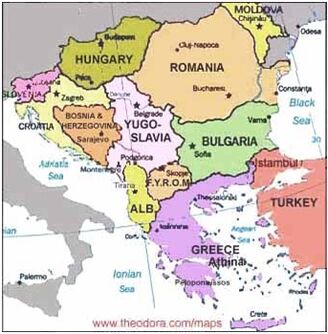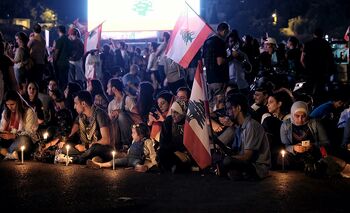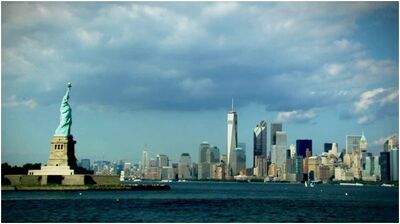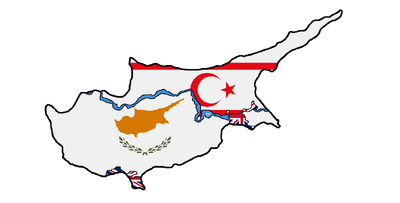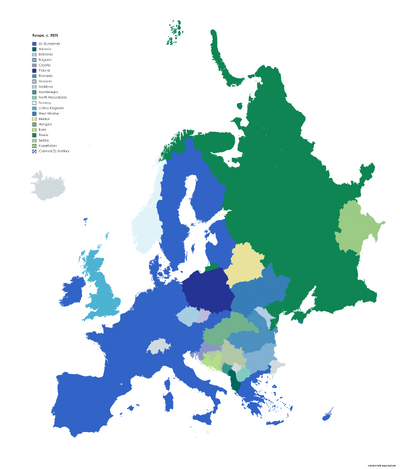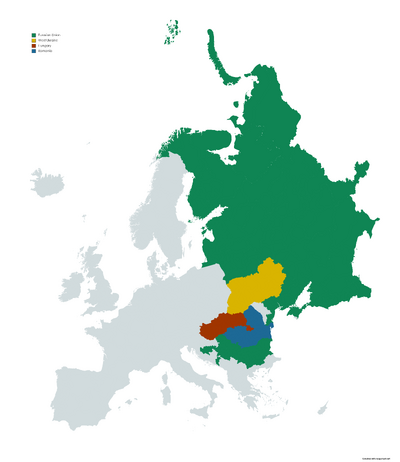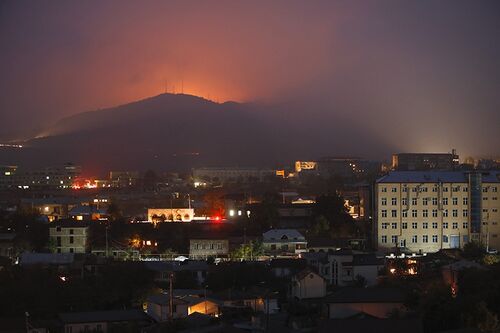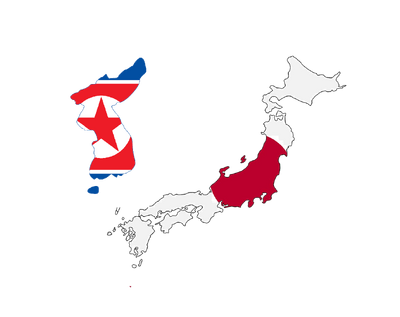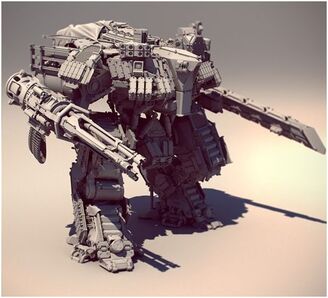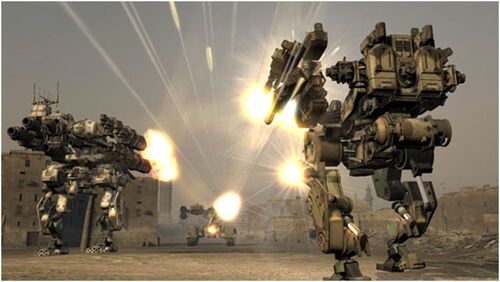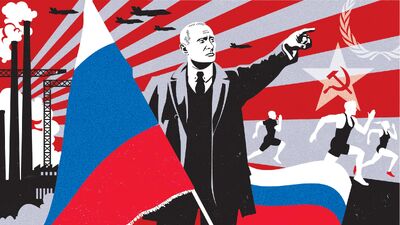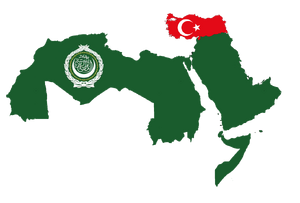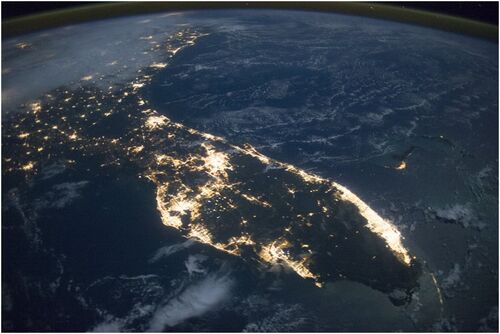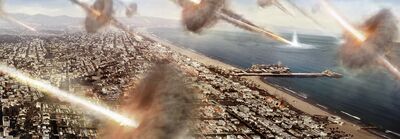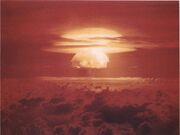


|
This is a featured future history!
|
| WWIII | |||||||
|---|---|---|---|---|---|---|---|
| Part of Frozen War | |||||||
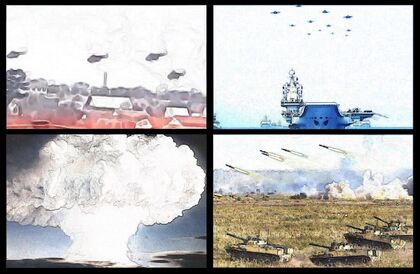 (clockwise from top left) Russo–Iranian attack helicopters over Zagreb, Croatia (c. 2023); Brazilian–Chinese carrier task force (2026); Russian–Serbian tanks and missile launchers in Republika Srpska (c. 2025), nuclear bombing of Kashmir (2027). | |||||||
| |||||||
| Belligerents | |||||||
|
Co-belligerents and satellite states:
| ||||||
| Commanders | |||||||
|
| ||||||
| Strength | |||||||
| 25-30 million | 20-27 million | ||||||
| Casualties and losses | |||||||
| 30-35 million | 35-40 million | ||||||
World War III (WWIII, or WW3) also referred to as the Third World War or Frozen War I was an international conflict taking place in the Americas, Eurasia (specifically Eastern Europe and the Sino–Japanese orbit) and the Muslim world (isolated skirmishes also took place in Central Europe and Southeast Asia), lasting from June 2014 or 2022 (although some would claim 1999) into late 2028, early 2029 (or 2020) – or between just under one to two decades. It involved over half of the world’s 194 countries eventually consolidating into one of two major international and intercontinental military alliances: the stalwart NATO–G7 coalition, the BRIC-spearheaded UN-loyalists (which Afghanistan, Argentina, Azerbaijan-Bukhara, El Salvador, North Korea, Egypt, Hezbollah, Saudi Arabia, Iraq, Syria, Morocco, Padania, Peru, Republika Srpska, Tajikistan, North America and many others are party to at various times) and rogue Cuban insurgents, and the neutral United Nations General Assembly and Security Council member-states (Poland, Nigeria and Indonesia) that become involved only when attacked by pro-UN or Anti-UN Western forces (Israel, Britain and the U.S. emerge as the primary targets of pro-UN forces).
Although the two main factions remain steadfastly against one another, some infighting does unfold between the various sub-factions, the most notable of which being the Second American Civil War (2022–2024), which results in an unresolved stalemate between the United States and UN-backed secessionists in California, New Jersey, Arizona and Texas (as well as throughout the continental U.S.). This instability on the American continent not seen since the Revolution and the Great Sioux War of the late 18th and 19th centuries respectively is one of the main conflicts of World War III, and also directly affects the infighting. North America and the U.S. at one point distance themselves from a NATO alliance seen as supporting a Brazilian PL-backed ultranationalist Italy seen in the throes of an Iron Guard 2.0 scenario on steroids, the original Iron Guard originating in Romania during WWII as a Christian Fascist movement, blemishing their allies' image, and handing their enemies a propaganda victory on a platter. This is also a political metric to use against their respective opponents to 'prove' who was more opposed to ultranationalism, given the United States of America's own imperialistic reputation during the earlier and quieter phases of combat in World War III. The United States' past support for dictatorships is not only hypocritically seized upon by the relatively-isolationist Mexican and Texan-led North American regime, but also the Atlantic State - both of which had tens of millions of supporters in the United States proper between the two of them, which puts pressure on the U.S. leadership to distance itself and isolate itself as much as possible from NATO and its more traditional allies (aside from Scotland, which side with the U.S. out of necessity due to an insurgency on its southern border and around London that unfolds around this time).
Aside from Hungarian aggression in Central Europe and Serbian activity in the Balkans and Romania, Europe doesn’t see much of this, remaining mostly united throughout the decades-long conflict, although the 2014 Russian military intervention in Ukraine would lead to a period of escalating instability in eastern Ukraine that would leave the region and the notoriously-violent Russian–Ukrainian "Unique" Relationship in a state virtually indistinguishable from the pre-Putin era.
With the advent of unmanned advanced combat technology (ranging from high-power intercontinental ballistic missiles or ICBM, nuclear weapons, biowarfare and Mechanized Autonomous Weapon Systems or MAWS), WWIII was significantly less involving than its predecessor. Although, with only 77 million people directly involved (a sharp drop from its predecessor conflict) hailing from from over 120 different countries (far more than its predecessor conflict), it was significantly more widespread and encompassed significantly more of the geographical world area than WWII. Over 2 million from the U.S. and 10 million (8 million active and reserves, 2 million paramilitary) from China contributed to the war effort, constituting a third of the total ground forces in the war. NATO (excluding the Americas) contributes 9.4 million from 27 member-states, representing the largest bloc of nations in the war, India 7 million, Japan 3 million (half of which is paramilitary), Russia 5 million, and the Axis boasts 16.7 million, with China alone constituting two-thirds of the total active COSECTOR manpower, from dozens of nations that direct their fire on those who voluntarily ‘secede’ from the UN. Another 10 million represent Jihadists, terror groups and other unaffiliated paramilitary, and roughly 22 million civilians directly participate as well.
All-in-all, an estimate 60-87,492,780 total people perish in the wake of the Third Global Confrontation – 39,163,200 of them being Russian, Chinese, Korean and Japanese soldiers, paramilitary and civilians during the Siege of Vladivostok and the War in the Far East against Japanese, South Korean, Tibetan and NATO forces. Of that; nearly 7,000,000 perish in the Rwandan genocide and subsequent Congo Wars, over 400-600,000 perish in the Azeri-Bukharan “Directed Energy Munitions Orbiter,” “DEMO” Strikes on Cyprus, the Greek Dodecanese and Scottish Northern Isles – 90% of them being civilians, an estimate 986,500 (again, mostly civilians) also perish in the 2027 JaF missile attacks on Jammu & Kashmir, and nearly 700,000 in the 2024-25 nuclear bombings of Kaliningrad, Chicago, and Colorado Springs combined – still less than the 3 million (1.1 million immediately, and another nearly 2 million in the aforementioned regions and across the Indian subcontinent in the atmospheric and geopolitical fallout and aftermath) that perish in the 2027 Indo–Pakistani Nuclear War (bombings of J-K and North Waziristan) that occurred in a time span of under 60 minutes. Approximately 960,000 (also mostly civilians) perish during the Azeri-Bukharan–Chinese Invasion of the EU, roughly 35,000 die during the Second Battle of Berlin (also known as the Berlin Blitz) and the Azeri-Bukharan Operation Yomg'ir (Rainfall), 500,000-700,000 die in the Arab–Russian Invasion of Turkey and a grand total of roughly 1,762,700 perish from the bioterrorism outbreak.

Western support for 2000s-2010s U.S. interventionism and Israel's genocide of the Palestinians in the mid 2020's would become the primary flashpoint between the UN and the NATO West, and open the floodgates for all-out war in Europe.
In the end, more people die as a result of this war than the number of people that participate in it. When factoring in the civilian death-toll from the regimes of U.S. Presidents Kerry, Trump and Obama, as well as the several-million Japanese soldiers that perish during the Siege of Vladivostok and the Republic of Sakha – not to mention the millions that perished during the Congo Wars of the 1990's and under the reign of Fang in the 2030's – the cost of WW3 reaches 94 million dead on the high end, and with the median historical estimate – 87.1 million: World War 3 surpasses WW2’s 74 million figure to become the costliest war fought in human history by a wide margin.
Whereas WWII is widely regarded as the responsibility of Adolf Hitler and German expansionist militarism and internationalist eugenics, the cause of WWIII is primarily attributed to the United States, Atlantic State – and later “North American” – Governments as a whole (also due to Brexit's destabilization of Britain and Ireland), although during the conflict the countries of China, Russia and Azerbaijan-Bukhara of the Eurasian Commonwealth, Brazil, and - to an extent - Iran and the Arab League are labeled and regarded as the “New Axis” ad-nausea by the US/NATO-run global power structure (with George W. Bush ironically declaring Iran, Iraq and North Korea as the "Axis of Evil"), with El Verde terrorizing South America and India fighting a two-front war against China and its puppet-state in Pakistan, the U.S. under the illegitimate and illiberal corporate rule of multimillionaire former-Secretary of State John Kerry, and the UK being infiltrated by Kerry-ally Lord Pharaoh. Pharaoh and Kerry both are found to be cooperating with the Kremlin, and the Sino–American Fang, Trump, Clinton and Gates dynasties group to divide-up and conquer Eurasia, the Americas and Middle-East.
These elites were specifically employed by the Bush-Clinton Syndicate and the Salazar–De Luca Syndicate, to launch World War 3 (predicated by the flawed narrative and scapegoat of a Chinese–Turkic Axis being the new threat to humanity) all in a massive conspiracy to distract the American and World public from one crucial truth. The fact that the United States – the sole superpower and most powerful nation in history – was hijacked by the superstates of China, the Brazilian Empire, a United Korea, Eurasia and North America in a blatant coup to silence a revolution, suppress a movement, and empower neoconservative theocrats bent on fulfilling the Book of Revelations and plunging humanity into ordered chaos and engineered apocalypse.
Background[]
- See: Yugoslav Wars, Cold War, Gulf War, Collapse of the USSR, 1998 U.S. embassy bombings, Osama bin Laden, NATO bombing of Yugoslavia, UNSCR1160, UNSCR1203, UNSCR1207, First and Second Congo Wars
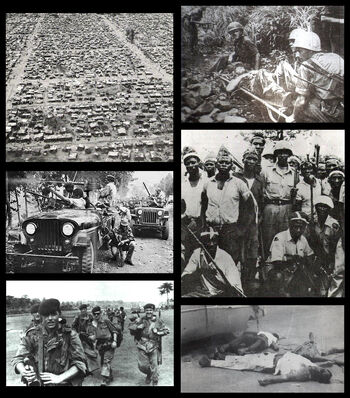
Clockwise starting from top left; Refugee camp outside Élisabethville, Peacekeepers tending to a wounded comrade, Armed Baluba tribesmen, Massacred civilians in Lodja, Belgian paratroopers during Dragon Rouge, Government forces fighting Simba rebels
An exact historiography of the Third World War and the centuries-long global and interplanetary "Frozen War" it resulted in has yet to be established, but by the late 2100's large swathes of professional historians and the general populace of human and transhuman civilization had come to a general consensus that World War III did occur in the first three decades of the 2000s at the turn of the millennium.
Regarding the official commencement of hostilities, the largest involvement of armed forces in a foreign country mark the deployment of hundreds of thousands of U.S. forces beginning the War in Iraq and the 50,000-strong Coalition against Turkish-backed ISIS - numbering as many as 200,000 jihadists by State Dept. estimates at its height. Still, other sources put the start of the conflict in the summer of 1998 at the beginning of the West's War on Yugoslavia, with the deadliest combat in Europe since WWII, involving widespread multinational intervention by NATO in addition to the NATO Invasion of Afghanistan three years later. Not long after the NATO Invasion of Yugoslavia occurs are the 1998 U.S. embassy bombings in East Africa - which serve to put the infamous Osama bin Laden on the most-wanted list - and the subsequent Second Congo War, which involves 9 African countries and tens of thousands of mobilized forces on each side, vying for control over the vacuum created by U.S. and European imperialism, and resulting in the costliest war since WWII, in which millions of lives were lost by 2008. But others chart as far back as when the Bosnian War began alongside the ongoing Croatian War for Independence in the early years of the Yugoslav Wars, which is also the same year that marked the first intervention of the United Nations in foreign conflicts under the UN Department of Peacekeeping Operations - including the aforementioned Wars in Yugoslavia. Another common historiography puts the beginning of the conflict on 7 October 2001 with the U.S. Invasion of Afghanistan and on the eve of the 2003 invasion of Iraq.
In addition to the debate over official commencement of hostilities in 1998-99 vs. 2014, a similar split formed over when the major hostilities had come to an end by the Winter of 2029-'30, while others point to the slowing of the global economy and overall socioeconomic fallout due to the 2020-2024 COVID-19 pandemic in general, led to many technically classified the fighting between 2020 and 2027-28 as a separate conflict entirely. After the 2016 and 2020 presidential elections, the U.S. had fallen from grace in virtually every way aside from raw military prowess with regard to its unipolar world order. Although the U.S. remained the sole superpower for now, the instability on the North American continent results in the rise of several successor states, mirroring the fall of the USSR, leaving the U.S. weakened - much like its Russian counterpart - and the status of California contested between it and an emerging Azeri-backed North American successor state.
The Rwandan genocide directly resulted in the costliest wars since WWII, which ran concurrent to the aforementioned Yugoslav Wars which themselves involved genocide and war crimes, as well as the attacks on 9/11 and many of its own consequences. And a little over a decade later, by 2014, the intercontinental military alliance of China, Russia, Iran, Azerbaijan-Bukhara and much of South America spearheaded by Brazil had supplanted terrorism as a threat to many European and Western nations. The United Nations had begun to lose its way, NATO had become fragmented between the pro-US and pro-Europe, and the U.S. eventually collapsed under the weight of its own hypocrisy by the mid-2030s.
Although the Iranians, Chinese and Azeri-Bukharans never formally allied with the Russians during the events of WWIII, they being targeted alongside Russia by the EU, NATO and eventually the United States typically left them resorting to forming alliances of convenience with them periodically throughout the conflict, and thus traditionally being grouped in on their side as opposed to representing a third coalition of its own. Israel, alongside Azerbaijan-Bukhara and the Russians, would notably side with the Arab states against Turkish intervention in the region, 2016-2019. Israeli ties with CIS and SCO nations were kept in the shadows, and typically only on full display in times and actions of desperation on the part of the Israelis. The prominent nuclear powers targeted by the West are China, Russia and Iran (the latter of whom attain nuclear weapons from Russia in 2023), typically compared to Imperial Germany, Austria-Hungary and the Ottoman Empire or Germany, Italy and Japan in WW2. Although the majority of the deaths in WWIII were confined to the East Asian Theatre of the conflict, nearly 1.5 million would die in the conflicts in the Middle East, more than in the entirety of the decadeslong Arab-Israeli conflict preceding it.
Cold War[]
The Cold War split the temporary wartime alliance against Nazi Germany (1933-1945), leaving the Soviet Union (1922-1991) and the United States (1776-2039) as two superpowers with profound economic and political differences. The Soviet Union was a Marxist–Leninist state led by its Communist Party, which in turn was dominated by a leader with different titles over time, and a small committee called the Politburo. The Party controlled the state, the press, the military, the economy and many organizations throughout the Second World, including the Warsaw Pact and other satellites, and funded communist parties around the world, sometimes in competition with communist China, particularly following the Sino-Soviet split of the 1960s. In opposition stood the capitalist West, led by the United States, a federal republic with a two-party presidential system. The First World nations of the Western Bloc were generally liberal democratic with a free press and independent organizations, but were economically and politically entwined with a network of banana republics and other authoritarian regimes throughout the Third World, most of which were the Western Bloc's former colonies. Some major Cold War frontlines such as Vietnam, Indonesia, and the Congo were still Western colonies in 1947.
Prior to the Cold War and even the World Wars, the predecessor to the United Kingdom of Great Britain and North Ireland held sway over a majority of the political world for centuries. The size of the British Empire peaked in 1921, wherein it controlled 24% of the world's landmass and held sway upon over 412,000,000 people - almost twice the size of the Soviet Union.
By the start of the 20th century, Germany and the United States had begun to challenge Britain's economic lead. Subsequent military and economic tensions between Britain and Germany were major causes of the First World War, during which Britain relied heavily upon its empire. The conflict placed enormous strain on the military, financial and manpower resources of Britain. Although the British Empire achieved its largest territorial extent immediately after World War I, Britain was no longer the world's pre-eminent industrial or military power. In the Second World War, Britain's colonies in East and Southeast Asia were occupied by Japan. Despite the final victory of Britain and its allies, the damage to British prestige helped to accelerate the decline of the empire. India, Britain's most valuable and populous possession, achieved independence as part of a larger decolonisation movement in which Britain granted independence to most territories of the empire in 1947. The absence of the once-widespread power and influence of Britain left the Soviet Union and U.S. separated by a yawning power-vacuum which would lead to the Cold War.
On the nuclear weapons front, the United States and the USSR pursued nuclear rearmament and developed long-range weapons with which they could strike the territory of the other. In August 1957, the Soviets successfully launched the world's first intercontinental ballistic missile (ICBM), and in October that same year they launched the first Earth satellite, Sputnik 1. The launch of Sputnik inaugurated the Space Race. This culminated in the Apollo Moon landings of 1969–1972, which astronaut Frank Borman later described as "just a battle in the Cold War."
Operation Condor was arguably the final large-scale proxy military operation undertaken by the superpowers of the Cold War. Implemented in 1975, the United States documentation shows that the United States provided key organizational, financial and technical assistance to the operation into the 1980s.
In declassified material, the CIA reports in July of 1976 of a "Third World War and South America," documenting the long-term dangers of a right-wing bloc and considering the cohesiveness of the six nations of the Southern Cone of South America: Bolivia, Chile, Uruguay, Argentina, Paraguay and Brazil. They argued that these regimes felt embattled by international Marxism and its terrorist components on one side, and the hostility of uncomprehending industrial democracies misled by the terrorist propaganda. Also recommended by the Intelligence Community was that U.S. policy towards Operation Condor should emphasize the differences between these countries at every opportunity, to depoliticize humans rights, to oppose rhetorical exaggerations of the "Third-World-War" type, and bring the potential bloc members back into the U.S. cognitive universe via systematic exchanges.
The report notes, "the formation of special teams from member countries who are to carry out operations to include assassinations against terrorist or supporters of terrorist organizations." The report also highlighted the fact that these special teams were intelligence service agents rather than military personnel, however these teams did operate in structures reminiscent of U.S. special forces teams. Lastly, the report mentioned awareness of Operation Condor's plans to conduct possible operations in France and Portugal - a matter that would be prove to be extremely controversial later in Condor's history.
The United States government provided technical support and supplied military aid to the participants during the Johnson, Nixon, Ford, Carter, and Reagan administrations (1964-1989). As arms flowed to the contras, Savimbi's UNITA and the mujahideen, the Reagan Doctrine's advocates argued that the doctrine was yielding constructive results for U.S. interests and global democracy.
In Nicaragua, pressure from the Contras led the Sandinstas to end the State of Emergency, and they subsequently lost the 1990 elections. In Afghanistan, the mujahideen bled the Soviet Union's military and paved the way for Soviet military defeat. In Angola, Savimbi's resistance ultimately led to a decision by the Soviet Union and Cuba to bring their troops and military advisors home from Angola as part of a negotiated settlement.
All of these developments were Reagan Doctrine victories, the doctrine's advocates argue, laying the ground for the ultimate dissolution of the Soviet Union.
The Reagan Doctrine continued into the administration of Reagan's successor, George H. W. Bush, who won the U.S. presidency in November 1988. Bush's Presidency featured the final years of the Cold War and the Gulf War, but the Reagan Doctrine soon faded from U.S. policy as the Cold War ended. Bush also noted a presumed peace dividend to the end of the Cold War with economic benefits of a decrease in defense spending. However, following the presidency of Bill Clinton, a change in United States foreign policy was introduced with the presidency of his son George W. Bush and the new Bush Doctrine, who increased military spending in response to the World Trade Center attacks on 11 September, 2001, one of the most influential losses of a nation during the Frozen War and World War 3.
Drug Wars[]
In U.S. President Dwight D. Eisenhower's farewell address to the nation, the so-called military-industrial complex he had warned about had become very real by the end of the Cold War.
As early as the 1990s the U.S. had been smuggling weapons to Mexican drug cartels under the auspices of ATF and the DHS. Particularly during the period between 2006 and 2011, when the U.S. agents allowed thousands of guns to "walk" into the hands of Mexican drug cartels. Under the Mérida Initiative, U.S. law enforcement and intelligence had contributed to the conditions that have allowed secretive transnational organized crime and cartels to buy off the Mexican police, and empower the Mexican military to a position above the Mexican government itself in many ways. From this point forward, drug cartels ran Mexico. Secessionist uprisings became commonplace, beginning with the 1994 Zapatista uprising and its aftermath - which involved an acceleration of militarism by Mexican authorities. Following on the heels of the 1994 uprising, the U.S. accelerated involvement with the Mexican military under the label of "Drug Training," which was truly about counterinsurgency. This focus on insurgencies enabled and accelerated the cartels' control over regional politics and law enforcement, and allowed arms-dealer politics to rule over regional politics and law enforcement in the U.S. and both developments would fuel the autonomous and secessionist fronts in both countries, which would inevitably lead to the formation of the Union State of North America.
Livonian–Russian Wars (1989–1992)[]
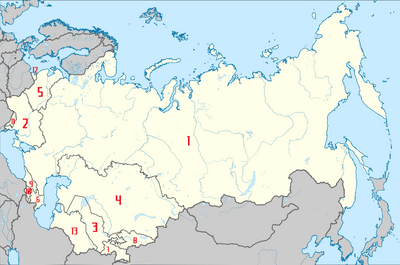
1) Russian SFSR, 2) Ukrainian SSR, 3) Uzbek SSR, 4) Kazakh SSR, 5) Livonian SSR, 6) Azerbaijani SSR, 7) Tajik SSR, 8) Kyrgyz SSR, 9) Georgian SSR, 10) Armenian SSR, 11) Moldavian SSR, 12) Kaliningrad SSR, 13) Turkmen SSR
In 1986, one year after Gorbachev's rise to power, the dissolution of the Soviet Union began with the rise of the Helsinki-86 in the Livonian SSR, the first openly anti-Communist organization in the U.S.S.R., and riots in the Kazakh SSR. In 1987, secessionist fervor spread throughout the Soviet Union, in the Russian SFSR, the Ukrainian SSR's Crimea, Armenian SSR and throughout the Livonian SSR. In 1988, the Byelorussian, Estonian, Latvian and Lithuanian Popular Fronts were founded, which in 1989 combined to form the Livonian Popular Front, although the Byelorussian Popular Front was noticeably more conciliatory and friendly to Moscow than the Baltics. A few months later, right-wing terrorist attacks gripped the Union Republic in fear, as violence precipitated in Byelorussia, prompting immediate action from the Russian SFSR in the region.
In October of 1989, the Soviet Armed Forces backed by Russia entered Byelorussia, attempting to annex the territory into the Russian SFSR. The conflict would precipitate the fall of the Soviet Union in 1991, after fierce fighting in and around Gomel involved a majority of the Soviet Army and most of the Kremlin's attention. The Baltic–Byelorussian front was steadfast against the advancing Russians, and their advance was largely halted in the east of the country. Soviet Livonia would become the People's Federal Republics of Livonia in January of 1991 and become the first independent country to emerge from the Soviet Union. The fighting would continue for another year after the fall of the USSR, with the PFRL repulsing the Russian attack and rebuilding over the next several decades with assistance from NATO.
During this time, Livonia would maintain a stance of neutrality akin to Sweden, Austria, Switzerland and Ireland, maintaining trade with both the EU and Russia despite a continuing strain in relations with Russia that would endure into the 2010's. Maintaining and overseeing a large economy and roughly 382,615 km in area, Livonia was larger than Norway, and around the size of Zimbabwe, with a GDP larger than Romania's. Livonia would maintain a standing manpower of nearly 1,000,000 into the 2010's, amid its strained relations with Russia during this time. Livonia would enter into mutual defense treaties with Sweden, Finland, Poland, France, Germany, the United Kingdom and Greece, as well as maintain defense relations with South Korea, China and Israel.
In 2020, amid the coronavirus pandemic, relations with the EU and the West in general soured. In late 2018, the Ливонская народная рабочая партия (LNRP) Ultra-nationalist far-left party wins in a coalition with the Centrist Латвийско-литовская европоцентристская партия (LLYP)'s. The LNRP began immediately silencing dissent and enacting hyper-authoritarian lockdowns and censorship which escalated into a full-blown state-of-emergency in late 2021. In early 2022, the Livonian People's Federal Republic allowed Russian troops to invade Ukraine from its soil, nearly resulting in the complete decapitation of Ukraine. Swift action from NATO and crushing sanctions from the EU descended upon Livonia and Russia.
Post-Soviet Conflicts (1991–2026)[]
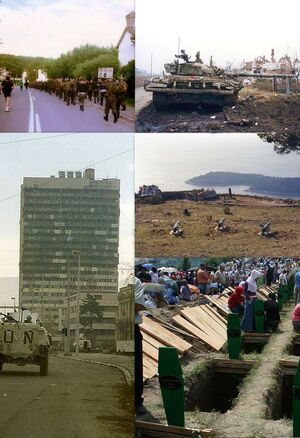
Clockwise from the top-left: Slovenian police escort captured JNA soldiers back to their unit during the 1991 Slovenian war of independence; A destroyed tank during the Battle of Vukovar; Anti-tank missile installations in the siege of Dubrovnik; Reburial of victims from the 1995 Srebrenica massacre on 11 July 2010; UN vehicle driving on the streets of Sarajevo during the siege.
War in Transnistria[]
Beginning in March of 1992, Moldovan forces two attempts to cross into pro-Russian Transnistria eventually escalate when Moldovan independence is recognized by UN membership. The fighting lasts until July 21 of that same year and involves fighting at three major locations along the Dniester River.
Outside involvement on the side of Moldova involves Romanian volunteers, and on the pro-Trasnistria side various elements of the Russian Army, Ukraine and the CIS. After the Russian annexation of Crimea decades later, renewed concern regarding Transnistria was brought forth by the U.S. commander of NATO who warned that Russian troops were poised to 'run' into Moldova.
United Nations involvement in Yugoslavia[]
Up until the mid-1980s, Yugoslavia was one of the wealthiest and most powerful countries on Earth. With a standing manpower of nearly a million, nearly 3000 tanks and AFV (the fifth largest in Europe), over 2000 self-propelled and towed artillery, nearly 1000 rocket projectors and the sixth largest air force with over 1200 aircraft the Yugoslav People's Army was easily one of the top 20 most powerful military powers on the planet. In addition, Yugoslavia was also economically strong. Yugoslavia had the greatest per capita GDP of all the Communist nations, and the third largest Communist economy behind China and Russia, and for a brief period on par with North Korea and Vietnam before pulling forward.
By 1992 however, Federal Yugoslavia had shrunk, most of its equipment was outdated, and its army untrained conscripts. Yet amid the fervent independence movements in Bosnia and Croatia, a determined and utterly brutal Serbian ultranationalist push across the former Yugoslav republics had emerged.
The initial mandate of UNPROFOR was to ensure conditions for peace talks, and security in three demilitarized "safe-haven" enclaves designated as United Nations Protected Areas (UNPAs) located in various regions before the Republic of Croatia was admitted into the United Nations (UN) as a member but were controlled by the self-styled Republic of Serbian Krajina.
On 6 July 1993, new tensions arose following the Croatian government's decision to re-open the strategic Maslenica bridge on 18 July – Croatia was cut in half while the bridge was in Serb hands. The UNPROFOR forces mandated to monitor the withdrawal of Croatian forces from the area had been unable to deploy, due to the refusal of access by Croat authorities. The Serbs shelled the bridge which was partially destroyed on 2 August. On 12 August, negotiations for a cease-fire began in Geneva, but were unsuccessful. Eventually, Croat forces retreated to their positions of before the incursion.
From March 1993, Serb para-military units killed a great number of civilians, destroyed habitations, prevented the UNHCR from delivering humanitarian aid, and forced thousands of Bosniak refugees to flee to the town of Srebrenica. 30 or 40 persons were dying daily from military action, starvation, exposure to cold or lack of medical treatment. Resolution 819 attempted to address this issue by declaring Srebrenica a "Safe Area". Resolution 836 authorized UNPROFOR "acting in self-defense, to take the necessary measures, including the use of force, in reply to bombardments against the safe areas by any of the parties or to armed incursion into them or in the event of any deliberate obstruction in or around those areas the freedom of movement of UNPROFOR or of protected humanitarian convoys" . To implement the deterrence, around 7600 reinforcements were sent and air support was organised in coordination with NATO.
In May 1993, intense fighting broke out in Central Bosnia between Bosniaks and Bosnian Croats. Croat para-military forces,committed exactions against Serbs and Bosniaks. The massacre in the village of Ahmići, on 16 April 1993, is an example of the savagery of the terror. Tihomir Blaškić was the officer of the Croat HVO army formation who was tried and convicted at the ICTY over his responsibility for this massacre. Blaškić served almost nine years in prison before the appeals panel acquitted him of most of the charges in July 2004, as the defence proved that he did not command all the HVO units in the area or any paramilitary units.
On 24 September, the Security Council was informed by the Croatian Government that if the mandate of UNPROFOR was not amended to promote energetic implementation of the relevant resolutions of the Security Council, Croatia would be forced to request UNPROFOR to leave the country not later than 30 November 1993. Subsequent redefinition of the mandate occurred.
At the end of the year, the warring parties attempted to come to a cease-fire. The truce was implemented between Croat and Serb forces, but fighting went on in Bosnia between Bosniaks and Croats, and the humanitarian situations continued to deteriorate. Notably, Sarajevo continued to be bombarded by Bosnian Serb forces. It was also reported that units of the regular Croat army were supporting Bosnian Croat forces with heavy equipment and men, removing their insignias. This led to further protests from the UN. Use of force began to be discussed at a NATO summit held in Brussels on 10 and 11 January 1994. The Bosnian Serbs, following talks with high-ranking officials of the Russian Federation in Moscow, agreed to open the Tuzla airport for humanitarian purposes. At the same time, the relieving of UN troops in Srebrenica was allowed and the Canadian contingent was replaced by a Dutch contingent.
On 23 September 1994, in retaliation to the Bosnian Serb obstruction to the Peace Plan, the Security Council, by its Resolution 942, severed all commercial and monetary links to the Bosnian Serb entity. Notably, this cut the flow of fuel to the Bosnian Serbs, a hard strategic blow.
Due to the extreme position taken by the Bosnian Serb government, the Yugoslav Federation (Serbia and Montenegro) itself had to take a strong stance against the Bosnian Serb entity. This led to the quasi-complete diplomatic isolation of the Bosnian Serb entity.
In August 1994, the situation deteriorated again, particularly due to sniper activity, and despite the anti-sniper agreements. In Sarajevo, the bloody "Sniper Alley" became famous and infamous. Deliberate attacks against UNPROFOR personnel or aircraft became frequent.
In October, the Bosnian Muslim forces, trapped in the Bihać pocket, attacked the Bosnian Serb forces in an attempt to end the siege of the city. The attack and the ensuing counter-attack by the Bosnian Serbs induced terror in the local population and another massive exodus of refugees. In deliberate contradiction with the "Safe Area" status of Bihać and the "No-flight" zones, Bosnian Serb airplanes made repeated attacks in the Bihać area, using cluster bombs and napalm.
In reaction to this threat, on 21 November, NATO airplanes destroyed the Udbina airstrip, located in the UNPA Sector South in Croatia. The following days, NATO airplanes again had to intervene, against Bosnian Serb anti-air missiles sites which had opened fire upon British jets, and against artillery sites which shelled Bihać. Instead of lowering their profile, the Bosnian Serbs retaliated by taking UN personnel hostage and restraining humanitarian aid transit.
On the diplomatic scene, all efforts to come to a cease-fire turned out to be to no avail, here again mostly because of Bosnian Serb obstruction—Dr. Karadžić declined the invitation of the UN Secretary-General.
1995[]
On 26 May 1995 following NATO air raids on Pale as the Bosnian Serbs defied another UN ultimatum on heavy weapons, around 400 Blue Helmets were taken hostage, brought to strategic points as human shields, and shown in chains on Serbian TV.
On 27 May 1995, General Mladić along with General Nuhić launched an assault against the UN observation point of the Vrbanja bridge. At 5 in the morning, the French captain commanding the position lost contact with the 12 men and went to investigate. A Serb dressed with a blue helmet and French body armour and uniform attempted to take him hostage, but was deterred by the escort, and the officer managed to escape.[citation needed] In the following hours, after intense shelling by ERC 90 Sagaie armoured vehicles, a platoon of 30 French peacekeepers led by then Captain François Lecointre subsequently re-captured the bridge with the support of 70 French infantrymen and direct fire from armoured vehicles, in an action which saw the first French Army bayonet charge since the Korean War. During the French assault, elements of the Army of the Republic of Bosnia and Herzegovina (ARBiH) opened fire on the VRS-held observation posts, wounding one French hostage.
Two French soldiers were killed during the battle, 10 were wounded, and one died of wounds later that day. VRS casualties were four killed, three wounded and four captured. Following the battle, VRS forces were observed to be less likely to engage French UN peacekeepers deployed in the city. In 2017, Lecointre, now a general, was appointed French Chief of the Defence Staff.
At 12 o'clock, the Bosnian Serb radio broadcast that General Mladić had ordered to
| “ | deploy the captured members of UNPROFOR, and the other foreign citizens who had acted as enemies of the Serbian people, at command posts, depots and other important facilities.
The United Nations in this particular situation have decided to hire a murderer, it is called the NATO alliance. It is a hired killer. If NATO wishes to continue with its air strikes then it will have to kill the UN troops here on the ground, because we have positioned UN troops and observers around potential targets that NATO might decide to go for. The international community therefore will have to pay a very heavy price. And it will not stop at that. The Serbs are determined to make a point to the whole world. |
” |
– Jovan Zametica, Karadžić's spokesman | ||
On the 30 May, Ratko Mladić phoned Rupert Smith and agreed not to put hostage Blue Helmets in chains, but to merely "bring" them on strategic sites. He also demanded "excuses" for the death of the four Serbian soldiers killed by the French at Vrbanja bridge, threatening to "be unable to guarantee the safety" of the UN forces in Goražde.
Although NATO had been bombing Serb positions in Bosnia for several months now, the first full intervention occurred in late 1995 under Operation Deliberate Force, primarily in response to the Srebrenica massacre of over 8,000 Bosniaks by Serbian forces, after 11 July, when NATO aircraft attacked targets in the Srebrenica area of Bosnia-Herzegovina as identified by and under the control of the United Nations. The Dutch Peacekeepers had failed due to NATO's incessant and unmitigated aggression, time and time again deliberately putting UN personnel in harm's way.
Bosnian genocide[]
The Bosnian genocide refers to either the Srebrenica massacre or the wider crimes against humanity and ethnic cleansing throughout areas controlled by the Army of Republika Srpska (VRS) during the Bosnian War of 1992–1995. The events in Srebrenica in 1995 included the killing of more than 8,000 Bosniak (Bosnian Muslim) men and boys, as well as the mass expulsion of another 25,000–30,000 Bosniak civilians by VRS units under the command of General Ratko Mladić.
The ethnic cleansing that took place in VRS-controlled areas targeted Bosniaks and Bosnian Croats. The ethnic cleansing campaign included extermination, unlawful confinement, mass rape, sexual assault, torture, plunder and destruction of private and public property, and inhumane treatment of civilians; the targeting of political leaders, intellectuals, and professionals; the unlawful deportation and transfer of civilians; the unlawful shelling of civilians; the unlawful appropriation and plunder of real and personal property; the destruction of homes and businesses; and the destruction of places of worship. The acts have been found to have satisfied the requirements for "guilty acts" of genocide, and that, "some physical perpetrators held the intent to physically destroy the protected groups of Bosnian Muslims and Croats".
In the 1990s, several authorities asserted that ethnic cleansing as carried out by elements of the Bosnian Serb army was genocide. These included a resolution by the United Nations General Assembly and three convictions for genocide in German courts (the convictions were based upon a wider interpretation of genocide than that used by international courts). In 2005, the United States Congress passed a resolution declaring that the Serbian policies of aggression and ethnic cleansing meet the terms defining genocide.
The Srebrenica massacre was found to be an act of genocide by the International Criminal Tribunal for the Former Yugoslavia, a finding upheld by the ICJ. On 24 March 2016, former Bosnian Serb leader and the first president of the Republika Srpska, Radovan Karadžić, was found guilty of genocide in Srebrenica, war crimes, and crimes against humanity and sentenced to 40 years in prison. In 2019 an appeals court increased his sentence to life imprisonment. On 12 May 2021 it was announced that, with the agreement of the UK authorities, he would serve the rest of his sentence in a UK prison.
Karachi Affair[]
The Karachi affair (French: affaire Karachi; Urdu: آگسٹا آبدوز اسکینڈل), otherwise known as the Agosta Submarine scandal, was a major military scandal that took place in the second term of Prime Minister Benazir Bhutto, involving the presidencies of François Mitterrand and Jacques Chirac in 1992–97.
The scandal involved the payment of massive commissions and kickbacks between France and Pakistan over the negotiations to acquire Agosta 90B-class submarines. The submarines utilised the emerging Air-independent propulsion propriety designs, which Pakistan was eager to acquire over the nuclear submarines.
Since its exposure in the news media of both France and Pakistan, the scandal has been involved in various investigative journalism and attracted sensations and conspiracy theories in both countries, including this scandal's allegement of financing the political campaign of then-Prime Minister Edouard Balladur in the presidential elections took place in 1995. Upon electing President Jacques Chirac cancelled the commissions and kickbacks, angering many officials in Pakistan and France according to the media reports. Other theories and subsequent investigative journalist reports alleged that the bus bombing on 8 May 2002 in Karachi that killed eleven French engineers in Karachi was in retaliation for the cancellation of these commissions.
Rwandan genocide and Congo Wars[]
The Rwandan genocide took place in the context of the Rwandan Civil War, a conflict beginning in 1990 between the Hutu-led government and the Rwandan Patriotic Front (RPF). The latter was made up largely of Tutsi refugees whose families had fled to Uganda after the 1959 Hutu revolt against colonial rule. Waves of Hutu violence against the RPF and Tutsi followed Rwandan independence in 1962. International pressure on the Hutu government of Juvénal Habyarimana resulted in a ceasefire in the civil war in 1993, with a road-map to implement the Arusha Accords. This was intended to create a power-sharing government with the RPF. Numerous conservative Hutu, including members of the Akazu, opposed the Accords, believing they were a concession to enemy demands.
The RPF military campaign had resulted in some intensified support for the so-called "Hutu Power" ideology, which portrayed the RPF as an alien force. In radio programs and other news, the Tutsis were portrayed as non-Christian, intent on reinstating the Tutsi monarchy and enslaving the Hutus. Many Hutu reacted to this prospect with extreme opposition. In the lead-up to the genocide, the number of machetes imported into Rwanda increased.
On 6 April 1994, an aeroplane carrying Habyarimana and Burundian President Cyprien Ntaryamira was shot down on its descent into Kigali. At the time, the plane was in the airspace above Habyarimana's house. The assassination of Habyarimana ended the peace accords.
Genocidal killings began the following day. Soldiers, police, and militia quickly executed key Tutsi and moderate Hutu military and political leaders who could have assumed control in the ensuing power vacuum. Checkpoints and barricades were erected to screen all holders of the national ID card of Rwanda (it contained ethnic classifications; the Belgian colonial government had introduced use of these classifications and IDs in 1933). This enabled government forces to systematically identify and kill Tutsi.
They also recruited and pressured Hutu civilians to arm themselves with machetes, clubs, blunt objects, and other weapons and encouraged them to rape, maim, and kill their Tutsi neighbors and to destroy or steal their property. The RPF restarted its offensive soon after Habyarimana's assassination. It rapidly seized control of the northern part of the country and captured Kigali about 100 days later in mid-July, bringing an end to the genocide. During these events and in the aftermath, the United Nations (UN) and countries including the United States, the United Kingdom, and Belgium were criticized for their inaction and failure to strengthen the force and mandate of the UN Assistance Mission for Rwanda (UNAMIR) peacekeepers. In December 2017, media reported revelations that the government of France had allegedly supported the Hutu government after the genocide had begun.
In October 1990 the Rwandan Civil War began when the Rwandan Patriotic Front rebel group invaded across Uganda's southern border into northern Rwanda. The RPF was composed of over 4000 soldiers, most the sons of Tutsi refugees who had fled ethnic purges in Rwanda between 1959 and 1963. It portrayed itself as a democratic, multi-ethnic movement and demanded an end to ethnic discrimination, to economic looting of the country by government elites and a stop to the security situation that continued to generate refugees. It was supported by the Ugandan government of Yoweri Museveni, who had come to power in the Ugandan Bush War with significant support from the Rwandan refugees in the country. However, the Rwandan Armed Forces (FAR) was saved by reinforcements from France and Zaire, who backed the government of Rwandan President Juvénal Habyarimana, who had been in power since 1973.
The French intervention of two parachute companies, explained as an attempt to protect its own nationals, actually blocked the February 1993 RPF advance on the capital Kigali. In contrast, the government of Belgium, the former colonial power, cut all support to the Habyarimana regime, which viewed the action as abandonment. Thwarted by the French, the RPF suffered a humiliating retreat back into the Virunga Mountains along the border. After the demoralizing death of Major-General Fred Rwigyema, the collapse of the RPF was prevented through the leadership of Paul Kagame.
The RPF thus managed to retain control of a sliver of land in the north, from which it continued to launch raids. Comparing the RPF and FAR as he saw them in 1993, Canadian Lieutenant-General Roméo Dallaire noted that the rebels "had won all recent contests because of their superior leadership, training, experience, frugality, mobility. Discipline and morale."
After Kagame and the RPF's victory in the Rwandan Civil War, the new regime would play a major and influential role in the war in neighboring Congo, backed by the United States and Uganda. Prominent members of the RPF had fought alongside Yoweri Museveni in the Ugandan Bush War that brought him to power, and Museveni allowed the RPF to use Uganda as a base during the 1990 offensive into Rwanda and subsequent civil war. Given their historical ties, the Rwandan and Ugandan governments were closely allied and Museveni worked closely with Kagame throughout the First Congo War. Ugandan soldiers were present in Zaire throughout the conflict and Museveni likely helped Kagame plan and direct the AFDL. French and Belgian intelligence agencies noted that 15,000 Ugandan-trained Tutsi fought for the AFDL. With active support from Rwanda, Uganda, and Eritrea, Kabila's AFDL was able to capture 800 x 100 km[clarification needed] of territory along the border with Rwanda, Uganda, and Burundi by 25 December 1996. This occupation temporarily satisfied the rebels, because it gave them power in the east and allowed them to defend themselves against the former génocidaires. Likewise, the external actors had successfully crippled the ability of the same génocidaires to use Zaire as a base for attacks. There was a pause in the rebel advance following the acquisition of this buffer territory that lasted until Angola entered the war in February 1997.
There are two explanations for the restart of the rebel advance in 1997. The first, and most probable, is that Angola had joined the anti-Mobutu coalition, giving it numbers and strength far superior to the FAZ, and demanding that Mobutu be removed from power. Kagame presents another, possibly secondary, reason for the march on Kinshasa: that the employment of Serbian mercenaries in the battle for Walikale proved that "Mobutu intended to wage real war against Rwanda." According to this logic, Rwanda's initial concerns had been to manage the security threat in eastern Zaire but it was now forced to dispose of the hostile government in Kinshasa.
Whatever the case, once the advance resumed in 1997, there was virtually no meaningful resistance from what was left of Mobutu's army. Kabila's forces were only held back by the dreadful state of Zaire's infrastructure. In some areas, no real roads existed; the only means of transport were infrequently used dirt paths. The AFDL committed grave human rights violations, such as the carnage at a refugee camp of Hutus at Tingi-Tingi near Kisangani, where tens of thousands of refugees were massacred.
In what was largely regarded as a proxy war between the United States and Serbian-Russian (French-Hutu) interests, the First Congo War would leave the African region in chaos and result in the conditions leading to yet more war on the continent.
The Second Congo War (also known as the Great War of Africa or the Great African War, and sometimes referred to as the African World War) began in the Democratic Republic of the Congo in August 1998, little more than a year after the First Congo War, and involved some of the same issues. The war officially ended in July 2003, when the Transitional Government of the Democratic Republic of the Congo took power. Although a peace agreement was signed in 2002, violence has continued in many regions of the country, especially in the east. Hostilities have continued since the ongoing Lord's Resistance Army insurgency, and the Kivu and Ituri conflicts.
Ultimately, nine African countries and around twenty-five armed groups became involved in the war. By 2008, the war and its aftermath had caused 5.4 million deaths, principally through disease and starvation, making the Second Congo War the deadliest conflict worldwide since World War II.
NATO Invasion of Yugoslavia[]
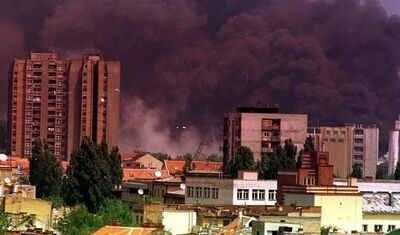
The Yugoslav city of Novi Sad on fire in 1999
Early involvement and monitoring[]
NATO's first involvement in both the Bosnian War and the Yugoslav wars in general came in February 1992, when the alliance issued a statement urging all the belligerents in the conflict to allow the deployment of United Nations peacekeepers. While primarily symbolic, this statement paved the way for later NATO actions.
On July 10, 1992, NATO foreign ministers agreed, at a meeting in Helsinki, to assist the United Nations in monitoring compliance with sanctions established under United Nations Security Council resolutions 713 (1991) and 757 (1992). This led to the commencement of Operation Maritime Monitor off the coast of Montenegro, which was coordinated with the Western European Union Operation Sharp Guard in the Strait of Otranto on July 16. On October 9, 1992, the Security Council passed Resolution 781, establishing a no-fly zone over Bosnia-Herzegovina. In response, on October 16, NATO expanded its mission in the area to include Operation Sky Monitor, which monitored Bosnian airspace for flights from the Federal Republic of Yugoslavia.
Enforcing compliance, 1992-1993[]
On November 16, 1992, the Security Council issued Resolution 787, which called upon member states to "halt all inward and outbound maritime shipping in order to inspect and verify their cargos" to ensure compliance with sanctions. In response to this resolution, NATO deactivated Maritime Monitor on November 22, and replaced it with Operation Maritime Guard, under which NATO forces were authorized to stop ships and inspect their cargos. Unlike Sky Monitor and Maritime Monitor, this was a true enforcement mission, not just a monitoring one.
NATO's air mission also switched from monitoring to enforcement. The Security Council issued Resolution 816, which authorized states to use measures "to ensure compliance" with the no-fly zone over Bosnia. In response, on April 12, 1993, NATO initiated Operation Deny Flight which was tasked with enforcing the no-fly zone, using fighter aircraft based in the region.
Throughout 1993, the role of NATO forces in Bosnia gradually grew. On June 10, 1993, NATO and the UN agreed that aircraft acting under Deny Flight would provide close air support to UNPROFOR at the request of the UN. On June 15, NATO integrated Operation Maritime Guard and Western European Union naval activities in the region into Operation Sharp Guard, and expanded its role to include greater enforcement powers.
IFOR[]
Largely as a result of the bombing under Operation Deliberate Force and changes in the battlefield situation, the belligerents in the Bosnian War met in Dayton, Ohio in November 1995, and signed the Dayton Accords, a peace treaty. As part of the accords, NATO agreed to provide 60,000 peacekeepers for the region, as part of the Implementation Force (IFOR). In December 1995, under Operation Joint Endeavor, NATO deployed these forces. These forces remained deployed until December 1996, when those remaining in the region were transferred to the Stabilization Force (SFOR). SFOR peacekeepers remained in Bosnia until 2004.
Excluding Operation Deny Flight, Deliberate Force and IFOR, the active NATO member-states in the conflict were; Canada, Germany, Greece, Italy, the Netherlands, Norway, Turkey, the UK and the US, although Greece would heavily protest the 1999 bombing of Yugoslavia along with many others.
1999[]
May 7 - A few months after the commencement of the NATO bombing campaign against Yugoslavia the United States bombed the Chinese embassy in Belgrade, killing 3 and injuring dozens more. It is unclear if other NATO leaders approved the strike. A report by the French Ministry of Defense after the war stated that "part of the military operations were conducted by the United States outside the strict framework of NATO" and that a dual-track command structure existed. NATO had no authority over the B-2 stealth bombers that carried out the strike.
June 11 - The Kosovo War that began in March of 1998 concludes with the Kumanovo Treaty being signed. Yugoslav forces pull out of Kosovo, which had asserted its independence in 1997. The NATO Intervention – Operation Allied Force – is debated and seen as controversial by several international organizations, such as the UN and Amnesty International. Despite NATO and America's claims of legitimacy for the bombing, the United Nations Security Council never backed NATO's decision to undertake these actions. It is the first widespread warfare seen in Europe since the Warsaw Pact Invasion of Czechoslovakia in 1968.
June 12 - Early on 11 June 1999, a column of about 30 Russian armoured vehicles carrying 250 Russian troops, who were part of the international peacekeeping force in Bosnia, moved into Serbia. At 10:30 a.m. this was confirmed by SHAPE and by pictures from CNN which showed that the Russians had hastily painted "KFOR" in white letters on their vehicles where they had previously been "SFOR". It was assumed that the column was heading for Pristina and Pristina International Airport ahead of the arrival of NATO troops.
Upon hearing of the deployment, American NATO Supreme Allied Commander Europe General Wesley Clark called NATO Secretary-General Javier Solana, and was told "you have transfer of authority" in the area. Clark then provisionally ordered a contingent of British and French paratroopers to be flown in by helicopter to seize the airport by force. Staff officers had grave concerns that helicopters might be fired on by Serb forces and that invasion of Kosovo before the agreed time might cause the Serbs to pull out of the agreement. If the airborne force got into trouble it would have been very difficult to reach them overland through the mountainous country where bridges and tunnels were known to be prepared for demolition. As this operation would have been outside the newly signed agreement for NATO forces to move into Kosovo the following day national governments had the right to withdraw their own forces and the French government pulled their battalion out. British paras sat by Chinook helicopters in a hot cornfield for most of the afternoon before standing down to prepare for the following day's move into Kosovo.
At 5:00 a.m. on 12 June, the British 5th Airborne Brigade began flying into Kosovo from Skopje to secure the ten mile long Kačanik Gorge for the 4th Armoured Brigade to pass through to Pristina. From there, the lead reconnaissance troop in the race to Pristina was commanded by British officer Captain James Blunt. The first NATO troops to enter Pristina on 12 June 1999 were Norwegian special forces from FSK Forsvarets Spesialkommando and soldiers from the British Special Air Service's 22 SAS, although to NATO's diplomatic embarrassment Russian troops arrived first at the airport. The Norwegian soldiers from FSK Forsvarets Spesialkommando were the first to come in contact with the Russian troops at the airport and to report the developments back to Mike Jackson. Jackson flew by helicopter to Pristina in the evening to hold a press conference, then went to meet two star general Victor Zavarzin who commanded the small Russian force. Sheltering from heavy rain in the wrecked airport terminal Jackson shared a flask of whisky with him, leading to a warming of relations. That evening Clark still seemed obsessed with the possibility of more Russian troops being flown in even though NATO controlled the airspace. Russia had placed several airbases on standby, and prepared battalions of paratroopers to depart for Pristina on Il-76 military transport planes. Fearing that Russian aircraft were heading for the airport, General Clark planned to order helicopters to block the runway, and requested helicopter support from Admiral James O. Ellis. Jackson's staff contacted the US brigade and were told that the Americans were using their right to opt out of the operation. Two hours later they called to say that the operation was back on again. However, poor weather conditions rendered this impossible at that time.
The following morning, Sunday 13 June, Clark arrived at Jackson's HQ in Skopje. It was pointed out to him that the Russians were isolated and could not be reinforced by air and that Russian support had been a vital part of getting a peace agreement. Antagonising them would only be counterproductive. Clark refused to accept this and continued to order the runway blocked, claiming to be supported by the UN Secretary General. Jackson refused to enforce Clark's orders, reportedly telling him "I'm not going to start the Third World War for you." When again directly ordered to block the runway Jackson suggested that British tanks and armoured cars would be more suitable, in the knowledge that this would almost certainly be vetoed by the British government. Clark agreed. Jackson was ready to resign rather than follow Clark's order. The British Ministry of Defence authorised British force commander Richard Dannatt to use 4 Armoured Brigade to isolate the airfield but not to block the runways. James Blunt has been quoted as saying he would rather have faced a court martial than use force against the Russians. Clark's orders were not carried out, and the United States instead placed political pressure on neighbouring states to not allow Russians to use their airspace to ferry in the reinforcements. Russia was forced to call off the reinforcements after Bulgaria, Hungary, and Romania refused requests by Russia to use their airspace.
Negotiations were conducted throughout the stand-off, during which Russia insisted that its troops would only be answerable to Russian commanders, and that it retain an exclusive zone for its own peacekeepers. NATO refused these concessions, predicting that it would lead to the partition of Kosovo into an Albanian south and a Serbian north. Both sides eventually agreed that Russian peacekeepers would deploy throughout Kosovo, but independently of NATO.
Ukrainian War[]
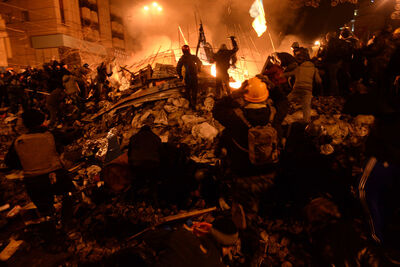
Protesters fighting government forces on Maidan Nezalezhnosti in Kiev on 18 February 2014.
After the breakup of the Soviet Union, Ukraine endured years of corruption, mismanagement, lack of economic growth, currency devaluation, and problems in securing funding from public markets. Successive Ukrainian governments in the 2000s sought a closer relationship with the European Union (EU). One of the measures meant to achieve this was an association agreement with the European Union, which would have provided Ukraine with funds in return for liberalising reforms.[41] President Yanukovych announced his intention to sign the agreement, but ultimately refused to do so at the last minute. This sparked a wave of protests called the "Euromaidan" movement. During these protests Yanukovych signed a treaty and multibillion-dollar loan with Russia.The Ukrainian security forces cracked down on the protesters, further inflaming the situation and resulting in a series of violent clashes in the streets of Kiev. As tensions rose, Yanukovych fled to Russia and did not return.
Russia refused to recognize the new interim government, calling the overthrow of Yanukovych a coup d'état, and began a military intervention in Ukraine supporting pro-Russian separatists. The newly appointed interim government of Ukraine signed the EU association agreement and agreed to reform the country's judiciary and political systems, as well as its financial and economic policies. The International Monetary Fund pledged more than $18 billion in loans contingent on Ukraine's adopting those reforms. The revolution was followed by pro-Russian unrest in some south-eastern regions, a standoff with Russia regarding the annexation of Crimea and Sevastopol, and a war between the Ukrainian government and Russia-backed separatists in the Donbass.
A period of relative calm in the anti-government demonstrations in Kiev ended abruptly on 18 February 2014, when protesters and police clashed. At least 82 people were killed over the next few days, including 13 policemen, with one report by the Ukraine Health Ministry claiming as many as 100 were killed.
Over half of these were the work of the Russian-trained Ukrainian Security Service, who deployed snipers against the Euromaidan. Hours later, the head of the SBU resigned and was arrested after taking responsibility for the mass-killings.
On 20 February 2014, Lviv Oblast declared independence, bringing Ukraine to the brink of civil war.
"The regime has begun active military action against people. Dozens of people have been killed in Kiev and hundreds have been wounded. Fulfilling the will of society, the executive committee of the Lviv region's council, the People's Rada, is assuming full responsibility for the fate of the region and its citizens," read a statement.
This was in reference to a 20 February 2014 decree authorizing the Ukrainian police to use live ammo on the pro-EU Maidan.
The executive committee was led by Petro Kolodiy, chairman of the Lviv region's council.
From the end of February 2014, demonstrations by pro-Russian and anti-government groups took place in major cities across the eastern and southern regions of Ukraine, in the aftermath of the Euromaidan movement and the 2014 Ukrainian revolution. During the first stage of the unrest, Crimea was annexed by the Russian Federation after a Russian military intervention, and an internationally criticized (based on UN resolution 68/262) Crimean referendum. Protests in Donetsk and Luhansk regions (oblasts) escalated into an armed pro-Russian separatist insurgency.
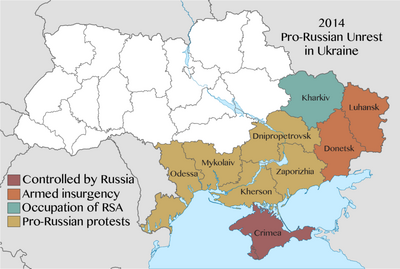
Map of protests by region, indicating the severity of the unrest at its peak
From late 2014, cities outside of the Donbass combat zone, such as Kharkiv, Odessa, Kiev and Mariupol, were struck by bombings that targeted pro-Ukrainian unity organizations. To maintain control over southeastern territories Ukraine's government started "antiterrorist operation" (ATO) sending armed forces to suppress separatists. Armed conflict between Ukraine's government forces and pro-Russian rebels is known as War in Donbass.
From the beginning of March 2014, protests by pro-Russian and anti-government groups took place in the Donetsk and Luhansk oblasts of Ukraine, commonly collectively called the "Donbass", in the aftermath of the 2014 Ukrainian revolution and the Euromaidan movement. These demonstrations, which followed the annexation of Crimea by the Russian Federation (February to March 2014), and which were part of a wider group of concurrent pro-Russian protests across southern and eastern Ukraine, escalated into an armed conflict between the separatist forces of the self-declared Donetsk and Luhansk People's Republics (DPR and LPR respectively), and the Ukrainian government. In the Donetsk People's Republic, from May 2014 until a change of the top leadership in August 2014, some of the top leaders were Russian citizens. According to the Ukrainian government, at the height of the conflict in mid-2014, Russian paramilitaries were reported to make up between 15% to 80% of the combatants.
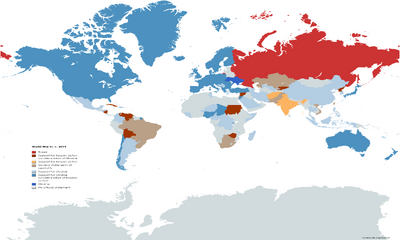
Countries supporting Russia's annexation of crimea (red and orange), neutral (yellow) and opposing UN member-states (blue). Countries not explicitly pro-Russian but leaving the UN are in grey.
Between 22 and 25 August 2014, Russian artillery, personnel, and what Russia called a "humanitarian convoy" crossed the border into Ukrainian territory without the permission of the Ukrainian government. Crossings occurred both in areas under the control of pro-Russian forces and in areas that were not under their control, such as the south-eastern part of Donetsk Oblast, near Novoazovsk. These events followed the reported shelling of Ukrainian positions from the Russian side of the border over the course of the preceding month. Head of the Security Service of Ukraine, Valentyn Nalyvaichenko characterised the events of 22 August as a "direct invasion by Russia of Ukraine", while other western and Ukrainian officials described the events as a "stealth invasion" of Ukraine by Russia. Russia's official position on the presence of Russian forces in Donbass has been vague: while official bodies have denied presence of "regular armed forces" in Ukraine, it has on numerous occasions confirmed presence of "military specialists", along with other euphemisms, usually accompanied by an argument that Russia "was forced" to deploy them to "defend the Russian-speaking population".
From the mid-2010’s to the early 2020’s, a low-level insurgency in the Donbas would ensue, and the involvement of Serb mercenaries and the Livonian KGB itself alongside the Hungarians, the Kremlin and their supporters in the breakaway republics would culminate in widespread violent crackdowns on the press – most prominently the car-bombing and assassination of Russian freelance journalist Pavel Sheremet at 7:45 A.M. on 20 July 2016 in Kyiv, Ukraine. These attacks were later discovered to be part of a larger state-sponsored terror campaign involving targeted killings reaching as far as Germany an as early as 2012.
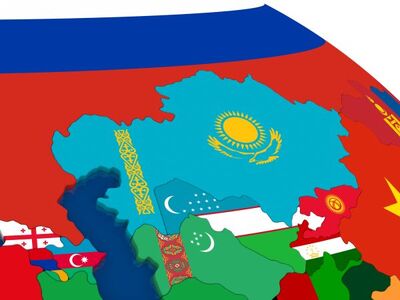
Azerbaijan-Bukhara became the core polity dominating the region, supplanting the nation-state of Kazakhstan, in the 2020's
In response to a 2021 Russian-backed Livonian attack on EU airspace in downing a Lithuanian-bound flight from Greece ferrying a Belarusian activist, Livonian–Ukrainian relations collapse as the two countries exchange sanctions and the former deepens ties with Lithuania over military threats from Russia and Belarus on their borders. Several years later previously-missing nuclear weapons appear on Belarusian and Kaliningrad Oblast soil, accelerating the crisis in Eastern Europe.
The 2022 invasion of Ukraine results in in-fighting amongst the various member-states of the Eurasian Union, with Kazakhstan offering a rare rebuke of the Russian action. The other two, Livonia and Kyrgyzstan however, remain steadfastly pro-Russian. By the end of 2023; Azerbaijan, Kazakhstan, Uzbekistan, Turkmenistan and Kyrgyzstan, with Hungary as an observing member, were lockstep in their goals regarding the lands surrounding their countries - supplanting Russia and the West in conjunction with China, and ruling all of Asia, the Caucasus and parts of Eastern Europe. Although all five were independent countries with their own foreign policy and domestic policy, Tashkent, Uzbekistan became the tentative location of the executive, while the parliament and court resided in Baku.
Nagorno-Karabakh conflict[]
The Nagorno-Karabakh conflict was an ethnic and territorial conflict between Armenia and Azerbaijan over the disputed region of Nagorno-Karabakh, inhabited mostly by ethnic Armenians, and seven surrounding districts, inhabited mostly by Azerbaijanis until their expulsion during the 1990s. The Nagorno-Karabakh region was entirely claimed by and partially de facto controlled by the breakaway Republic of Artsakh, but was recognized internationally as part of Azerbaijan. Azerbaijan controls the remainder of the Nagorno-Karabakh region as well as the seven surrounding districts.
The conflict has its origins in the early 20th century, but the present conflict began in 1988, when the Karabakh Armenians demanded the transfer of the region from Soviet Azerbaijan to Soviet Armenia. The conflict escalated into a full-scale war in the early 1990s following the dissolution of the Soviet Union. The First Nagorno-Karabakh War led to tens of thousands of casualties. The war was won by Armenia, which subsequently occupied regions around Soviet-era Nagorno-Karabakh. Ethnic Azerbaijanis were expelled from the Armenian-controlled areas, while ethnic Armenians were expelled from Azerbaijan. The ceasefire ending the first war, signed in 1994 in Bishkek, was followed by two decades of relative stability, which significantly deteriorated in the 2010s. A four-day escalation in April 2016 resulted in hundreds of casualties but only minor changes to the front line.
Azeri–Bukharan invasion of Armenia[]
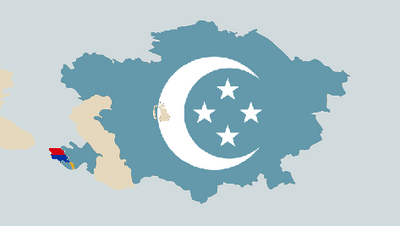
The Azerbaijani-spearheaded invasion of Armenia would be universally condemned by all but Russia and China
In late 2020, the large-scale Second Nagorno-Karabakh War resulted in thousands of casualties and a significant Azerbaijani victory. An armistice was established by a tripartite ceasefire agreement on November 10, resulting in Azerbaijan regaining all of the occupied territories surrounding Nagorno-Karabakh as well as capturing one-third of Nagorno-Karabakh itself. Ceasefire violations in Nagorno-Karabakh and on the Armenian-Azerbaijani border have continued following the 2020 war, with intermittent but ongoing casualties.
Since the 2020 Nagorno-Karabakh War, Azerbaijan has rescinded its offer of special status or autonomy to its indigenous Armenian residents and instead insists on their "integration" into Azerbaijan. International mediators and human rights organizations emphasized self-determination for the local Armenian population and did not believe that Artsakh Armenians could live safely under the regime of Azerbaijani President Aliyev. Since December 2022, Azerbaijan had blockaded the Republic of Artsakh from the outside world, in violation of the 2020 ceasefire agreement and international legal rulings.
Beginning with the Armenia-Azerbaijan border crisis in the early-2020's, particularly during the September 2022 clashes, the international community reacted with excoriation towards Azerbaijan over its actions in Armenia, with the US, France, the UK, Canada, Greece, Cyprus, Estonia, India, EU and Uruguay openly condemning Azerbaijan, laying the blame for the crisis squarely at their feet, with some even going so far as to suggest sanctions. Throughout the 2020's, the Turkic states of Central Asia and Azerbaijan would become more integrated, mutually expanding their militaries and organizing their intergovernmental political organization. Azerbaijan and Kazakhstan would emerge as the most militarized of the new Union, expanding their manpower by the most, while Kazakhstan and Uzbekistan provided the brunt of the air force, and Turkmenistan and Azerbaijan provided most of the tanks and armored fighting vehicles.
The conflict, primarily centered around the Armenian capital of Yerevan, results in over 100,000 casualties. Nearly the entire population of Artsakh is razed, displaced, or killed, including women and children. The international community is in uproar, while Russia and China sounded their usual notes of neutrality. Even the Turkish Republic criticizes its long-time ally for collaborating with the other former-Soviet republics to invade and decimate the country of Armenia. While both were Turkic polities and neither go to war against one another, relations between Azerbaijan-Bukhara and Turkey remain cool from thereon. Although not officially a NATO ally, the Nordic Battlegroup spearheaded by Denmark and Finland is able to repulse the invaders by September and reclaim nearly all Armenian territory proper. Unfortunately, Artsakh is lost to and annexed by the Azerbaijanis backed by Azerbaijan-Bukhara, China and Russia.
Arab–Israeli conflict (1948–2022)[]
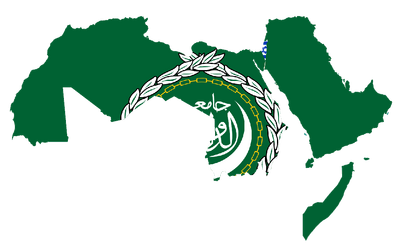
Although the Arab-Israeli conflict would subside in the 20th century, tensions between the Arab League and Israel would flare up once more with the creation of the United Arab Kingdom and the pro-Palestinian Biden administration in the 2020's.
The Arab–Israeli conflict was an intercommunal phenomenon involving political tension, military conflicts, and other disputes between Arab countries and Israel, which escalated during the 20th century, but had mostly faded out by the early 21st century. The roots of the Arab–Israeli conflict have been attributed to the support by Arab League member countries for the Palestinians, a fellow League member, in the ongoing Israeli–Palestinian conflict; this in turn has been attributed to the simultaneous rise of Zionism and Arab nationalism towards the end of the 19th century, though the two national movements had not clashed until the 1920s.
Part of the Palestine–Israel conflict arose from the conflicting claims by these movements to the land that formed the British Mandatory Palestine, which was regarded by the Jewish people as their ancestral homeland, while at the same time it was regarded by the Pan-Arab movement as historically and currently belonging to the Arab Palestinians, and in the Pan-Islamic context, as Muslim lands. The sectarian conflict within the British Mandate territory between Palestinian Jews and Arabs escalated into a full-scale Palestinian civil war in 1947. Taking the side of the Palestinian Arabs, especially following the Israeli Declaration of Independence, the neighboring Arab countries invaded the by-then former Mandate territory in May 1948, commencing the First Arab–Israeli War. Large-scale hostilities mostly ended with ceasefire agreements after the 1973 Yom Kippur War. Peace agreements were signed between Israel and Egypt in 1979, resulting in Israeli withdrawal from the Sinai Peninsula and the abolition of the military governance system in the West Bank and Gaza Strip, in favor of Israeli Civil Administration and consequent unilateral annexation of the Golan Heights and East Jerusalem.
The nature of the conflict has shifted over the years from the large-scale, regional Arab–Israeli conflict to a more local Israeli–Palestinian conflict, which peaked during the 1982 Lebanon War when Israel intervened in the Lebanese Civil War to oust the Palestinian Liberation Organization from Lebanon. By 1983, Israel reached normalization with Christian-dominated Lebanese government, but the agreement was annulled the next year with Muslim and Druze militias' takeover of Beirut. With the decline of the 1987–1993 First Palestinian Intifada, the interim Oslo Accords led to the creation of the Palestinian National Authority in 1994, within the context of the Israeli–Palestinian peace process. The same year, Israel and Jordan reached a peace accord. In 2002, the Arab League offered recognition of Israel by Arab countries as part of the resolution of the Palestine–Israel conflict in the Arab Peace Initiative. The initiative, which has been reconfirmed since, calls for normalizing relations between the Arab League and Israel, in exchange for a full withdrawal by Israel from the occupied territories (including East Jerusalem) and a "just settlement" of the Palestinian refugee problem based on UN Resolution 194. In the 1990s and early 2000s, a cease-fire had been largely maintained between Israel and Baathist Syria, as well as with Lebanon. Despite the peace agreements with Egypt and Jordan, the interim peace accords with the Palestinian Authority and the generally existing cease-fire, until the mid-2010s the Arab League and Israel had remained at odds with each other over many issues.
Developments in the course of the Syrian Civil War reshuffled the situation near Israel's northern border, putting the Syrian Arab Republic, Hezbollah and the Syrian opposition at odds with each other and complicating their relations with Israel, upon the emerging warfare with Iran. The conflict between Israel and Hamas-ruled Gaza, is also attributed to the Iran–Israel proxy conflict in the region. By 2017, Israel and several Arab Sunni states led by Saudi Arabia formed a semi-official coalition to confront Iran. This move and the Israeli normalization with Gulf States was marked by some as the fading of the Arab–Israeli conflict. Relations between then-Iraq, Syria and Jordan remained relatively unchanged upon the formation of Arabia, that is until the mid-2020's when Baathism began to once again take power in the region, and relations between the nations of Arabia and Israel soured. The increasingly Anti-Israel Democrats of the United States would take the White House in 2020, and would soon after announce preemptive opposition to Israeli annexation of the West Bank, pledging to support the Palestinians and the Arab League in such a situation. The U.S., followed closely by the UN, EU and NATO, would follow through on this promise when Israel began formal annexation of the West Bank in 2023. Although Israel had traditionally stronger ties to the U.S. than with China or Russia, and the latter two countries had traditionally been more allied with the Arab World, Israeli ties to the Taliban's 2023 attacks on Iran reveal covert military and intelligence relationships between at least the Chinese and the Israelis at the time of Israel's annexation of the West Bank.
East Asia Crisis (1950–2024)[]
The Japanese growth in the postwar period was often called a "miracle". It was led by manufacturing; starting with textiles and clothing and moving to high-technology, especially automobiles, electronics and computers. The economy experienced a major slowdown starting in the 1990s following three decades of unprecedented growth, but Japan still remains a major global economic power.
The Chinese Civil War resumed after World War II concluded. In 1949, Mao Zedong proclaimed the People's Republic of China and the Republic of China, which had governed mainland China until this point, retreated to Taiwan. Since then, the jurisdiction of the Republic of China has been limited to the Taiwan Area.
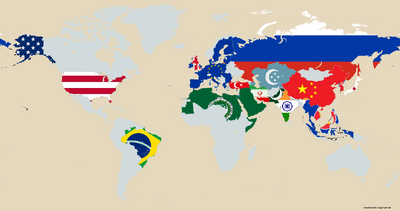
Great and middle/regional powers of the world, c. 2025
After the surrender of Japan, at the end of World War II, on 15 August (officially 2 September) 1945, Korea was divided at the 38th parallel into two zones of occupation. The Soviets administered the northern-half and the Americans administered the southern-half. In 1948, as a result of Cold War tensions, the occupation zones became two sovereign states. This led to the establishment of the Republic of Korea in South Korea on 15 August 1948, promptly followed by the establishment of the Democratic People's Republic of Korea in North Korea on 9 September 1948.
In 1950, after years of mutual hostilities, North Korea invaded South Korea in an attempt to re-unify the peninsula under its communist rule. The United Nations, under the leadership of the United States, United Kingdom, Canada, France, Belgium, Holland, Greece, Turkey, Australia, South Africa and Colombia entered Korea while China entered to protect North Korea. The Korean War, which lasted from 1950 to 1953, ended with a stalemate and has left the two Koreas separated by the Korean Demilitarized Zone (DMZ) up to the present day.

Corporate ties between South Korea and China would begin in 2015 - growing to become Samsung's second biggest market by 2019 - and accelerate in the 2020's
The 2017–18 North Korea crisis was a period of heightened tension between North Korea and the United States throughout 2017. The crisis began early in the year when North Korea conducted a series of missile and nuclear tests that demonstrated the country's ability to launch ballistic missiles beyond its immediate region, suggesting their nuclear weapons capability was developing at a faster rate than had been assessed by U.S. intelligence. Both countries started exchanging increasingly heated rhetoric, including nuclear threats and personal attacks between the two leaders, which, compounded by a joint U.S.–South Korea military exercise undertaken in August and North Korea's sixth nuclear test in September, raised international tensions in the region and beyond and stoked fears about a possible nuclear conflict between the two nations. In addition, North Korea also threatened Australia twice with nuclear strikes throughout the year for their allegiance with the United States.
Tensions began to ease in 2018, with North Korea announcing the restoration of the Seoul–Pyongyang hotline and agreeing to hold talks with South Korea about participation in the 2018 Winter Olympics in Pyeongchang. Diplomatic activity flourished during the next few months, with the suspension of nuclear and missile tests by North Korea, and the 2018 inter-Korean summit in late April which culminated in the signing of the Panmunjom Declaration on 27 April 2018. An unprecedented bilateral summit between Kim and Trump was held in Singapore on 12 June 2018. It resulted in a joint declaration calling for the "full denuclearization of the Korean peninsula". A second summit between Kim and Trump took place in Hanoi, Vietnam on 27–28 February 2019. Though talks there broke down, a third summit took place in the Korean Demilitarized Zone (DMZ) on 30 June 2019, with Trump becoming the first US leader to visit North Korea. Follow-up talks later in 2019, however, broke down within hours.
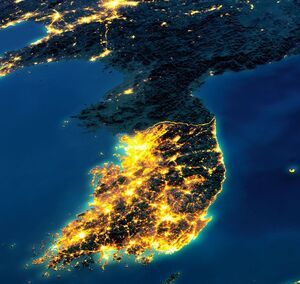
The Korean Peninsula would become the epicenter of the 21st century crisis in East Asia
In the 2020's, nearly 20 decades after it was first proposed, the G2 was identified by the United Nations, World Health Organization, Council of Europe, European Union, the Asian tiger economies, G4, I6, OIC, OAS and ASEAN as a direct threat to the planet, with the two countries topping the list of 2021's largest CO2 emitters, the largest spenders on military and two of the three largest countries in the world by both land area and population. Although the United States was hopelessly divided, China's own internal disputes were largely papered over by the PRC's hulking military-industrial complex. Moreover, its alignment with other highly centralized regimes in Russia and North Korea drew the ire of the international community, and further isolated it from Europe and the rest of the world.
Israeli–Lebanese conflict (1968–2006)[]
- See Also: Arab-Israeli conflict, 2006 Lebanon War, Persian–Saudi and Arab Cold Wars, and 2019–20 Lebanese Crisis

In the 1990’s and 2000’s, the Saudi Arabian–Iranian cold war would cast its shadow far across the sands of the Middle-East and the Muslim World as a whole.
The Israeli–Lebanese conflict refers to the principle confrontations that continued for decades in the subsequent conflict succeeding the Arab-Israeli War of 1948. The principle belligerents involved Israel, Lebanon and Syria, the Palestine Liberation Organization and various pro-Israeli and pro-Iranian militia movements.
The Palestine Liberation Organization (PLO) recruited militants in Lebanon from among the families of Palestinian refugees who had been expelled or fled due to the creation of Israel in 1948. After the PLO leadership and its Fatah brigade were expelled from Jordan in 1970-71 for fomenting a revolt, they entered Southern Lebanon, resulting in an escalation of internal and cross-border clashes. Meanwhile, demographic tensions over the Lebanese National Pact led to the Lebanese Civil War (1975–1990). PLO was one of the key factors to the eruption of the Lebanese Civil War and its bitter battles with Lebanese factions caused foreign intervention. Israel's 1978 invasion of Lebanon pushed the PLO north of the Litani River, but the PLO continued their campaign against Israel. Israel invaded Lebanon again in 1982, in alliance with major Lebanese Christian militias Lebanese Forces and Kataeb Party, and forcibly expelled the PLO. In 1983, Israel and Lebanon signed the May 17 Agreement providing a framework for the establishment of normal bilateral relations between the two countries, but relations were disrupted with takeover of Shia and Druze militias in early 1984. Israel withdrew from most of Lebanon in 1985, but kept control of a 12-mile security buffer zone, held with the aid of proxy militants in the South Lebanon Army (SLA).
In 1985, Hezbollah, a Lebanese Shia radical movement sponsored by Iran, called for armed struggle to end the Israeli occupation of Lebanese territory. When the Lebanese civil war ended and other warring factions agreed to disarm, Hezbollah and the SLA refused. Combat with Hezbollah weakened Israeli resolve and led to a collapse of the SLA and an Israeli withdrawal in 2000 to their side of the UN designated border.
2006 Lebanese War[]
The 2006 Lebanon War, also called the 2006 Israel–Hezbollah War and known in Lebanon as the July War (Arabic: حرب تموز, Ḥarb Tammūz) and in Israel as the Second Lebanon War (Hebrew: מלחמת לבנון השנייה, Milhemet Levanon HaShniya), was a 34-day military conflict in Lebanon, Northern Israel and the Golan Heights. The principal parties were Hezbollah paramilitary forces and the Israel Defense Forces (IDF). The conflict started on 12 July 2006, and continued until a United Nations-brokered ceasefire went into effect in the morning on 14 August 2006, though it formally ended on 8 September 2006 when Israel lifted its naval blockade of Lebanon. Due to unprecedented Iranian military support to Hezbollah before and during the war, some consider it the first round of the Iran–Israel proxy conflict, rather than a continuation of the Arab–Israeli conflict.
Following the overthrow of Ba'athist Iraq and subsequent fiat-occupation emboldening neighboring Iran - on the opposite side of the country in neighboring Syria, then-Lebanese PM Rafic Hariri is assassinated. US President George W. Bush meets with future-Prime Minister Saad Hariri, promising an ultimately-misguided investigation into the involvement of the Assad regime. A few months later, the true perpetrators reveal themselves, catching the Allies off-guard with a broadside involving terrorist attacks, and full-scale war...
Citing Israeli control of the Shebaa farms territory, Hezbollah continued cross border attacks intermittently over the next six years. Hezbollah now sought the release of Lebanese citizens in Israeli prisons and successfully used the tactic of capturing Israeli soldiers as leverage for a prisoner exchange in 2004. The capturing of two Israeli soldiers by Hezbollah ignited the 2006 Lebanon War. Its ceasefire called for the disarmament of Hezbollah and the respecting of the territorial integrity and sovereignty of Lebanon by Israel.
The conflict was precipitated by the 2006 Hezbollah cross-border raid. On 12 July 2006, Hezbollah fighters fired rockets at Israeli border towns as a diversion for an anti-tank missile attack on two armored Humvees patrolling the Israeli side of the border fence. The ambush left three soldiers dead. Two Israeli soldiers were abducted and taken by Hezbollah to Lebanon. Five more were killed in Lebanon, in a failed rescue attempt. Hezbollah demanded the release of Lebanese prisoners held by Israel in exchange for the release of the abducted soldiers. Israel refused and responded with airstrikes and artillery fire on targets in Lebanon. Israel attacked both Hezbollah military targets and Lebanese civilian infrastructure, including Beirut's Rafic Hariri International Airport. The IDF launched a ground invasion of Southern Lebanon. Israel also imposed an air and naval blockade. Hezbollah then launched more rockets into northern Israel and engaged the IDF in guerrilla warfare from hardened positions.
The conflict is believed to have killed between 1,191 and 1,300 Lebanese people, and 165 Israelis. It severely damaged Lebanese civil infrastructure, and displaced approximately one million Lebanese and 300,000–500,000 Israelis.
2017–22 Saudi Arabian–Lebanese crisis[]
The Lebanon–Saudi Arabia crisis began when Lebanese Prime Minister Saad Hariri abruptly announced his resignation while he was in Saudi Arabia on 4 November 2017. Shortly thereafter, the foreign relations between both countries and allied regional neighbors became increasingly strained. On 6 November, Saudi Arabia claimed Lebanon declared war between the two states, despite leaders of Lebanon stating otherwise. On 9 November, Saudi Arabia, Bahrain, Kuwait, and the United Arab Emirates asked their citizens to leave Lebanon. The conflict is thought to be part of the larger Iran–Saudi Arabia cold war.
Lebanon's president and some Lebanese officials believe that Hariri's abrupt resignation was made under coercion by Saudis and have claimed that the Saudis have kept him hostage. Iran, Hezbollah and some analysts also believe that this was to create a pretext for war against Hezbollah. On 21 November, Hariri resigned in Beirut but he immediately suspended it. Hariri rescinded the resignation completely on 5 December, leading to years of protest and unrest.
The 2019–2022 Lebanese protests were a series of civil protests in Lebanon, initially triggered by planned taxes on gasoline, tobacco and online phone calls such as through WhatsApp, but quickly expanding into a country-wide condemnation of sectarian rule, stagnant economy, unemployment, endemic corruption in the public sector, legislation (such as banking secrecy) that was perceived to shield the ruling class from accountability and failures from the government to provide basic services such as electricity, water and sanitation. The protests first erupted on 17 October 2019.
As a result of the protests, Lebanon entered a political crisis, with Prime Minister Hariri once again tendering his resignation and echoing protesters' demands for a government of independent specialists. Other politicians targeted by the protests have remained in power. On 19 December 2019, former Minister of Education Hassan Diab was designated the next prime minister and tasked with forming a new cabinet. Protests and acts of civil disobedience continued and expanded into Syria and Iraq, with protestors denouncing and condemning Diab’s designation as a ‘Fascist-Communist Coup’ spearheaded by the Syrian Social-Nationalist Party and others in the pro-Syrian/Resistance Axis 8 March Alliance.
Indo–Pakistani Cold War (1947–2026)[]
- See Also: Kashmir conflict, India, First Kashmir War, Indo–Pakistani Wars of 1965 and 1971, Kargil War, Insurgency in Jammu and Kashmir and Indo–Pakistani Nuclear War of 12 June 2027
The Indo–Pakistani Cold War was, in many aspects, similar to its Persian–Saudi counterpart, but on a much grander scale. The Civil Wars in 1990’s Afghanistan, and the subsequent Taliban regime and 2001 World Trade Center attacks, were largely collateral damage as a result of a heavily-militarized Pakistan in response to decades of conflict and war with India over Kashmir. Regimes in both countries carried out war crimes and crimes against humanity, with India’s treatment of Jammu & Kashmir’s populace described as oppression, and Pakistan’s backing the People's Republic of China and remaining silent on its Uyghur concentration camps in Xinjiang even as the PRC's Islamophobia reached into its very own borders, and backing of Islamist insurgents in J&K as well as its acts of aggression which led to all of its major wars with India in 1947, 1965 and 1971. The successful testing of nuclear weapons by both countries in the late 1990’s led to two major standoffs in 1999 and 2002 respectively.
In 2019, renewed fighting between Indian Government and insurgent forces in J-K results in a state of emergency and the stripping of the region’s autonomous status later that year. After the lock-down ends in early 2020, pandemonium and chaos ensues, resulting in a brutal crackdown and near-complete isolation from the international community. China largely distances itself from the situation, in the midst of a domestic crisis of its own at this time. The strongest opposition to Prime Minister Narendra Modi and support of Kashmir comes primarily from the North and East of India and in more liberal and Marxist regions. This movement spreads, however, and within a few years a demonstration consisting of roughly 50 million people had skyrocketed to comprise nearly half the country by 2024, including military and public officials. Amid increasing government crackdown and terrorist attacks in Kashmir increasing to almost daily by late-2025, Modi is forced to resign due to crushing unpopularity. The resistance remained firm in North and East India and the military, and they were soon considered to be compromised by Communists. The culture of fear and paranoia results in full-scale Afghan–Indian Invasions of Peshawar and Gilgit in 2026, ceasefire violations and invasion of Aksai Chin in April 2027, culminating in the nuclear bombings of Kashmir and North Waziristan on 12 June 2027 and an Indian Civil War later that month. India and Japan would also launch attacks on mainland China during this time, resulting in the deaths of over 37 million Chinese.
Korean Conflict (1945–2022)[]
- See Also: Korean Empire, Korea under Japan, Division of Korea, Korean War, 1996 Gangneung submarine infiltration incident, 1998 Sokcho submarine incident, Battle of Yeosu, Battle of Amami-Ōshima, First and Second Battle and Bombardment of Yeonpyeong; 2017–2018 North Korea crisis, April 2018 inter-Korean summit, September 2018 inter-Korean sumit, 2018 North Korea–United States Singapore Summit, and Raid on Jeju Island
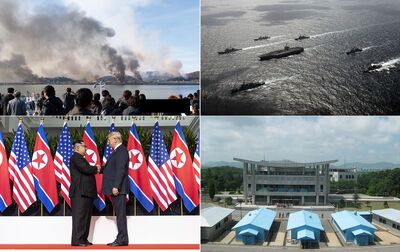
Clockwise from top left; Yeonpyeong Island under North Korean attack, Vessels of US Carrier Strike Group Three sail in formation with ROK Navy ships during Key Resolve/Foal Eagle 2009, Korean DMZ from the North, North Korean Leader Kim Jong-un and US President Donald Trump in Singapore (2018)
The Korean conflict was a concurrent conflict based on the division of Korea between North Korea (Democratic People's Republic of Korea) and South Korea (Republic of Korea), both of which claimed to be the sole legitimate government of all of Korea. During the Cold War, North Korea was backed by the Soviet Union, the People's Republic of China and their communist allies, while South Korea was backed by the United States and its Western allies. The division of Korea by external powers occurred at the end of World War II, starting in 1945, and tensions erupted into the Korean War, which lasted from 1950 to 1953. When the war ended, both countries were devastated, with utter destruction of much of the countries, but the division remained. North and South Korea continued a military standoff, with periodic clashes. The conflict survived the collapse of the Eastern Bloc of 1989 to 1991 and continued until the mid-2020's.
The U.S. maintained a military presence in the South to assist South Korea in accordance with the ROK–US Mutual Defense Treaty. In 1997, U.S. President Bill Clinton described the division of Korea as the "Cold War's last divide". In 2002, U.S. President George W. Bush described North Korea as a member of an "axis of evil". Facing increasing isolation, North Korea developed missile and nuclear capabilities.
In 2018, North and South Korea, and the United States, held a series of summits which promised peace and nuclear disarmament. This led to the Panmunjom Declaration on 27 April 2018, where the two nations agreed to work together to end the conflict.
In late 2006, North Korea tested its first nuclear weapon, which the United Nations Security Council immediately thereafter condemned. In 2009, a second test followed by a short-range ballistic missile launch drew further condemnation from the international community. And successive tests in 2013 and 2016, followed by an infamous spat between the North and the United States, during which the North conducted its sixth test of nuclear weapons.
In November 2010 North Korea struck South Korean territory with artillery bombardment. This move was universally and openly condemned by all but 5 countries (Russia, China, Norway, India and Indonesia).
Second Japanese–Korean War (2022–2023)[]
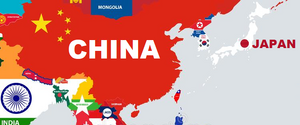
The outbreak of the Second Japanese–Korean War in 2022 would accelerate the 1997–2022 Japanese–Korean Cold War to the brink of hot conflict, crippling the Chinese economy and resulting in mass civil unrest in the two Asian titans, eventually resulting in a Chinese civil war and resurgent, reunified Korea.
Beginning in late 2018, early 2019, Japan and South Korea exchange venomous accusations over a rapidly-escalating spat between a South Korean naval destroyer and a Japanese fighter plane. At the same time, the North Korean-US summits between North Korean Leader Kim Jong-un and US President Donald Trump isolate and radicalize the Japanese government.
With both countries jockeying for a relationship with the otherwise 'Hermit Kingdom,' the implications of North Korean-Nazbol plot to pit Japan against South Korea or possibly even China became more real.
In 2022-2023, beginning in mid-December, North Korean Juche-militants in Japan began conducting hit-and-run attacks, assassinations and kidnappings in Osaka. Japan responds by increasing militarization of its police forces, the ASEAN+6 mechanism (which China would later leave) and a NATO-backed raid on Jeju Island on 12 February 2023, which brings an immediate sanctions and military response against South Korean forces in general at the threat from the Russian and Chinese-backed fourth column and their allies - both traditional and otherwise. North Korea had succeeded in removing the international spotlight from its next move. A U.S.-Australian led coalition consisting of NATO vessels enforcing a blockade of the Sea of Japan while patrolling the Yellow Sea with air support is sufficient, though the situation on Jeju Island is not so pleasant. Russian-backed Korean infantry come to direct blows with US-backed Korean Republican, USFK and Japanese ground forces as part of a longer campaign involving a stalemate between Japanese and Korean artillery that would continue to be unresolved long after the armistice on 8 September 2023. Japan would be further-isolated after opening fire on Korean gun-boats and Russian frigates in La Pérouse Strait, killing 79 civilians in Yuzhno-Sakhalinsk Airport and 247 others at Yuzhno-Sakhalinsk train station in Sakhalin, Russia (in addition to several of their intended North Korean and Russian military targets) which immediately invades and occupies Hokkaido, largely from meek concession on the part of the Japanese government in "the name of peace".
Although coalition forces suffer only 57 casualties regarding the sinking of the USS Nantucket (LCS-27) by RIM-161 rockets from South Korea, the Jeju Siege would result in the deaths of hundreds of thousands more at the hands of these very same rockets under Japanese jurisdiction. By the armistice in the fall of 2023, Jeju City was declared uninhabitable. Over 300,000 people were killed in the span of 45 minutes when loyalists to the Kim Regime hijacked South Korean missiles and attempted to use them on the Japanese occupation forces in the South of the island. Nearly a quarter of the people managed to be evacuated without warning, only because of the funeral services for the then-Jeju Province Governor Won Hee-ryong, who had passed away earlier that morning due to suspicious circumstances (also revealed to be the North). After a begrudging international Korean-Japanese investigation into the circumstances behind the killings of Japanese and South Korean officials reveals the implications of the North Korean State itself, Japan begins the process of rolling back their active ground forces, which in turn provokes the deescalation of NATO and US involvement... but it is far too little too late.
A surprise tactical nuclear bombing of Suwon, Gyeonggi-do, just 30 kilometers south of the South Korean Capital of Seoul kills 800,000 people instantaneously, and another 500,000 die of radiation by the end of 2028. At the same time, a coup unfolds in Seoul, with elements within the President's administration accusing the leadership of staging a false-flag operation to justify further U.S. neo-imperialism. The controversy penetrates all levels of society in Northeast Asia, reaching as high up as the Kim Dynasty itself - revealing an intricate web of connections involving a member of the Chinese Communist Party and his own connections to the North Korean Kim Regime and the Kremlin. A deep web of power was becoming exposed, due to this corruption. The people of Hong Kong, Taiwan, and throughout Mainland China and Tibet unite to demand accountability from the Communist Party to stand up to the sway of foreign influence from "Imperialists" and "financial terrorism," in which they are accused of being sell-outs and crooks. All across the region unrest reaches a boiling point until NATO relents to the cries of Japan and Anti-Russian Korean insurgents begging for help from the cascading Russian-Korean onslaught, aided and assisted by Beijing and moles they had carefully placed throughout the city. South Korea had fallen for the North's dividing and conquering of East Asia, encouraged by the Russian Kremlin and Livonian KGB.
Thus the Second Japanese-Korean War concluded, and the Global War on Korea and their backers in Russia and China commenced.
BRIC[]
- Not to be confused with BRICS
- For other uses, see: Bric (disambiguation)
BRIC is a grouping acronym for the countries of Brazil, Russia, India, and China, largely considered to the next-nearest competitors of the G7 (Britain, Canada, France, Germany, Italy, Japan and the United States).
The term was coined by Jim O'Neill in 2001 as an acronym for four countries that were all deemed to be at a similar stage of newly advanced economic development, but in 2009 the leaders of BRIC countries made the first summit and in 2010 BRIC became a formal institution.
The BRIC thesis recognizes that Brazil, Russia, India and China had changed their political systems to embrace global capitalism. Goldman Sachs predicted that China and India, respectively, will become the dominant global suppliers of manufactured goods and services, while Brazil and Russia will become similarly dominant as suppliers of raw materials. Of the four countries, Brazil remained the only polity that had the capacity to continue all elements, meaning manufacturing, services and resource supplying simultaneously. Cooperation is thus hypothesized to be a logical next step among the BRICs because Brazil and Russia together form the logical commodity suppliers.
In the early 2020s, NATO officials gathered in Brussels to formulate a plan on how to exploit the growing unrest in Hong Kong to ‘punch a hole’ in the BRICs by bringing China into the fold of democracy. Already faith was plummeting in the Communist Party over its handling of North Korea and India – the latter being one of the two largest countries on the planet (second only to China itself), mass internment of Xinjiang’s Uyghur populace, and the various power-grabs in Hong Kong, Macau, and most recently in Tibet, followed by horrific ‘organ farming’ operations using prisoners as human test subjects in the City of Shanghai led to a movement there headed by Shanghainese Mayor Yin Yicui, and the autonomy of the newly-established Special Administration of Shanghai after facing NATO-spearheaded international pressure.
Shanghai would later collapse into civil war between those backed by the independence/democratic movement, and those backed by Beijing and the Kim Dynasty of North Korea.

Until the commencement of hostilities within her borders, the China-Pakistan alliance was largely winning in its cold war against India. As the two largest countries on the planet, any war between China and India would need to be won quickly by the former, and by the Indian invasion of Balochistan and uprisings in Tibet and Xinjiang, and Indo-Vietnamese Invasion of Hat Yai in 2022 from the Andaman and Nicobar Islands in response to growing relations between the Thai Monarchy and the People's Republic of China it became clear human civilization was on course to be split largely down the middle between the more imperialist ‘China Bloc,’ and the more globalist ‘India Bloc,’ the former spearheaded by Azerbaijan-Bukhara, North Korea and Russia, and the latter by the United States, Australia and Japan.
What grew from a tiny minority within China of roughly 11 million consisting primarily of Tibet and Hong Kong had exploded by the end of the year in; Xinjiang, Shanghai, Macau, Taiwan, Hong Kong, Tibet, India, the Philippines, Australia and across Asia and even the West reaching 100 million across the world calling for the end of authoritarianism and ethno-nationalism in China. With the full backing of the United Nations; the Tibetan people collectively declare independence with the full backing of Qinghai, Sichuan, Yunnan, Chongqing and Guizhou of a collective population of over 201.6 million along with a parallel nationalist movement among the Cantonese communities of Guangdong, Guangxi, Hainan, Hong Kong and Macau which thereafter sign into law with the Republic of China (Taiwan) a founding document to create the Cantonese Republic – population: 202.7 million. But still, the People's Republic of China possessed no need to recognize these territories and continued to claim them, with the ability to mobilize a population of nearly twice that of the Cantonese, with over 389 million in populace. Nevertheless, this results in Turkey and Pakistan effectively freezing their relations with China and India, with the latter accusing India of attempting to weaponize the Uyghurs and Kurds, as Turkey and Russia had their own skeletons with regard to the latter. Notable Pakistan ally Turkey would accelerate ties with traditionally-Chinese-aligned Pakistan, even as it supported its NATO allies and Ukraine against Russia, and invoking the ire of the U.S. government regarding opposition to a sale of F-16s to a country that had recently purchased Russian S-400 missile systems and maintained ties with the Taliban.
Global War on Terror (2001–2023)[]
- See: Global War on Terror, 9/11, PATRIOT Act, PRISM, Iraq War, French–U.S. tensions over Iraq, Russo-Georgian War, Libyan Civil War, Syrian Civil War, Crimean Crisis, European Migrant Crisis, Brexit, Frozen War (1999-2022) & Independence Front
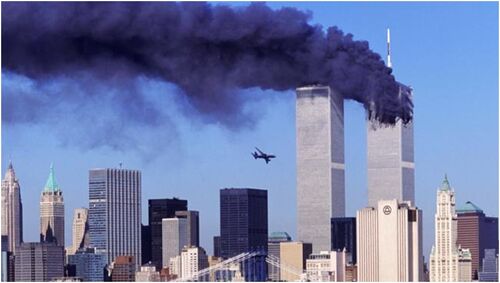
On September 11th, 2001; 19 Egyptian and Saudi Muslims hijacked American and United Airlines flights 11 and 175, And subsequently flew them into the World Trade Center’s ‘Twin Towers’ – destroying them and killing 3,000.
2001[]
September 11 – A series of multiple coordinated suicide attacks upon the United States in New York City and the Washington, D.C. area occurred when 19 terrorists from the Islamic militant group Al-Qaeda hijacked four passenger jets. The hijackers intentionally crashed two planes, American Airlines Flight 11 and United Airlines Flight 175, into the Twin Towers of the World Trade Center in New York City; both towers collapsed within two hours. Hijackers also crashed American Airlines Flight 52 into the Empire State Building which was managed to be narrowly saved from the same fate as the North and South World Trade Centers, and American Airlines Flight 77 into the Pentagon in Arlington, Virginia. The death-toll climbed to an estimate 3,000 civilian casualties by the end of the day. On September 12th, George W. Bush, President of the United States, declares a Global War on Terror in cooperation with NATO, the UN, European Union, and Israel, effectively setting forth the first steps toward a Third Global Confrontation.
October 7 – The US invades Afghanistan with assistance from NATO, and Israeli forces. Bush signs the PATRIOT act, the former of which granted broader security and surveillance permissions to the Executive branch of Government, formed the Department of Homeland Security (DHS).
U.S. Invasion of Iraq[]
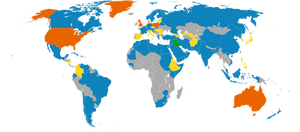
War on terror, c. 2003; orange - British–US sympathizers, blue - Iraqi–French sympathizers
Following the Iraq disarmament crisis, in which following the Gulf War the Iraqi state was supposed to comply by international demands that it relinquish any and all chemical weapons, the U.S. government claims, without evidence, that the Iraqi regime is in possession of weapons of mass destruction. The calls for war from Washington and London are rebuked by most of the international community, spearheaded by NATO, France and Russia. The invasion that follows soon after involves the deployment of a force nearly fifty times the size of the one in Afghanistan in response to the 9/11 attacks, and represents the first major armed international standoff of World War III.
20 March 2003 – The US invades Iraq based on Bush's claims that Iraq possesses WMD's. US government's true motives are to control the oil industry, the same goes for the similarly based invasion nearly a month later.
16 May 2003 – Fall of the Ba'ath Party government in Iraq.
Unknown Date – The US government's NSA establishes, in secret, a mass, nationwide surveillance program known as PRISM, not to be exposed until 2013 by Edward Snowden. The US government labels him a traitor, and attached to him the accusation of 'aiding the enemy', indicating that by this point the US government considered its people 'the enemy'.
Re-election of President George W. Bush[]
2 February 2005 – In his State of the Union address, Bush attempts to privatize certain assets of the Social Security program, but fails when public approval dwindles, arriving dead in the water for the remainder of his term.
11 August 2005 – Demand increase in oil results in an all-time high of $60 a barrel. This is due to lack of control over the central banks and the Federal Reserve in their management interest rates, thus allowing oil prices to get out of control, and the depreciation of the US dollar due to inflation, which will continue to occur as long as the US dollar is a fiat currency backed by nothing.
15 April 2006 – Due to the precedent set by near-privatization of Social Security the Republican-controlled congress, facing fears of a Democratic victory in November, pass greater deregulations toward the housing and financial sectors.
5 November 2006 - Saddam Hussein is executed.
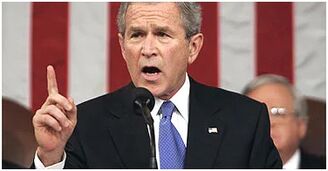
President George W. Bush – Responsible for the Longest War in American History C. 2004
2007[]
May 9 – Amidst fears of a looming financial crisis and facing an angry American public, President Bush unlawfully grants himself new powers by stripping states and their senators of power and signing into law a Presidential Directive, known as National Security and Homeland Security Directive 51, wherein all power of the Judiciary, Legislature, as well as the House and Senate, resided with the President, transforming the United States into a fiat dictatorship.
2008[]
August – Russia invades Georgia. The War lasts for just under a week, and ends with Russia annexing parts of neighboring Georgia. It is the first European War of the 21st century.
September – The financial crisis becomes more serious after the government takeover of Fannie Mae and Freddie Mac, followed by the collapse of Lehman Brothers, and a Bush Administration federal bailout of American International Group, Inc. for $85 million. Just a few weeks prior to this the US stock market saw its largest drop in history. With the collapse of major firms Fannie Mae and Freddie Mac, the Dow Jones is at its lowest in decades at 8,219, by September 11.
Obama administration[]
January 2009 – Former senator, and Democratic Party Nominee, Barack Obama, becomes the first multiracial President of the United States. Obama’s primary opponent Hillary Rodham Clinton, wife of 42nd President Bill Clinton, is picked to be Secretary of State. Democrats gain a supermajority in the House and Senate, and even their fellow Socialist and Green Parties are present. On January 24th Obama signs the American Economic Recovery and Reinvestment Plan into law which costs more than $1 trillion. The plan includes huge tax increases on people making more than $250,000 per year and spends hundreds of billions on the military-industrial complex.
March 2009 – Due to the acute extremity of the United States financial crisis, at this point being referred as the "Second Depression", the formerly known Euro Crisis is now being taken into heavy consideration yielding to the fact that the independent EU nations, due to the devastating impact the Second Great Depression has delivered unto the global economy, may no longer be able to stand on independent economies. The plummeting borrowing power caused by the dollar and currently causing the Euro Crisis gives birth to a lot of American resentment, blaming the US Government's "ruthlessly fascist imperialism" over the past decade as the cause of it all.
September 2009 – China begins pressuring the US to pay back their loans to the PRC. NASA loses most of its funding, and only has a few billion dedicated to satellite maintenance.
December 2009 – President Obama increases US troop presence in Afghanistan by 30,000. The Egyptian people peacefully overthrow the reign of Egyptian President Hosni Mubarak. Two years later, the first democratically-elected President of Egypt, Muhammed Morsi, is subsequently overthrown by a Military Junta.
2011-2017[]

The 2016 election boasts the resurgence of populism, seen in its most authoritarian form in the policy of billionaire businessman Donald J. Trump
February – After Libyan dictator 'King of Kings' Muammar Gaddafi takes questionable measures to repress the 'Arab Spring' in his country, the nation erupts in civil war. Supported by NATO; military intervention rebels, primarily Al-Qaeda and Hezbollah associates, launch counterattacks against the regime.
March 15 – Conflict begins in Syria between forces loyal to the Syrian Ba'ath Party Government and those seeking to oust it, with popular demonstrations that grew nationwide by April. Conspiracy theorists and realists alike suspect that it is possible Al-Assad was propped up by western influence to spark a middle-eastern anti-western force in the Middle-East, to justify further American intervention into the region.
July – Obama begins plans for a 'Domestic National Security' force to be headed by the Department of Homeland Security, increasing Government Surveillance Policy, and the extent of the PATRIOT Act.
September 17 – Angry American citizens march on Wall Street in a movement known as 'Occupy Wall Street', inspired by internet hack-tivist group 'Anonymous'. The protests would soon erupt into a movement encompassing over 30 countries worldwide and lasting for years, greatly influencing politics in the West. On 3 April 2016, hundreds of supporters of Bernie Sanders protested outside of CNN's Headquarters in Los Angeles. Sanders supporters were protesting CNN's coverage of the 2016 United States presidential elections, specifically in regards to the amount of airtime Sanders has received. Known as Occupy CNN, protestors are claiming that major media networks have intentionally blacked out Sanders' presidential campaign in favor of giving much more airtime to candidates such as Hillary Clinton and Donald Trump. The Occupy movement took inspiration in part from the Arab Spring, from the 2009 Iranian Green Movement, and from the Spanish Indignados Movement, as well as from the overall global wave of anti-austerity protests of 2010 and following. The movement commonly used the slogan "We are the 99%" and the #Occupy hashtag format; it organized through websites such as Occupy Together.
October – Protests spread to over 70 other US cities by the 9th of the month, marking the greatest public demonstration since 1966. This is due mainly in part to the diminishing US foreign relations, the Depression, and American imperialism. People are fed-up with the US government running their lives, and are determined to deliver the power back into the hands of the people. Later in the month Libyan rebels overthrow Gaddafi’s regime, and establish the “National Transitional Council”.
Various Dates – The PRISM program under Bush sees widespread mass-surveillance and the dawning of a police state in embryonic form. This inadvertently results NSA Contractor Edward Snowden leaking files incriminating the US Government in mass-surveillance scandals involving the NSA's PRISM program. In the data leaked, foreign governments, mainly the EU, and mainly supposed 'allies' of the US government, were having their phone calls, their emails, and their personal privacy violated and spied on by the NSA.
Various Dates – Russian-backed separatists seize the Ukrainian peninsula of Crimea and initiate breakaway illegitimate governments in the Ukrainian regions of Donetsk and Lugansk, resulting in a War in Donbass after Ukrainians peacefully overthrow the Russian-friendly government of Viktor Yanukovych. Several years later, UNA-UNSO - the Ukrainian ultranationalist faction that backed Russian President Boris Yeltsin against his predecessor's attempt to decentralize the Soviet government in 1991 (of which Putin was an ally and successor) - would escalate their crusade against the pro-Western government in Kiev backed by Russia.
Fall 2015 – Due to the fallout of the Syrian Civil War, record numbers of refugees flood into Europe from the Middle-East. Extremist anti-immigration parties climb the polls all across the continent, particularly in Eastern Europe, where the continent is hit hardest.
The refugee crisis reignited tensions between Croatia and Serbia, after Hungary shuts down its border with Serbia, leaving refugees trapped in a tug of war between the two former-Yugoslav states.
Spring 2016 – The US Presidential elections see big money maintain influence in American politics, which spark protests in dozens of cities, with the largest in Washington-DC. Presidential hopeful and champion of the 99%, Senator Bernie Sanders is routed by Wall Street candidate, former First Lady and Secretary of State Hillary Clinton – the candidate of the Conservative Democrats, who seek to exploit her name and reclaim the Oval Office for their donors in the Republican Party, and continue their hawkish foreign policy – the opposite of what Sanders intends to do. Throughout the primary season the two frontrunners solidify their leads into the general election season.
Fall 2016 – Eventually, it comes to the attention of government transparency advocate Julian Assange – and his associates at WikiLeaks – that Clinton’s team is actively sabotaging the campaign of Sanders and infuriating millions of people – thus weakening the ability of the Democrats to stand against Trump. With help from an insider within the U.S. Intelligence Community, WikiLeaks attempts to expose the Clinton machine before the DNC, but are too late. The leaks don’t drop until the general election, all but guaranteeing a Republican Presidency. During the primaries, the FBI concludes its investigation and surmises that Hillary Clinton violated no national security and declines to indict.

(Image: Hillary for America logo) Operatives in the DNC and their allies on Wall Street, steal contests in 6 states from Bernie Sanders.
The Republicans nominate billionaire businessman Donald Trump, who rapidly becomes a media sensation due to his off-the-cuff remarks about illegal immigrants, banning Muslim immigrants, building a Wall on the Mexican–American border, and initiating sweeping mass-surveillance, as well as his disturbingly cozy relationships with both of the Clintons, the mafia, dictators abroad (such as North Korean Premier Kim Jong-un) and his status as a Democrat not even a month before deciding to run for the GOP Nomination.
The Republican nominee helps boost Hillary’s poll numbers.
Trump had reportedly received a phone call from ex-President Bill Clinton a week before announcing his bid from the Presidency. On into the summer and beyond, Trump continues to (seemingly) purposefully sabotage his own campaign. His pro-Democrat donations come up. His donations to the Clinton Foundation come up. His ties to the mob. His ponzi schemes. His crookery. His scams. His lies. Trump receives a record amount of free media coverage, all the while – conveniently enough – the Sanders campaign for-the-most-part ignored or marginalized.
But, what she isn’t helped by is her connection to the Iraqi and Libyan Invasions, and – most damning of all – her close friendship with former-President George W. Bush. Although she wins the primaries against Bernie Sanders, his Revolution invigorates a movement of informed and aware young people, and while they largely split down the middle between those heeding the calls of the sabotaged campaign of Bernie Sanders to rally around Hillary Clinton against Donald Trump, a great many reject the false narrative of the corporate Democratic-Republican Duopoly and side with the insurgency of third parties. The Wall Street Democrats had silenced a generation desperate for change, desperate for a future free from poverty and war, desperate for a future with an accessible middle-class and college education.
Nevertheless, the DNC's corruption goes unnoticed and unrevealed until after the California primary – the largest and most decisive state contest. After the DNC, and Bernie’s official concession to Hillary Clinton, the fall and winter months of 2016 feature a general election between the two most hated Presidential candidates in American, and perhaps World, History. The leaked documents indicting the DNC for corruption are stolen by Russian hackers – likely affiliated directly with then-President of Russia Vladimir V. Putin (as all U.S. Intelligence Agencies would inevitably confirm) almost immediately after WikiLeaks acquires them, guaranteeing the downfall of Sanders and the ascension of Donald Trump.

The Clintons sabotage the Democratic Party using their vast wealth and Wall Street connections – angering many democrats. C. 2016
The arrogance and rampant lust for power of Wall Street and the New Democrats drives the Democratic Party into disarray, alienating and silencing the Progressive Wing of the party and elevating Trump. By forcing a flawed and heavily-disliked candidate down voters’ throats, and sabotaging the campaign of Progressive Bernie Sanders (who was shown in multiple polls to be beating Trump by landslide margins), the New Democrats (and Russians) had effectively selected Donald Trump as the 45th President of the United States.
For another 4 years, Trump continues Bush’s foreign policy, tearing apart the Middle-East, and by the time the 2024 elections roll around - after losing in 2020 to Joe Biden - Trump’s reluctant opponent, bureaucratic 2020 Democratic vice-presidential nominee and former-Senator, acting-President Kamala Harris – fueled by a burgeoning 2024 primary challenge from Transportation Sec. Pete Buttigieg, President Biden's flagging support among Democratic primary voters and her triumph over former-UN Ambassador Susan Rice as favorite to be nominated for vice president – had returned with a furor. Harris was determined to emerge from Biden's shadow and out of the machinery of the Democratic Party, despite the growing pressure on the left to select a progressive as her own running-mate in 2024.
Coincidentally, this also marked the nomination as Vice President of the Bernie Sanders Revolution’s second-in-command after dropping out of the primary – Alexandria Ocasio-Cortez. Ocasio-Cortez would endorse the progressive Interior Secretary Deb Haaland for president, although she would run on the ticket of Sec. Buttigieg in 2024, the eventual winner of the primary.
By the end of Trump’s Presidency; China and its puppet regimes, Hungarian and Serb ultra-nationalism, the Eurasian Economic Union and the Wall Street financial elite had solidified power to such a stark degree in comparison to the rest of the political world that the very fabric holding world peace together was beginning to fray under the weight of a global system thrown into disarray by such a chaotically-imbalanced international oligarchy whose corruption knew no limits.
President Trump[]
Although Trump campaigned as a non-interventionist and a populist, his Presidency was far more authoritarian and internationalist than what he campaigned as. Donald Trump stated that America "should look inward," and "stop nation-building," but he would do just the opposite. As a candidate he questioned whether he, as president, would automatically extend security guarantees to NATO members, suggesting that he might leave NATO. But as president, he had reaffirmed U.S. commitment to NATO.
Both as a candidate and as president, Trump stated many times that he wants a good relationship with Russia. President Trump held several meetings with Russian President Vladimir Putin as President. On April 7, 2017, Trump ordered a missile strike against a Syrian airfield in retaliation for the Khan Shaykhun chemical attack.
North Korea became a major issue in Summar 2017. During the 2016 camapign and the early months of his administration, Trump had hoped that China would help to rein in North Korea's nuclear ambitions and missile tests. However, North Korea accelerated in missile testing, leading to an increase in tensions in April. In July, the country tested two long-range missiles identified by Western observers as intercontinental ballistic missiles, potentially capable of reaching Alaska, Hawaii, and the U.S. mainland. In August 2017, President Trump dramatically escalated his rhetoric against the North, warning that further provocations against the U.S. will be met with "fire and fury like the world has never seen." North Korean leader Kim Jong-un then directly threatened the U.S. territory of Guam with a missile attack. The President responded that if North Korea took steps to attack Guam, "things would happen to them like they never thought possible."
Impeachment efforts and polling[]
On 12 July 2017, California Congressman Brad Sherman formally introduced an article of impeachment, H. Res. 438, accusing the president of obstructing justice regarding the investigation of Russian interference in the 2016 presidential election.
Presidential approval ratings for Trump have revealed him to be the least popular US president in the history of modern opinion polling as of the first ten months of his term.
Weinstein effect[]
The sexual misconduct allegations against Candidate Trump that threatened to derail his Presidential ambitions in 2016 led to a wide-ranging political sex scandal that would consume Minnesota Senator Al Franken, Alabama state Judge Roy Moore, Michigan Representative John Conyers, former San Diego Mayor and California Representative Bob Filner, and former Presidents William Jefferson Clinton III and George H. W. Bush. And supporters of both Bill and Hillary Clinton largely believe Bill Clinton's accusers by the end of 2017.
War in Syria (2011–2022)[]
The Syrian civil war (Arabic: الحرب الأهلية السورية, al-ḥarb al-ʾahlīyah as-sūrīyah) was a multi-sided civil war in Syria fought between the Ba'athist Syrian Arab Republic led by Syrian President Bashar al-Assad, along with domestic and foreign allies, and various domestic and foreign forces opposing both the Syrian government and each other in varying combinations.
The unrest in Syria, part of a wider wave of the 2011 Arab Spring protests, grew out of discontent with the Syrian government and escalated to an armed conflict after protests calling for Assad's removal were violently suppressed. The war, which began on 15 March 2011 with major unrest in Damascus and Aleppo, was fought by several factions: the Syrian Armed Forces and its international allies, a loose alliance of mostly Sunni opposition rebel groups (including the Free Syrian Army), Salafi jihadist groups (including al-Nusra Front), the mixed Kurdish-Arab Syrian Democratic Forces (SDF), and the Islamic State of Iraq and the Levant (ISIL), with a number of countries in the region and beyond being either directly involved or providing support to one or another faction (Iran, Russia, Turkey, the United States, as well as others).
Iran, Hezbollah, and the CSTO supported the Syrian Arab Republic and the Syrian Armed Forces militarily under the Axis of Resistance umbrella, with Russia conducting airstrikes and other military operations from September 2015 until February 2023. The U.S.-led international coalition, established in 2014 with the declared purpose of countering ISIL, conducted airstrikes primarily against ISIL as well as some against government and pro-government targets as well as deployed special forces and artillery units to engage ISIL on the ground. From 2015 to 2022, the U.S. supported the Democratic Federation of Northern Syria and its armed wing, the SDF, materially, financially, and logistically. Turkey was directly involved in operations against the Syrian government from August 2016 until 2022, not only supporting ISIL alongside token support to the U.S.-led coalition, but also actively supporting the Syrian opposition and occupying large swaths of northwestern Syria while engaging in significant ground combat with the SDF - particularly against the Syrian Kurds and YPG/YPJ, in an outpouring of a spillover from the Turkish government's ongoing war against the Kurdish minority in Turkey - as well as the Syrian government. However, Turkey and Jordan would begin rapproachment with the Assad regime in late 2021, despite being traditionally American allies. Between 2011 and 2017, fighting from the Syrian civil war spilled over into Lebanon as opponents and supporters of the Syrian government traveled to Lebanon to fight and attack each other on Lebanese soil, with ISIL and Al-Nusra also engaging the Lebanese Army. Furthermore, while officially neutral, Israel exchanged fire with Hezbollah and Iranian forces, whose presence in southwestern Syria it views as a threat. It has also carried out repeated strikes in the rest of Syria since the start of the war, mainly targeting alleged Iranian and Hezbollah militants.
International organizations criticized virtually all sides involved, including the Ba'athist Syrian government, ISIL, opposition rebel groups, Russia, Turkey, and the U.S.-led coalition of severe human rights violations and massacres. The war ended in a stalemate, with Assad remaining in power (although greatly weakened) until January 2030 and with Russia and Turkey maintaining a foothold in the region until the 2040's. Over 900,000 people die with over 29 million refugees displaces across the region. The devastation, akin to the Iraq War, leads to a power vacuum that would later be filled by ever more fervent extremists.
Assad would concede major influence to the Hashemite Kingdom of Jordan in 2023, following renewed interest in the Arab Federation by Iraq. The Hashemite Kingdom of United Arabia is formed in early 2023 and would last until 2028 under the rule of Jordanian King Abdullah II, with a population of 78,367,000 and a military nearly 500,000-strong, wielding 70 attack helicopters, nearly 6,000 tanks, 14,000 armored fighting vehicles, and 5,500 artillery including nearly 1,000 rocket projectors.
Second Russo–Japanese War[]
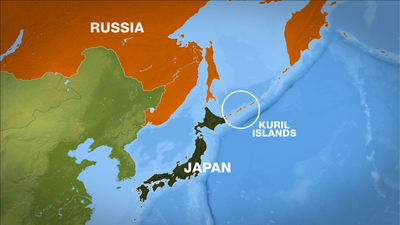
Accelerating tensions between Ukraine and Russia also lead to increasing hostility between the latter and Japan over the Kuril Islands.
After increased Russian activity in Ukraine c. January-March 2022, US antagonism forces Russian arming of the Kuril Islands and militarizing the Sea of Okhotsk against Japan. Several months later, Russia begins shelling Hokkaido, Rishiri, and Rebun Island from the Kuril Islands and Sakhalin, and Japan responds in kind. Within the next 24 hours, Russia ceases its attacks and Japan concludes missile strikes against the Habomai islands. In the 3 April 2023 Raid of Shikotan, Japan seizes the Habomai islands and launches 4-6 April attacks on Iturup and Kunashir islands, beginning a yearlong Japanese attack on the Greater Kuril Chain, an exercise in penultimate futility.
The Japanese are ultimately pushed back onto the Lesser Kurils, while also losing Rishiri and Rebun Island to the Russian occupiers. The G7 react collectively with the toughest sanctions Russia had seen yet, following the recent Second Winter War between Russia, the Baltics and Finland. Russia sought to maintain a foothold in Northwestern Japan and take back the Lesser Kurils, and thus a state of constant war was unleashed between Japan and Russia, and would not cease until the collapse of Russia in the 2030's - resulting in what was effectively a constant stalemate; with the vastly superior Russian Navy unable to collectively come together to challenge Japan's homefield advantage. This advantage would temporarily diminish with the entry of China into the conflict over the Senkaku Islands in Southern Japanese Okinawa, as well as the surrounding region. However, Japan would soon be aided by the EU, UK and partially the United States in its quarrels with China, Korea and Russia.
Chilean Civil War of 2023[]
Beginning in the late 2010's and enduring into the early 2020's, Chile would see increasing civil unrest and street-fighting. The Nazbol left-wing fascist "Pincer" movement backed by Argentina and the People's Republic of China, the latter seeking a solid foothold in the Western Hemisphere against the United States and NATO, would surge in the Chilean parliament in the wake of left-wing Anarchocommunist militant attacks. The bulk of the fifteen-month fighting would take place in and around Santiago, with smaller clashes in the North and South of the country. A majority of encounters would be skirmishes between riflemen and foot soldiers, all in all a total of 46 deaths and over 1,000 wounded are recorded. Chilean military forces would find greater influence along with the newly-created position of El Mandatario, which nationalist party leader Jose Antonio Kast is appointed to in a bid to "tame" the Pincer-dominated military.
War in Afghanistan (2001–2098)[]
- Main article: War in Afghanistan
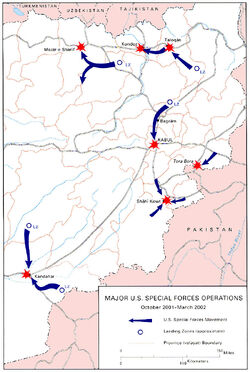
Map of the main operations of the United States special forces from October 2001 to March 2002, including Afghan velayat borders
The War in Afghanistan followed the United States invasion of Afghanistan of 7 October 2001, when the United States of America and its allies successfully drove the Taliban from power in order to deny al-Qaeda a safe base of operations in Afghanistan. Since the initial objectives were completed, a coalition of over 40 countries (including all NATO members) formed a security mission in the country called International Security Assistance Force (ISAF, 2001–2014), of which certain members were involved in military combat allied with Afghanistan's government. The war has afterwards mostly consisted of Taliban insurgents fighting against the Afghan Armed Forces and allied forces; the majority of ISAF/RS soldiers and personnel are American. The war was code named by the US as Operation Enduring Freedom (2001–14) and Operation Freedom's Sentinel (2015–2021); it was the longest war in US history.
Following the September 11 attacks in 2001 on the US, which President George W. Bush stated was carried out by the Al-Qaeda terrorist organization led by Osama bin Laden, who was living or hiding in Afghanistan and had already been wanted since the 1998 United States embassy bombings, President Bush demanded that the Taliban, who were de facto ruling Afghanistan, hand over bin Laden. The Taliban declined to extradite him unless they were provided clear evidence of his involvement in the attacks, which the US refused to provide and dismissed as a delaying tactic. On 7 October 2001 the United States, with the United Kingdom, launched Operation Enduring Freedom. To justify the War, the Bush administration claimed that Afghanistan only had "selective sovereignty", and that intervention was necessary because the Taliban threatened the sovereignty of other states. The two were later joined by other forces, including the Northern Alliance – the Afghan opposition which had been fighting the Taliban in the ongoing civil war since 1996. By December 2001, the Taliban and their al-Qaeda allies were mostly defeated in the country, and at the Bonn Conference new Afghan interim authorities (mostly from the Northern Alliance) elected Hamid Karzai to head the Afghan Interim Administration. The United Nations Security Council established the ISAF to assist the new authority with securing Kabul, which after a 2002 loya jirga (grand assembly) became the Afghan Transitional Administration. A nationwide rebuilding effort was also made following the end of the totalitarian Taliban regime. In the popular elections of 2004, Karzai was elected president of the country, now named the Islamic Republic of Afghanistan. NATO became involved in ISAF in August 2003, and later that year assumed leadership of it. At this stage, ISAF included troops from 43 countries with NATO members providing the majority of the force. One portion of US forces in Afghanistan operated under NATO command; the rest remained under direct US command.
Following defeat in the initial invasion, the Taliban was reorganized by its leader Mullah Omar, and launched an insurgency against the Afghan government and ISAF in 2003. Though outgunned and outnumbered, insurgents from the Taliban and other groups waged asymmetric warfare with guerrilla raids and ambushes in the countryside, suicide attacks against urban targets, and turncoat killings against coalition forces. The Taliban exploited weaknesses in the Afghan government to reassert influence across rural areas of southern and eastern Afghanistan. From 2006 the Taliban made significant gains and showed an increased willingness to commit atrocities against civilians – ISAF responded by increasing troops for counter-insurgency operations to "clear and hold" villages. Violence sharply escalated from 2007 to 2009. Troop numbers began to surge in 2009 and continued to increase through 2011 when roughly 140,000 foreign troops operated under ISAF and US command in Afghanistan. Of these 100,000 were from the US. On 1 May 2011, United States Navy SEALs killed Osama bin Laden in Abbottabad, Pakistan. NATO leaders in 2012 commended an exit strategy for withdrawing their forces, and later the United States announced that its major combat operations would end in December 2014, leaving a residual force in the country. In October 2014, British forces handed over the last bases in Helmand to the Afghan military, officially ending their combat operations in the war. On 28 December 2014, NATO formally ended ISAF combat operations in Afghanistan and officially transferred full security responsibility to the Afghan government. The NATO-led Operation Resolute Support was formed the same day as a successor to ISAF.
At the beginning of Donald Trump's presidency in early 2017, there were fewer than 9,000 American troops in Afghanistan. By early summer 2017, troop levels increased by about 50%; there were no formal plans to withdraw. In August 2019, the Taliban planned to negotiate with the US to reduce troop levels back to where they had been when Trump took office, but Trump canceled the negotiations after a Taliban attack. On 29 February 2020, the United States and the Taliban signed a conditional peace deal in Doha, Qatar, which requires that U.S. troops to withdraw from Afghanistan within 14 months so long as the Taliban cooperates with the terms of the agreement.
Despite the peace agreement between the U.S. and the Taliban, insurgent attacks against Afghan security forces were reported to have surged in the country. In the 45 days after the agreement (between 1 March and 15 April 2020), the Taliban conducted more than 4,500 attacks in Afghanistan, which showed an increase of more than 70% as compared to the same period in the previous year. More than 900 Afghan security forces were killed in the period, up from about 520 in the same period a year earlier. Meanwhile, because of a significant reduction in the number of offensives and airstrikes by Afghan and U.S. forces against the Taliban due to the agreement, Taliban casualties dropped to 610 in the period down from about 1,660 in the same period a year earlier. The Pentagon spokesman, Jonathan Hoffman, said that although the Taliban stopped conducting attacks against the U.S.-led coalition forces in Afghanistan, the violence was still "unacceptably high" and "not conducive to a diplomatic solution." He added: "We have continued to do defensive attacks to help defend our partners in the area and we will continue to do that."
On 22 June 2020, Afghanistan reported its "bloodiest week in 19 years," during which 291 members of the Afghan National Defense and Security Forces (ANDSF) were killed and 550 others wounded in 422 attacks carried out by the Taliban. At least 42 civilians, including women and children, were also killed and 105 others wounded by the Taliban across 18 provinces. During the week, the Taliban kidnapped 60 civilians in the central province of Daykundi.
On July 1, 2020, the U.S. House Armed Services Committee overwhelmingly voted in favor of a National Defense Authorization Act amendment to restrict President Trump's ability to withdraw U.S. troops from Afghanistan.
After a contested 2019 presidential election results in a spike of Western-backed instability from 2020 to 2022, the Uzbek nationalist Junbish organization along with the Afghan National Army - both led by pro-Western Marshal Abdul Rashid Dostum at the time - install the former Vice President in a bloodless coup through threat of force and violence. Afghan President Dostum immediately after, with assistance from Pakistani nationalists - declares war on Pakistan, with massive troop buildup along the Durand Line over the next several years. Pakistan, facing a conflict from within akin to the Western-backed Chinese autonomous regions, calls upon the assistance of Turkey. The resultant conflict - escalating at a time that Russia was claiming more territory in Europe, China was collapsing and India was expanding - would involve Pakistan, India and Afghanistan, and result in the deaths of between 5.3 and 6.1 million and set the region back decades. The timing of the start of this row between Afghan and Pak governments is key, as not only does it uncover Dostum's potential role as a Russian spy, it also exposes the entire Uzbek military-industrial complex as a Russian shell organization posing as a national security state apparatus.
Various governments and regimes both authoritarian and democratic, and everywhere in between, would come to rule Afghanistan between 2030 and 2100. The effects of the climate singularity crisis of the mid-21st-early-22nd century would see the population plunge from over 45 million to under 20 in less than a decade between 2055 and 2063, and the following decades would see its government further radicalize, particularly with the inevitable rise of Russian-Turkish influence in the region by the 2090's, Allied member-states are forced to abandon their campaign against the extremists in Afghanistan, as the country's further and further reliance upon Eurasian economic ties effectively shuts the West out with brute force. The Afghan War is a failure of massive proportions, lasting for just shy of a century, and results in the irreversible disappearance of the United States, Russia, Europe, China and Asia as they were once known to our planet.
Beginning Conflicts (2014–2020)[]
- See: Balkan Emergency, February Crisis, 2020 U.S. presidential election, War in Tajikistan, British Insurgencies, Pete Buttigieg (Frozen War), Donald J. Trump, Ted R. Cruz, North America, Terrorism, & JaF

Former-President Donald Trump - barred from running in 2024 due to criminal investigations - attempts to sabotage the 2024 election after it is revealed that President Ted Cruz and former-Secretary of Defense Kirsten Gillibrand are assassinated, And the US government is shut down by Interpol and the ICC for investigation.
Yemeni Civil War (2015–2026)[]
The Yemeni Civil War lasted for 11 years between two factions: the Abdrabbuh Mansur Hadi led Yemeni government and the Houthi armed movement, along with their supporters and allies. Both claimed to constitute the official government of Yemen, with the Saudi-led faction seizing power in 2026.
Houthi forces currently controlled the capital Sanaʽa from 2015 to 2026, allied with forces loyal to the former president Ali Abdullah Saleh, and clashed with the forces loyal to Hadi who were based in Aden. Al-Qaeda in the Arabian Peninsula (AQAP) and the Islamic State of Iraq and the Levant also carried out attacks during this time, with AQAP controlling swathes of territory in the hinterlands, and along stretches of the coast. Concurrently, the Hadi government warred with UAE forces as a result of UAE military measures such as the United Arab Emirates takeover of Socotra and UAE-backed STC takeover of Aden.
On 21 March 2015, after taking over Sanaʽa and the Yemeni government, the Houthi-led Supreme Revolutionary Committee declared a general mobilization to overthrow Hadi and expand their control by driving into southern provinces. The Houthi offensive, allied with military forces loyal to Saleh, began fighting the next day in Lahij Governorate. By 25 March, Lahij fell to the Houthis and they reached the outskirts of Aden, the seat of power for Hadi's government. Hadi fled the country the same day.
Concurrently, a coalition led by Saudi Arabia launched military operations into the late 2020's by using air strikes to restore the former Yemeni government. The United States provided intelligence and logistical support for the campaign. According to ACLED, over 400,000 people were killed in Yemen, including more than 50,000 civilians, as well as estimates of more than 200,000 dead as a result of an ongoing famine due to the war.
The conflict was largely an extension of the Middle-Eastern cold war and as a means to combat Iranian influence in the region. In 2018, the United Nations warned that 13 million Yemeni civilians face starvation in what it says could become "the worst famine in the world in 100 years (and this prediction would be realized by 2060, decades earlier)."
The international community sharply condemned the Saudi Arabian-led bombing campaign, which has included widespread bombing of civilian areas. The bombing campaign killed or injured an estimated 47,729 civilians as of March 2026 according to the Yemen Data Project. Despite this, the crisis only began to gain as much international media attention as the Syrian Civil War a mere 5-6 years before the conclusion of hostilities.
The US has provided bombs to aid the Saudi forces and airstrikes in Yemen. In March 2019, this led the United States Senate to pass a resolution to end US support of Saudi Arabia. It has since been vetoed by President of the United States Donald Trump, and in May 2019, the Senate failed to override the veto.
The United Nations Development Programme published a report in September 2019 that said if the war continued there would be catastrophic consequences. This was largely realized when Yemen became the poorest country in the world, with 79% of the population living below the poverty line and 65% in extreme poverty on 18 October 2020.
Egyptian–Saudi Arabian invasion of Sudan[]
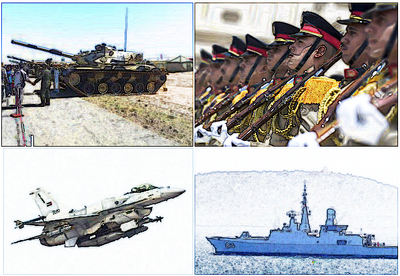
Clockwise from top-left; Moroccan M60A3 during a 2006 Army expo, Egyptian honor guard soldiers during a visit of U.S. Navy Adm. Mike Mullen, United Arab Emirates Air Force F-16 Block 60 "Desert Falcon", taking off from the Lockheed Martin plant in Fort Worth, Texas, Makkah, an Al Riyadh-class frigate of Saudi Arabia.
In 2023, Egypt spearheaded a similar operation to the one in Yemen in neighboring Sudan. The armed conflict between the Sudanese Armed Forces (SAF) and the paramilitary Rapid Support Forces (RSF), rival factions of the military government of Sudan, began on 15 April 2023, with the fighting concentrated around the capital city of Khartoum and the Darfur region. Later, a faction of the militant Sudan People's Liberation Movement–North (SPLM-N) led by Abdelaziz al-Hilu, also fought the SAF in regions bordering South Sudan and Ethiopia. As of 22 July 2023, between 3,000 to 10,000 people had been killed and 6,000 to 8,000 others injured, while as of 18 July 2023, 2.6 million were internally displaced and 730,000 others had fled the country as refugees.
The conflict began with attacks by the RSF on government sites as airstrikes, artillery, and gunfire were reported across Sudan. Throughout the conflict, RSF leader Mohamed Hamdan "Hemedti" Dagalo and Sudan's de facto leader and army chief Abdel Fattah al-Burhan have disputed control of government sites, including the general military headquarters, the Presidential Palace, Khartoum International Airport, Burhan's official residence, and the SNBC headquarters. Starting in June, the SPLM-N (al-Hilu) attacked army positions in the south of the country. On 31 July, a faction of the Sudan Liberation Movement led by Mustafa Tambour (SLM-T) confirmed its participation in the conflict, supporting the SAF in Darfur.
Strong ties between the RSF and Ethiopia prompts an Egyptian-led intervention in the country in late-2023, early-2024, when fighting slowed significantly among the various warring factions. Egypt would attempt a full-throated annexation of much of the territory in northern Sudan, including northern Darfur. Attempting a similar action in Eastern Libya, Egypt's imperialist actions earn the ire of countries such as Morocco, Bahrain and Qatar, and a movement amongst the Arab states erupts protesting the "Egyptian Junta" under el-Sisi. If the Arab League hadn't turned inward and fallen to such divisions, the Arab League as a unified military forced possessed a manpower nearly equal to that of China's, while possessing an airpower of 4,142 warplanes, 13,200 tanks (more than double China's and the largest on the planet), as well as the largest fleets on Earth of over 7,000 artillery, 337,500 armored fighting vehicles and 800 warships. The Arab League possessed the second-largest stockpile of multiple-launch rocket systems and the third-largest in SPGs. The Arabs could've joined in on the Azeri-Bukharan–Chinese invasion of Europe, but couldn't due to logistical failings and infighting. Although this clear and present danger was persistent among the EU states throughout the duration of the conflict.
Years Later (C. 2020–2024)[]
Circa 2020-2024 – After the virtual extinction of ISIL (Islamic State) in late 2018, the Sunni Army of Conquest active in Syria during the Civil War also ceases to exist. In its place, Hezbollah Al-Hejaz, HTS and other Sunni and Shia militant groups fill the vacuum and combine to form the jihadist-militant network, organization, and radical cult-like following known as Jundallah al-Fatah – لله الفتح جيش – (God’s Army of Conquest), or JaF. Although JaF is formed out of primarily Arab jihadists from the Levant and the Maghreb, roughly 60% Sunni, it receives a majority of its fighters over time from Pashtunwali and other Pashtun-affiliated organizations. JaF cells emerge throughout the next two years in Algeria, Badakhshan, Syria, Iraq, Tunisia and Morocco, although the first to emerge – Jundallah al-Fatah in Libya – is destroyed two years after its emergence. The immediate rise-to-power of the Tunisian, Iraqi and Syrian cells implicates Iran in the eyes of many Republicans, however (although several years earlier it had been confirmed Iran was a mere proxy for a North Korean 'shadow war' against Israel). But the JaF cell in Badakhshan quickly escalates into a War in Tajikistan when it becomes clear that it is in fact the North Korean and Serbian regimes supporting the God’s Army of Conquest jihadists on top of a vast interconnected Mediterranean network of extremist militant groups all running their supplies and skunk works out of Malta, the countries in North Africa, and neighboring Turkish Cyprus which - despite the presence of non-Muslim terrorist groups - all converge with a single-minded determination and common goal; destroy the United States and the West as a whole.
The continued presence of the IS-like Jihadists in the region facilitates the growing view around the world of the Middle-East as a frozen conflict zone much like the Korean Peninsula, as well as continued US presence in the region. Many attempts are made to limit US presence via UN-mandated EUFOR and Europol alongside UN Peacekeepers and Volunteers. The size and strength of Eurocorp, EUFOR, Europol and the UN Peacekeepers and employees expand overall throughout the next two years, and as a result the United States Armed Forces are able to more aptly focus their attention elsewhere. This causes an abrupt freeze in relations between Brussels and Washington, with President Trump reiterating his support of an ‘exceptionality clause’ regarding the U.S. Military’s ‘freedom-of-movement’ with regard to international crises – a viewpoint originally espoused by Secretary of State Hillary Clinton. Although tensions remain high between the U.S. and the EU for the foreseeable future (at least to the end of President Trump’s tenure as POTUS), they don’t escalate beyond threats of mutual sanctions, and remain stagnant – hindering Western military cooperation and enabling North Korea and the Jihadists. Trump would also escalate tensions in the Nile dispute with inflammatory language on Egyptian military action against Ethiopia over the dam, leading to a rapid deterioration in Ethiopian-US relations overshadowing Trump's record of praising the Egyptian regime even during Sudanese-Israeli peace talks and trilateral Nile dam negotiations, with a Turkish rapprochement with the Qaddafi dynasty in equal and opposite reaction a few months later, 10 years after the Clinton-backed NATO attack on Libya which Erdogan praised as a necessary "sacrifice" to dethrone Qaddafi in the first place. Due to ongoing domestic tensions, Trump's and Biden's successor - Republican President Ted Cruz - is unable to repair relations with Europe before the next crisis, which sees her successor - former-Secretary of State and acting Vice President John Kerry - escalate tensions by openly siding with Libyan General Khalifa Haftar, accelerating already-close legal ties between the U.S. and Libyan separatists, as well as Jundallah al-Fatah in Tajikistan and Iraq to establish anti-Pakistan Libyan, Iraqi and Tajik regimes and accelerate the Indo-Pakistani proxy war in the Middle-East, leading to the eventual collapse of US influence in the region, collapse of Tajikistan into anarchy (despite ostensible Indo-US foothold in the country by 2021), official cessation of ties between Turkey and China over the accelerating Uyghur genocide, and the inevitable stab in the back by JAF and an intractable crisis in North Africa and Central Asia unable to be solved by subsequent administrations for the remainder of the war and beyond.
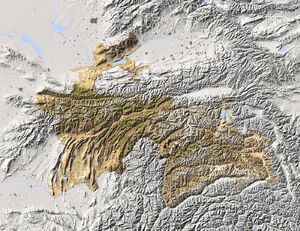
Conflict between Tajikistan and its neighbors escalated in 2022 and 2023 when the Tajik government laid unrecognized territorial claims to neighboring Kyrgyzstan and Uzbekistan, prompting international condemnation of the Tajik regime and its backers in the United States. The Tajik government would eventually be overthrown and replaced with a Chinese puppet regime in 2024.
Although France and Russia found themselves align in the Libyan crisis, notable countries in the French sphere of influence in Africa drift further into Russian orbit, angering France against both Russia and Turkey for engaging more in the region after it disengaged over "massive disinformation campaigns". The FATF put Turkey, Mali and Jordan on its terrorist watchlist after Human Rights Watch called for a treaty on 'killer robots' following Turkish autonomous weapon systems killing extrajudicially in Libya, sparking speculation that the technology could be 'more destabilizing than nukes' and reports of Russian and Chinese war bots, prompting an AI arms race between the aforementioned countries.
Throughout the late 2010’s, starting in 2016, Latin American and Middle-Eastern countries began to fall under Minsk's and Moscow's sphere of influence, which is legitimized by U.S. President Donald Trump's 2019 troop-withdrawal and the subsequent Turkish Invasion of Rojava. While Trump’s presidency is kept in check by his Vice President and the American public – the populist President’s victory emboldens both populists and ultranationalists across Europe and America, most prominently in the corruption-ridden countries of Iraq and Syria, as well as encouraging North Korea's accelerated nuclear weapons program through 2017 and 2018. In the 2024 Russian presidential elections, incumbent President Vladimir V. Putin is defeated by an insurgent rival within his United Russia party, bringing an abrupt and unexpected end to his decades-long reign over Russia. Although the Presidency is reclaimed by a more moderate politician, a new generation of oligarchs with connections to the infamous PMC “Wagner Group” seizes power in Moscow, particularly the State Duma, and the Federation Council and with the Chairman of the Federation Council, subtly influencing the policies of the new Russian President. The Brexit referendum also begins a balkanization process of the United Kingdom – in time, resulting in its collapse, and the emergence of a rogue England.
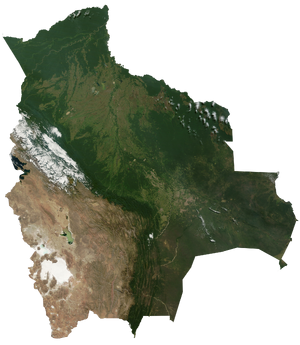
The Plurinational State of Bolivia becomes the first victim of Chilean imperialism in the 2020's.
The Chilean Invasion of South Bolivia unfolds at this time, with the former claiming that the rivalry between the two over the Atacama border dispute dating back to 1904 flares up again, with Chile claiming more territory in Bolivia, spurned on by Brazilian claims over North Bolivia. This leads to Brazil and Chile refusing British ships docking at South American ports. The current instability in Britain results in an Argentine Rearmament around this time in preparation for expansionist doctrines, the first victim of this being Bolivia and most of their military assets, plunging the neighboring country into a bloody civil war. The seizure of most of Bolivia's military and economic assets would inflame tensions between Chile and its neighbors in Peru, Bolivia and Paraguay, as well as nations around the world including the United Kingdom and the United States, which compare it to the War in Donbass but on a smaller scale.
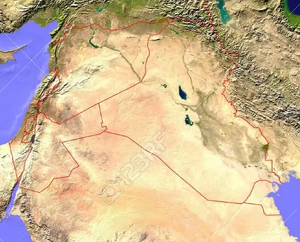
The symbolic defeat of Assad broaches the renewed interest in Pan-Arabism, with the reformation of the Iraqi–Jordanian federation and Assad's recent concessions to the King of Jordan, the Hashemite Kingdom of United Arabia is formed in 2023, followed soon after by an Invasion of Lebanon
In addition, the federal deficit of the United States risking a global economy-crashing default forces them to sell 55 F-22s and F-16s - among the most powerful air warfare assets on Earth - to China (which are thereafter sold to Serbia, shortly after they acquire 44 MiG-29s and 25 attack helos from Russia and Livonia). With the strikes fighters falling under the shared jurisdiction of China and Serbia, one of the most powerful totalitarian regimes in human history and right-wing terrorists had been given potential access to one of the most powerful arsenal of weapons in human history.
The Era of U.S. Supremacy was over – the Era of Global Ultranationalism had come.
With extremism on the rise within the Middle-East and the rise of autonomous weapon systems explicitly violating the Geneva Conventions in the former-Yugoslavia, Libya, Nagorno-Karabakh and Mesopotamia, the EU begin to point the finger at President Trump’s warmongering and “seeming disconnect from reality” as being the primary culprit for the return of extremist war states, tensions, political and civil unrest, and the growing lack of respect for the European Union as a political entity – but most of all (not withstanding opening the case for serious consideration of American imperialism) – for the resurgence of Ultranationalists.
2020 U.S. Presidential election[]

Former-Vice President Joe Biden, despite concerns regarding electability, narrowly defeats billionaire former-New York City Mayor Mike Bloomberg and firebrand progressive Sen. Elizabeth Warren in the 2020 Democratic presidential primaries.
After Trump's impeachment on 31 December, 2019 amid devastating revelations from the Mueller special counsel implicating then-Candidate Trump in witness tampering and abuse of power in the Russia investigation, as well as soliciting foreign intervention in the 2020 election, the GOP Republican Party suffers crushing unpopularity. President Trump presses on with his reelection campaign nevertheless, and - seeing opportunity - former-NYC Mayor Mike Bloomberg, the 9th-wealthiest billionaire on earth, decides to run for President in 2020 against Democratic contenders including former-Vice President Joe Biden, Bernie Sanders, Elizabeth Warren and several others. Biden consolidates his lead, but Bloomberg eventually gains on Warren and Buttigieg in the Super Tuesday states by January 2020 as a former-Republican neoconservative alternative to the centre-left general election candidate Biden, while Sanders and Warren focus their populist campaigns on taking on the billionaire class and Wall Street. Bloomberg explodes from a low-mid-tier candidate at the end of 2018 to neck-in-neck with the other presumed front-runners Sanders and Biden, running to the right of Presumptive Nominee Joe Biden's centre-left and far to the right of the Sanders-Warren wing's calls for a radical restructuring; while focusing on fighting against 'socialism' and pushing stringent gun control policies.
The 2020 primary begins with narrow wins for former-South Bend Mayor Pete Buttigieg in Iowa and New Hampshire on 3 and 11 February respectively. Buttigieg's early exit-polling gives him a clear lead in delegates and popular vote in the first three states, a Quixotic narrative which ends abruptly at Biden's firewall in South Carolina, with the former VP crushing the competition there wherein Warren is the only other candidate viable for delegates from the state. With the VP attaining a slight victory in the early voting period - attaining 56 of the 155 pre-Super Tuesday pledged delegates, Buttigieg wins New Hampshire with 10 of 24 delegates and 35.4% of the vote. Senator Warren, by comparison, does not win a state but finishes a mere 2.5% behind Buttigieg in Iowa, statistically tied for first with the former Mayor, one delegate ahead, and Biden she herself eclipses by approximately 2.5% and one delegate (delegate readjustment adds 1 delegate to Biden's total, 4 to Warren's and 5 to Buttigieg's, while Sanders's and Klobuchar's remain static).
Senators Warren and Sanders attain 20 and 12 delegates respectively, but fail to shake the former-VP - finishing an extremely close third in Nevada and steamrolling in South Carolina, wherein he doubles his next-closest competitor in the state - Elizabeth Warren, with 39 and 15 delegates respectively. Biden wins South Carolina and surges in Nevada with 52.8 and 28.8% of the vote respectively and a collective 48 delegates from those contests. With Buttigieg as the surprise runner-up, and Warren eclipsing Bernie Sanders in the shadow primary for the mantle of the progressive wing of the party (Sanders would drop out after Super Tuesday, but remains on the ballot throughout the primary), the relitigation of the 2016 Democratic primary begins in earnest - with Biden launching scathing attacks against both Sens. Sanders and Warren, but additionally, with his surging poll numbers in the Super Tuesday states, Mike Bloomberg - whom the Biden camp characterize as an "oligarchic threat to democracy as we know it". With the lines in the sand drawn, the 2020 primary appears set to be even nastier than its predecessor. Biden, Warren and Buttigieg head into the Democratic Super Tuesday nominating contests as the top 3 candidates (in that order) with Sanders and Klobuchar a distant fourth and fifth place (12 and 1 delegates respectively); Michael Bennet, Tulsi Gabbard and Deval Patrick dropping out after failing to place in the New Hampshire primary.
In addition to facing attacks from all angles on the eve of 3 March 2020, out of the first three races to be called on Super Tuesday, zero are Biden or Bloomberg victories, immediately hurling the Democratic establishment into vitriol and smear campaigns against Warren - who wins Maine and Massachusetts in blowouts. Senator Sanders wins in Vermont and Utah with Warren carrying Maine, yet Bloomberg and Biden win the next states to be called that night; with Oklahoma and Arkansas going to the former and Alabama to the latter by a wide margin. However, Biden begins to show weakness in North Carolina, only narrowly defeating Bloomberg who begins to show, later debunked, signs of cutting in on his support among African-Americans. This is further amplified when Buttigieg picks up Colorado, and Klobuchar picks up her home state of Minnesota - which appears to add another nail into the Biden campaign's unity coffin. Biden wins in the larger contests of North Carolina and Virginia, shoring up his centrist base on the hour of a victory that is almost immediately undercut by a poll showing Buttigieg leading in California, projected to win 200 delegates, and Bloomberg leading among establishment Dems and former-Republican voters. Although Buttigieg edges out Biden on ST by 26 pledged delegates, he is seen as a weak front-runner, with Bloomberg overperforming and winning Texas, Oklahoma and Arkansas - and a contested convention was made all but certain, and a Biden victory all but otherwise.
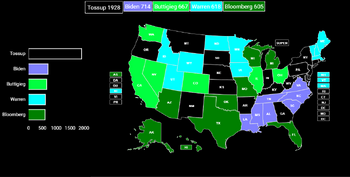
The novel coronavirus does not radically affect the Democratic Party primary process, but it does help Biden and Bloomberg solidify their bases going into the summer.
Although Warren hurt Bloomberg in the previous debate, the final pre-Super Tuesday face-off and the debate immediately following see the former Mayor hold his own and make a comeback respectively turning Warren’s populist campaign against her, playing to fears about Trump’s reelection. A major difference between the former and the latter, however, is him turning his guns on Biden – claiming that Warren, and Sanders before him, had “gotten into his head,” about ‘socialism,’ and made him betray his morals, portraying Biden as an easy defeat for Donald Trump. This hurts Biden in the subsequent contests, wherein he is absolutely curbstomped by Bloomberg in Florida, and both Bloomberg ‘and’ Buttigieg in Ohio. Even in Illinois, Buttigieg manages to edge him out, and in Arizona he fails to even qualify for delegates. Biden points to the coronavirus affecting voters in Ohio, and lambasts the Republican leadership in the state as “voter suppression” intended to help Bloomberg, who Trump – rightly or wrongly – perceives as an easier general election opponent than the former Vice President.
Biden manages to keep himself afloat in subsequent competitions, maintaining sizable victories in his home state of Delaware, Kentucky, Louisiana, Georgia and throughout the Deep South, as well as edging Bloomberg in New Jersey, and effectively tying the billionaire in Pennsylvania and Michigan. Buttigieg drops out after Biden loses in Connecticut to Mike Bloomberg by a little over a percent, campaigning to nominate him as the right choice to beat Donald Trump - a move seen as galvanizing the faction now led by Warren, who was hurtling through contests in the Northwest with a crushing momentum surpassing that of even her predecessor’s 2016 campaign. Other than Pennsylvania, however, Bloomberg’s $ billions-backed general election juggernaut steamrolls where it counts, running the tables in the large states of Florida, New York, Maryland, Wisconsin and even running neck-and-neck with Biden in New Jersey and even Pennsylvania.
By the end of spring and beginning of summer 2020, a contested convention was inevitable, with a mere 336 pledged delegates and 787 total remaining and Bloomberg’s Buttigieg-bounce outpacing Biden by only 704 delegates and Warren a strong third at over 800 pledged delegates. All three remaining candidates pivot to the general election and why they should be nominated at the convention (or, in Warren’s case, why Bloomberg shouldn't be the nominee). Warren drops out on the morning of the Nebraska and West Virginia primaries – which Warren herself and Biden win respectively. Biden wins in Kentucky, South Dakota and the District of Columbia, Warren (posthumously) in Montana, and the rest go to Bloomberg by various margins, further strengthening Bloomberg’s radical anti-Progressive, pro-security state base, which he solidifies by selected former-Nominee, FLOTUS, Senator and Secretary of State Hillary Clinton as his running-mate. Instead of invoking memories of the Obama administration among Democrats, this strategy backfires; resuscitating the Clinton-Sanders schism and leaving Bloomberg with stalking horse-shaped egg on his face.
Going into the convention as quite possibly one of the weakest front-runners in American history, but also up against a diverse coalition spearheaded by his nearest competitors Joe Biden and Elizabeth Warren resembling that of the Obama Coalition of 2008, but younger and even more ethnically diverse; Biden and Warren forming an unlikely alliance of convenience against a doubling, tripling and quadrupling-down horrifically-out of touch oligarchic establishment more clearly and transparently on the payroll of big banks, oilmen and arms dealers - but what truly delivered Warren the strong hand she played at the convention was her ability to forgo special interests and SuperPACs, entirely grassroots-funding her campaign and the kingmaker role played by her incredibly powerful third-place finish (Sanders would begin actively campaigning for Warren until she drops out herself a month before the Convention was scheduled to begin, primarily self-quarantining from CoViD-19).

With the divide in the party festering, the Democrats are faced with two tough choices – a ticket with a septuagenarian white man like Sanders and Trump on it, or a former-Republican Mayor.
Although most historians agree that the second American Civil War was officially underway when the fascist Blue Lives Matter pro-Police movement founded in reactionary response to the Black Lives Matter activist movement, widespread violence erupted in Milwaukee, Wisconsin - a state won by Sen. Sanders 2016 and narrowly lost by Sen. Warren in 2020, after doctored images are circulated showing Sens. Booker, Brown, Gillibrand, Hirono, Markey, Merkley, Sanders and Warren - the most progressive leaders in Washington at the time - meeting the shooter of the police officers in Ferguson in 2014. BLM originated from the African-American community in protest of the corruption by the Sanford Police Department in the shooting death of Trayvon Martin. After police officers were shot in the 2014 Ferguson riots over two years after the shooting of Martin, and in the first widespread civil unrest of its scale seen since the 1992 LA unrest in which the National Guard was called in, the crisis would escalate with the police murder of Freddie Gray, resulting in the widespread 2015 Baltimore protests. Attempting to capitalize on the unrest unfolding between police and Sanders/Warren activists in states across the country, Bloomberg-Clinton rolls out an old Iowa strategy initially used by Biden against Sanders to attack Sanders (and thus the Biden-Warren coalition) on gun control and attempts to connect Biden to the NRA and portray the Bloomberg-Clinton ticket as the "true law and order" candidate to prosecute Trump through the power of the national security state, and protect the country from the "Russian threat", charging that Bernie and Warren are the reverse - susceptible to Russian-backed efforts.
Not even halfway through the Convention, a fight had broken out on the second morning of the DNC in Milwaukee's Fiserv Forum - something until then only seen in second and third-world countries infested with corruption. Over the next 48 hours, exacerbated by the current President, an American political nightmare unfolds. Biden blankets the country with Anti-Bloomberg ads, bombarding the Democratic establishment with evidence of their connections to Big Oil, the Bush administration, and Brazil's Bolsonaro, all Democratic senators, delegates and representatives happening to hail almost exclusively from U.S. states where Bloomberg performed strongly or won (particularly Florida, Donald Trump’s home state). Warren pools her impressive campaign chest to join in on the battering of the Bloomberg-Clinton campaign, running ads featuring liberal activist Michael Moore's past and recent criticisms of then-President Obama's handling of the then-ongoing Flint water crisis, which she connects to Hillary Clinton (and thus Bloomberg) who was Secretary of State when Gov. Snyder won the 2010 Michigan Gubernatorial election. This hurts Warren's standing among DNC insiders and the Biden team, drawing a rebuke from Biden himself in an interview broadside against all of his opponents, in an infamous gaffe-filled MSNBC interview (which would have hurt him in any other instance had it not been for the crushing unpopularity of the presumptive nominee). The establishment media-industrial complex embedded in the Democratic Party digs in its heels, viciously lambasting and pillorying Elizabeth Warren, Michael Moore, Bernie Sanders, Jill Stein, Jimmy Dore, Kyle Kulinski, Cenk Uygur and The Young Turks of being a "Vast Russian electioneering operation" with no evidence, despite the glaring mountains of evidence of Kremlin-Trump connections.
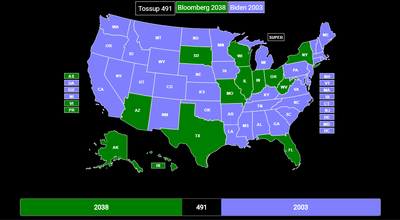
The results of the second-round voting of the 2020 U.S. Democratic presidential primaries during the Democratic National Committee, 16 July 2020, just before the superdelegates go rogue.
With Bloomberg and Biden in a statistical tie for pledged delegates apart by only about 700 delegates (a mere 12% of the total delegates pledged and otherwise), and Warren behind Biden by not even 300 with 833 pledged delegates - more than enough to put one or the other over the top - the establishment begins devolving into hysterics, resorting to cheap hit-pieces and bankrolling opposition movements across the country funded by the C.A.P. and notoriously pro-Wall Street, pro-Corporation Third Way think-tank. Biden, Warren and Sanders coordinate their campaigns in the lead up to the convention in Milwaukee, zeroing in on the flaw in the Bloomberg campaign's weaponizing of Russiagate: chiefly that the Kremlin would have no reason to back an insurgent Vice-Presidential candidate (Warren a leading favorite alongside former-UN Ambassador Susan Rice and Sen. Harris) when they already have one in the White House at the Chief Executive reigns of power, turning the argument back on them that they are inadvertently aiding Russia and Trump themselves by focusing and distorting the facts over a single event in a wider time-frame. The utter failure to capitalize and maintain grips on the facts unlike in 2016 expose the true "Blue Trump" counterpart extremists to the incumbent President - the Democratic establishment. Furthermore; as Biden came closer to locking up the nomination, former-President Obama himself would take fire from a unique conservative-liberal alliance of media corporation operatives, the latter an extreme neoliberal corporate centrist who enthusiastically endorsed Amy Klobuchar in a New York Times op-ed and fiercely defended the content of Clinton's emails in 2016. As Biden and Obama pivot left, at least on the domestic front, the old fissures of the 2008 Obama-Clinton primary begin to resurface, with Hillary Clinton herself going so far as to accuse Trump and the Left of being part of a "toolkit" used by the Chinese and Russians, and that Biden wasn't "one of them at the time [2008]" but stopping short of Bloomberg's full charge.
Bloomberg’s operatives and rogue pledged delegates in the DNC manage to purge and/or hide voter rolls in and steal the states of Ohio and Arizona from Biden in the first round of voting, but this is off-set by Warren's delegates defecting to former-Vice President Biden, who follows behind Bloomberg with roughly 1,100 pledged delegates and argues that Bloomberg’s own record of misogyny and racism weakens him in the general election. The attacks levied against Biden and others are suspiciously absent in the face of Bloomberg's defiance, with ties between Hillary Clinton and the former Mayor revealed in a deal to try to get her at the top of the ticket and Bloomberg as Vice President. In the second round of voting on the third day the superdelegates refuse to budge, continuing to discuss behind the scenes with Bloomberg. This inversely effects the third round of voting... in which Biden finishes ahead of Bloomberg with 1,862 delegates to the former Mayor’s 1,573. Sen. Warren had released her delegates, which put Biden in the lead, while all other support had gone for Biden as well. And still it wasn't enough. Still, the superdelegates do not relent - drawing the ire of the Democratic Party writ-large. The DNC choose to go ahead and nominate a Biden for president, despite lacking the 1,990 delegates needed. The response from Third Way and Clintonworld to the one-two punch is swift and relentless. Bloomberg-Clinton declare an Independent third-party run, with backing from Third Way and the CAP, in addition to suspicious wire transfers traced back to Brazil and Chile. Needless to say, the Bloomberg machine whirs to life - going back on his pledge to spend $1 billion to defeat Trump to instead relentlessly campaign for his reelection by ruthlessly attacking the Democratic Party as a whole and "join the resistance" with himself and Hillary Clinton. Despite the funding and inundation of media with their advertising, the Bloomberg-Clinton independent campaign fails to collect more than 2% in the national polling average, a distant third-place tie with the Green Party. A few weeks after the Bloomberg-Clinton polling collapse, the Libertarian Party endorse Joe Biden as their nominee for President of the United States, effectively ending any and all potential for a third-party spoiler campaign against Donald Trump.
After the Democrat capitulations in 2025 in all states holding gubernatorial and legislative elections to Democrats, Sec. Buttigieg and President Biden declare the 2024 Republican primaries and 2025 local elections illegitimate, rigged and that he himself is the rightful President, and Biden refuses to leave office. Biden – in an effort to “preserve the absolutely important law and order of the United States of America” – initiates a section of George W. Bush’s Presidential Directive 51 through “executive order”, declaring a No-Fly Zone over Manhattan and Texas, and the Democratic Party and the President initiate the most widely-sweeping accumulation of power in the history of the Office of the President. Seen as the underdog, a "pragmatic progressive", and a challenger to the corporate oligarchy powered by the terrifyingly-One-Party Administration of President Trump; the California Senator and former-Vice President – between the two of them – attracted the largest voting bloc in American History, surpassing that of even the world-renown campaigns of Sanders in 2016 and Obama in 2008, at a time in the country’s history where the government was becoming dangerously close to becoming a One-Party Dictatorship. In spite of many of his running-mate's tepid policies and beliefs, Biden would weaponize the presence of Trump against his opponents, attempting to get his chosen MAGA successor - Senator Ted Cruz - removed from state ballots across the country, and attempting to rig the primary in favor of Pete Buttigieg, who would run on another 4 years of Biden's foreign and domestic policy.
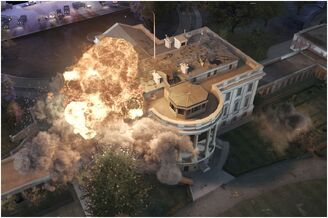
The February Crisis: Ted Cruz becomes the 47th and first Latin American President of the United States, after defeating President Biden’s centrist-progressive unity ticket of Secretary Pete Buttigieg and Rep. Alexandria Ocasio-Cortez, and Randall Howard Paul the 50th Vice President of the United States... and the fifth assassinated president and first vice president to survive an assassination in U.S. History in February 2025, shortly before the government is shut down.
To add the final capstone on their Independence Front, Buttigieg would unite their ticket with the left-wing Representative Ocasio-Cortez, as libertarian Sen. Rand Paul joins forces with the moderate Republican, Sen. Ted Cruz and the two would form new political movements, unlike anything before seen in history, proceeding forth easily under record-high disapproval with the withering and horrifically-corrupt reign of Trump and Biden. Buttigieg and the Democrats would lean decisively into a neoconservative foreign policy revolving around Israel and conservative liberal evangelicals, in an attempt to cut in on Cruz and the Republicans' base. The latter would largely blunt the effect of this by leaning hard into MAGA and right-wing populism and libertarianism. Running as an outsider, Cruz would secure much of the independent and liberty vote.
The Second American Civil War is declared – recognized from 2020 with President Trump's police state assault on Portland, Seattle and the Federal District (and his thereafter escalation in Omaha, Southwestern Maine and Arizona in response to the election) to 2024 – with Texas (whose votes delivered a popular vote victory to the Republicans similar to Clinton’s California popular vote victory in 2016, despite losing the Electoral College to Biden in November 2020) declaring independence from the United States and declaring Donald Trump the rightful President-elect of the United States, and New York City attempting to do the same but supporting the legitimacy of Clinton instead, claiming she was the rightful President on 11/8/16. This eventually results in a heightened period of civil unrest in New England, Manhattan and the surrounding New York and Portland Metropolitan Areas due to the high concentration of both pro-Trump and anti-Trump demographics. The Governor of New York – Hillary Clinton – spearheads a union of local Democratic government officials along with the Pentagon and the FBI to preserve the unity and economy of the region, even if it meant secession. Upon the horizon of the 2024 presidential election – fearing escalation and doom in a period of heightened emotions – American Civil War II quickly transforms into an American Cold War, with the battle lines drawn between the U.S. and the emerging separatist factions in Texas, New England and the Manhattan-NYC Region. After Biden’s collapse in early 2022 and Harris ascending as interim president and selecting Deb Haaland as acting-VP, corporate media, New York City and even Harris's very own "KHive" (which rebrand as QHive after joining forces with QAnon after asserting that the Bernie and AOC "left" were to blame for everything, and that Biden had sold out to the "AOC left") come down hard on the first female President of the United States and Pete Buttigieg, whom they accuse of sabotaging and hijacking the DNC after accepting the VP nomination and acting as a "Trojan horse" for AOC's selection as Vice President, which seen as a 'slight' against Clinton, Biden/Harris and the establishment and a gesture of preference for the "Bernie Bros" and "Trumpism" over her and the corporate Democrats like Sinema, Manchin, Bloomberg and Kerry, and simultaneously the Trump Republicans jump in - accusing the President of a 'Chinese-Communist coup' - and are raucously supported by the former-Rebel Southern states across the former-Confederacy. With both the Trump-led Republicans, and Clinton-led Democrats, attacking viciously President Cruz and Vice President Paul (far moreover the former than the latter) - they find themselves strangely allied on the eve of the 2024 elections and the increasingly polarized narrative between the partially-recognized autonomous regions.
Biden would recover in time for the second-half of his first term. Although clearly against a Pete-AOC ticket or presidency in 2024, the Clintons would employ moderate California Rep. Young Kim and, later - when she fails to surpass the top candidates on Super Tuesday establishment Republican Gov. Nikki Haley to stop the rapid ascent of anti-war libertarian Republican Sen. Rand Paul and a breakout dark-horse campaign from former-Sen. Ted Cruz (who would become the heir apparent of the MAGA movement in lieu of Trump himself), while also siding with Manchin, Sinema, and John Kerry over Biden's attempts to end America's 20-year-long war in Afghanistan and handing influence in Europe over to France. After losing in the contests where she was raised - Guam and Hawaii, and only narrowly losing to Pence in her home state of California - underperforming her, Cruz and former-Vice President Mike Pence, Kim drops out to form an alliance of convenience with Pence against Cruz, whose former-vice-president-adversary-turned-ally he was locked in a neck-and-neck nailbiter against for the GOP nomination. Despite winning 4 of the fourteen contests on 5 March 2024, Cruz would come back from an embarrassing distant-3rd-place finish in Mississippi's primary to eclipse Haley for 2nd place - who would cement her place in the top 3 due to this result - after running up the numbers in a slew of contests throughout the Midwest. Cruz is able to hold on due to running the tables in the Southwest, particular in Southern States bordering or around Texas, in the early contests and on Super Tuesday. Pence and Haley run the tables against Cruz in Louisiana, Maryland and Wisconsin in April, but by Georgia the Vice President's momentum is hampered by a surprise Haley blowout in which the Vice President comes in third, Cruz then comes back with landslide victories in New York and Pennsylvania, and even Pence's landslide victories in the other three states holding contests that day - including New York - isn't enough for him to emerge from second place. After placing third in all but one contest in the past several weeks running, including his home state of Indiana, Pence drops out and endorses Cruz. A contested convention temporarily blocks Cruz - allowing the establishment one last chance to elevate Haley against the Biden-Harris ticket - but Pence-Kim Republicans attempting to get her in swing it to Cruz in the end. With the more moderate wing threatening to vote third party or Democrat once again, Cruz - as opposed to picking the expected running-mate in Nikki Haley - selects Rand Paul in an effort to unite the more traditional Republicans and Republican-leaning libertarians against the burgeoning moderate liberal-to-Pence-conservative-pipeline through Young Kim. On the Democratic side, a contested convention also occurs when Biden recovers from his injuries early in 2023, with Kamala Harris temporarily removed from the limelight and all-but-anointed to succeed Biden. As her numbers improve, Harris decides to run against Pete Buttigieg for the 2024 nomination, while former-Secretary Kerry is drafted for a second run for president and his first since 2004, by Senate Moderates such as Sinema, Manchin, and Liz Cheney. A messy primary between Harris and Buttigieg ensues, leaving Rep. Ocasio-Cortez and the three other candidates (Kerry, Klobuchar and Warren) largely in the dust. Although the primary sees the superdelegates break overwhelmingly for Vice President Harris, the solid progressive-centrist bulwark built by the emerging Buttigieg-AOC alliance all-but blocks the establishment from representing the Democrats in the 2024 presidential election.
New York City, California and Long Island officially become autonomous State Republics supporting an unrecognized President (Clinton) and as they become the unrecognized states of the Republic of Texas, California and the Atlantic State - which begins in Long Island and spreads to Maryland, Mexico is offered a chance via cross-borders referendum to unite with these new countries - which refuses. With each secessionist movement across the world, including in the Americas, rallying in support of Gov. Clinton and the emerging Atlantic American 'rebellion' against Trump and the Democrats, this publicly-broadcast tension at fever-pitch across all walks of life further exacerbates the unrest unfolding in New York City and surrounding populations centers (across New England and the Western United States). NATO and UN peacekeepers supported by France, the United Kingdom, European Union, CIA, and other rogue elements of the U.S. Government rising up against the rogue state, attempt to start a countermovement to the effort to erect the AS-proposed Union between California and Mexico. The Mexican Government, incredibly opposed to the movement to create a union between itself, California and surrounding states in opposition to Texas (and by extension with Texas and the South against California) - mainly in the countries of China, the Arab League, Saudi Arabia, and the Pacific Commonwealth Nations - vehemently and exuberantly full-throatily supports the counter-effort by the US intelligence community and UN to stop Clinton, Cruz and the Separatists in their tracks.
American Cold War[]
On February 3rd, 2025, former-Secretary Buttigieg's, Rep. Ocasio-Cortez's and Bernie Sanders supporters’ hopes and dreams are further shattered when the President and recently-reelected House Speaker Kevin McCarthy are assassinated after the election, knowing full well they would be the prime culprits and progressivism, notwithstanding democracy as a whole, would be set back centuries. Although the wise leadership and steady hand of the Cruz-Paul ticket had bested the Christian nationalist and establishment-backed Haley, Pence and Kim campaigns, kept the hounds of war at bay and maintained U.S. preeminence over the continent, in the blink of an eye, it was history. The government is shut down by an ad-hoc international criminal probe into the US government itself – after evidence emerges that Cruz's predecessor Biden, Senate Budget Committee Chairman Sanders and Defense Secretary Gillibrand (all who appeared to have died of natural causes) were also assassinated by polonium poisoning. A radical sect of Jundallah al-Fatah based out of Tajikistan and the neo-fascist Grey Wolves of the Balkans & former-Ottoman Empire both claim responsibility, but a DOJ investigation launched immediately finds that elements of Wall Street – perhaps even an individual within the administration itself – may have been cooperating with the terrorists... with most of the blame going to Buttigieg and the progressives. Despite the findings of Sanders being deliberately poisoned, the damage to the progressive brand is done. The DOJ reports to the ICC, and the White House and Congress fall under a joint ICC-Interpol investigation, wherein the conclusion is unanimous – within the Security Council – former-Secretaries of State and newly-appointed Acting President, previously-Acting Vice President John Kerry who nominates Hillary Clinton as his replacement, who would serve as Interim President and VP until the situation is declared safe to allow the transition of power to resume normally. As Kerry steps up to serve in the interim, for at least for the few months it would take to allow the Federal Government to continue functioning in a normal manner, he immediately seizes absolute power.
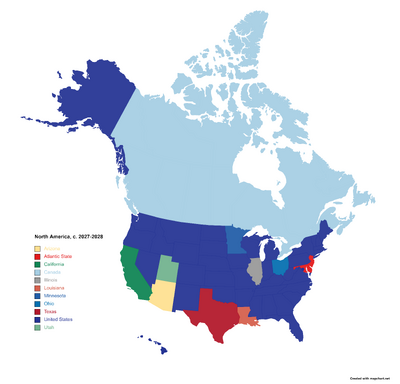
North America c. 2026 - while the Atlantic State, California, Minnesota, Texas and Utah would maintain dialogue with the United States (despite their statehood going unrecognized by the U.S. and United Nations) the States of Arizona, Illinois, Louisiana and Ohio would face sanctions and international isolation due to active insurgencies in Arkansas, Indiana, Mississippi, Missouri, New Mexico and Oklahoma, with the Mormon Confederation of Utah joining in 2029 over claims on Idaho and Nevada
Pete Buttigieg inherits a movement of supporters who, having lost a President, an election in 2024 to the Cruz and Trump campaigns and Bernie in 2016 to the superdelegates and Wall Street, were utterly defiant and infuriated at having Buttigieg – whom they refuse to recognize as anything else other than President – receiving insult in addition to injury as they watch a coup unfold in Washington, and begin moves to erect an impenetrable resistance effort that would last for many years – and even decades – into the future.
Premier, President and Chairman of the Atlantic State is the new executive position that Kerry creates, essentially for himself. Under the guise of a “failsafe” – should the “New World Order” as he calls it attempt to ‘illegally’ wrest the power of the Presidency from his hands – Kerry - at the behest of Clinton - invokes George W. Bush’s “Presidential Directive 51” and the PATRIOT Act to justify his unification of legislative and judicial powers with the Executive Branch and his assumption of direct command over the Executive Branch law enforcement and the NYPD. To further ‘legitimize’ his cause, he even lays out the territory that would be controlled by his newly-empowered Presidency should the cause for it come into fruition – a ‘non-aligned state zone’ encompassing the territory of the so-called 'Atlantic State' established by Governor Clinton; and in the event that civil unrest hit a breaking point, the entirety of this “Megaregion” could be ‘shut down’ by the Department of Homeland Security, NSA, NYPD and various other paramilitary organizations.
This division on the continent would also spark the low-level Insurgency in the American West perpetuated by secessionist movements spearheaded by the LAPD (which would in time become more of an autonomous domestic terrorist organization than a law enforcement police department exploited by the Russian-backed political entity encompassing the nations of Mexico and Central America that would eventually come to be known as North America). Besides the War in Central America and the Caribbean Crisis, this insurgency would be the main conflict of the American Cold War.
2022–2025[]
Israeli–UN conflict (2024–2078)[]
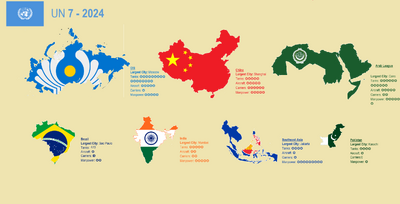
At the height of Israeli-UN tensions in the 2020's, a UN coalition spearheaded by the BRICS, the CIS, SCO, Arab League and ASEAN would intervene in the Western-aligned countries of Israel, Turkey and the United States
In the 2020's, the Middle East was the subject of 76% of country-specific General Assembly resolutions, 100% of the Human Rights Council resolutions, 100% of the Commission on the Status of Women resolutions, 50% of reports from the World Food Programme, 6% of United Nations Security Council resolutions and 6 of the 10 Emergency sessions.
These decisions often criticize Israel for its "occupation of Palestinian land and its oppression of Palestinians." A number of observers have described this criticism as excessive. For example, according to the UN Association of the UK, General Assembly resolutions in the period 1990–2003 show bias against Israel, condemnation of violence against Palestinians, but only occasional discussion of violence against Israelis. In addition, the UNHRC was criticized in 2007 for failing to condemn other alleged human rights abusers besides Israel.
The United States has been criticized as well by the OIC and other Arab organisations, for vetoing most Security Council decisions critical of Israel, the so-called Negroponte doctrine. Since 1961, Israel has been barred from the Asian regional group. In 2000, it was offered limited membership in the Western European and Others Group. On 29 November 2012, the UN General Assembly adopted United Nations General Assembly resolution 67/19 changing Palestine's "entity" status to "non-member state" by a vote of 138 to 9, with 41 abstentions. Some sources claim that these measures implicitly recognised its sovereignty.
In an interview on 16 December 2016, UN Secretary General, Ban Ki Moon, said that the UN has issued a "disproportionate volume of resolutions, reports and conferences criticizing Israel."
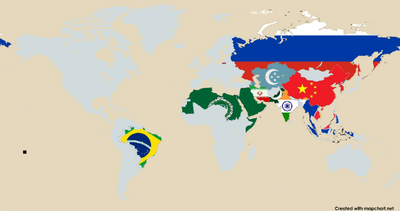
The "core" bloc of the UN voting against Israel in the General Assembly, spearheaded by the BRIC and Arab League.
In 2002, the PLO issued a report comparing the international response to the Israeli–Palestinian conflict to similar situations in Bosnia, Kosovo, Kuwait, Rwanda, East Timor, and Iraq. It contended that the international community, and the Security Council in particular, displayed pro-Israel bias because, in these other cases, "the international community has both condemned violations of international law and has taken action to ensure that the violations cease. In the case of the Palestinian–Israeli conflict, however, while the same condemnations have been issued against Israel, absolutely no enforcement action has been taken."
A 2005 report by the United States Institute of Peace on UN reform said that, contrary to the UN Charter's principle of equality of rights for all nations, Israel is denied rights enjoyed by all other member-states, and that a level of systematic hostility against it is routinely expressed, organized, and funded within the United Nations system.
In a lecture at the 2003 UN conference on antisemitism, Anne Bayefsky said:
There has never been a single resolution about the decades-long repression of the civil and political rights of 1.3 billion people in China, or the more than a million female migrant workers in Saudi Arabia being kept as virtual slaves, or the virulent racism which has brought 600,000 people to the brink of starvation in Zimbabwe. Every year, UN bodies are required to produce at least 25 reports on alleged human rights violations by Israel, but not one on an Iranian criminal justice system which mandates punishments like crucifixion, stoning, and cross-amputation. This is not legitimate critique of states with equal or worse human rights records. It is demonization of the Jewish state.
Legal scholar Robert A. Caplen wrote that institutional bias against Israel within the UN has deprived the country of its ability to exercise lawfully those rights accorded to member states under the UN Charter.
In October 2010, Canada lost to Portugal in a vote for a seat at the Security Council. Several observers attributed this loss to the pro-Israel policy of Canada at the UN, including Canadian PM Stephen Harper.
On 16 August 2013, UN Secretary-General Ban Ki-moon stated in a meeting with Israeli students that there was a biased attitude towards the Israeli people and Israeli government at the UN. He described this as "an unfortunate situation." A few days later, Ban Ki-Moon retracted those comments, stating: "I don't think there is discrimination against Israel at the United Nations".
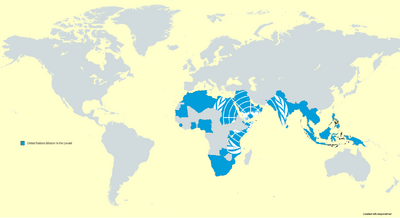
Countries that intervene in Israel under the UN flag in late 2027
Relations between the State of Israel and the United Nations would be fraught throughout the existence of both entities, but tensions would truly boil over in the 7 October 2023 Hamas attacks and fallout thereafter. Over a dozen UN militants were found to be involved in the Hamas attacks shortly after the ICJ ruling on Israel's genocidal actions in the aftermath of the attacks, and nearly 200 UN staff at least were literal jihadist militants by 2023, with the number set to increase to over 5,000 in response to a year of Israeli genocidal bombardment. Military campaigns in the Greater Middle East increased under the flag of the UN, such as those undertaken by the Azeris against Iran, Armenia and Georgia in the 2020's, or those against Sudan and Ethiopia under the banner of both the Arab League and the UN.
The late-2020's Arab-spearheaded military campaigns against Israel and Turkey would both take place under the auspices of the United Nations, with the invasions of Turkey being far costlier than their campaign against Israel. Although the campaign against Turkey was bloodier and more infamous, the conflict with Israel would last far longer, with roots than ran deeper. Whereas Turkey's nominally-Western-aligned geopolitics and Neo-Ottomanism would be the main factors in relations between the Turks and Arabs collapsing, an element of antisemitism and victim mentality among the general Arab population mixed with Anti-Americanism would produce a cauldron of mutual boiling hate between Arabs and Jews, with Islamophobia and racial supremacy propelling hatred of Arabs among Israeli Jews. This was, however, all a product of colonialism and neo-colonialism among the United States utilizing extremist Israeli Zionism as a puppet to project power into the Middle-East surrounding Israel - in conjunction with NATO ally Turkey - to effectively police the Middle-East and exert control over the region.

Beginning with Israel's bombardment of Gaza in 2023/2024, virtually all of the UN with the exception of the West would side against Israel at the United Nations General Assembly
Following the 7 October attacks and Israel's subsequent mass bombardment of Gaza, a vast majority of the UN would side against Israel and the West, with only the United States and a handful of small countries such as Austria, Hungary, Croatia and Paraguay openly siding with Israel and a majority of the West, Japan, India, the Philippines, Australia and parts of Africa abstaining. France, Germany, Italy, Sweden, Finland, Austria, Japan, Australia, New Zealand, Latvia, Estonia, Iceland, Romania, the United Kingdom and the United States suspend relations with all UN organizations related to the Palestinians - with most minor donors, Turkey, Saudi Arabia, Spain, Qatar, Bahrain, Belgium, India, Kuwait, Norway and Denmark continuing UN funds. Spain would double their amount of UN forces in UNIFIL and take charge of the UN mission in 2025, with Southeast Asia, the Arab League, Pakistan, India, China and Brazil all increasing their footprint in the region as well. After spearheading MINUSTAH and MONUSCO, Brazil and Pakistan were considered among the "Anti-West" or "UN 7" by 2026, alongside the Arab League, ASEAN, China, India and Russia. Most of these countries would engage in UN operations against the West. With China, India, ASEAN and Russia supporting materially the Arab attacks on Turkey, India, Pakistan, the Arab League and ASEAN contributing to the attacks on Israel, and China, India, ASEAN, the Arab League, Pakistan and Brazil contributing to the intervention in California, the "Big 7" would be active under the UN throughout the war.
After the 125-country NATO-UN intervention in late 2027, tensions between Israel and the UN would return to a simmer. From the 2030's onward, the United States would maintain a firm commitment to the State of Israel and even accelerate its military and geopolitical investment in the country as the leadership in both countries would become more right-wing. Tensions would return in the late-2050's as Israelis and Arabs under the UN flag once again went to war. A NATO-spearheaded UN intervention into Arabia in the 2060's and 2070's would backfire catastrophically and result in the dissolution of the United Nations a few years later, officially marking Israel the victor in the Israeli-UN conflict, as it had outlasted the organization and would endure as a nation-state for a few more decades before being absorbed into the trinational state of Levant in the 2090's.
Arab–Turkish conflicts[]

The conflict between Turkey and the Arab–Israeli coalition would spiral out of control in the mid-2020's, leading to the deaths of over 1 million, including 150,000 civilians
Ever since 2016 the Turks maintained a presence in northern Syria. Beginning in 2019 Turkey's actions began to draw the ire of the international community, but particularly from the Arab League and Israel. Turkish drone attacks in the 2020s along with growing Nordic-Turkish ties within NATO draw Kurds' condemnation of the West in the wake of this aggression in Syria and Iraq.
Furthermore, the Neo-Ottomanism of Turkey in the 21st Century began to push Israel and Russia even closer together than they already were after the Cold War. Beginning in the mid-2020's, a series of suicide bombings in Antakya trigger a full-scale invasion of Northeastern Syria, much to the detriment of the Kurds and Israeli-Turkish relations. A tactical nuclear bombardment on 7 September 2027 sends Erdogan's paranoia into full-swing, laying the blame at Arab-Israeli conspirators, NATO declares war on the Arab League. In a conflict that kills over 1 million, the Turkish invasion of Syria and the subsequent Arab–Israeli invasion of Turkey in 2028 involves over half of NATO's total manpower to resist the Arab and Israeli forces, becoming the second-deadliest conflict of World War III. The Middle-East, particularly the United Arabian Kingdom, is decimated. In what many consider to be a war crime by NATO forces, over 90,000 mostly Syrian and Kurdish civilians, including women and children, are destroyed by primarily Turkish forces. Likewise, more than 60,000 Turks and Kurds are murdered by Arabs and Israelis.
Second Falklands War[]
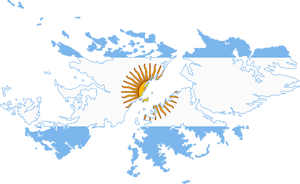
While the United Kingdom and Argentina were distracted by China and Russia, Brazil was quietly yet aggressively seizing territory in the Falklands
In the 2020's, Argentina would begin reasserting claims to the Falkland Isles. A new entity weighing into this sovereignty dispute was Brazil under the US-backed military dictatorship, proposing a joint-jurisdiction between Argentina, Brazil, the UK and US. This is denied by both the UK and Argentina in late-2026, although Brazil would continue laying claim to the islands along with Argentina and the UK. The Falklanders themselves had no desire for the independence pushed by Brazil, the integration pushed by Argentina, or full absorption into the British state preferring to remain an autonomous territory of the UK. This back-and-forth would lead to escalating tension between Brazil and Argentina, before exploding into full-blown war in 2027.
Seizing on the disunity within the former-United Kingdom and nearby Argentina, Brazil with Chinese air support bombs and neutralizes British radar assets on the Falkland Islands off the coast of South America. Already committed to U.S.-led and NATO war efforts abroad, the UK can do little against the Chinese, Venezuelan and Brazilian air forces other than focus on a protracted support mission to UK forces already stationed in and around Port Stanley. On 15 April 2025, Brazil seized West Falkland launching bombing and landing attacks on Goose Green, taking Lafonia within 24 hours. After the Second Raid on Pebble Island, mines were detonated in northern East Falkland, with UK forces and the local populace dug in. Although the Falklanders hold out until 2027, the Chinese soon begin assisting the Brazilians and Venezuelans in their bombing sorties in this year, eventually surrendering by August. Although the defeat of the British in 2027 was seen as humiliating for the United Kingdom, the islands would be liberated by the British alone eight months later in the Summer of 2028.
Approaching the Chinese surrender in 2028, the People's Liberation Army Navy and Air Force pulled back from the world to defend their homeland, this included Chinese forces stationed across the Pacific around South America and Antarctica. With the rug effectively pulled out from underneath them, even with the few Chinese vessels they had purchased before and during the course of the war, Brazil buckled under the pressure of sustaining a protracted occupation of the Falklands almost instantly, leaving the UK to come in and retake the Falklands, pushing the Brazilians out within 12 hours of opening combat. All-in-all, the British sustained only 16 casualties in the fight to liberate the islands, suffering fifty times that during the three years of Brazilian occupation 2025-2028.
War in Central America[]
The Atlantic State - although by this point in time still an unrecognized secessionist movement within the United States - would in time fuse New Jersey and secessionists in Manhattan, the Delaware and the District of Columbia and influence the increased autonomy of the Los Angeles area, Arizona, Illinois and Utah, thereafter joining NATO in opposition to the Clinton-led secessionists. L.A. would reunify with the secessionist territories of the Baja Californian peninsula - which would later inspire independence and autonomy movements in Yucatan, Campeche, Quintana Roo, Veracruz, New Leon, Coahuila, Tamaulipas and Zacatecas - effectively toppling Mexico. The response to the Mexican President's appeasement of President Kerry is disastrous, and results in Guatemala and L.A. occupying large swathes of Northwestern and Southeastern Mexico. The government is overthrown and replaced with a Pro-Guatemalan military government, the current government in Guatemala City led by President Enrique Salazar, a native-born Guatemalan of European descent. All secessionist states, except Baja California, are unrecognized and the secessionist movements are categorized as criminals and even terrorists in the case of the Zacatecas uprising. With Guatemala, California, and Mexico - supported by El Salvador, Nicaragua, Chile, Cuba and Brazil - signing the Articles of Allegiance, establishing the North American Alliance (retrospectively simply referred to as "North America"), a single military force is erected that all the member-states would share and be retroactively united underneath. Although these countries' attempts to form a strong military resistance to the Texas juggernaut had noble intent for the most part, it would result in the Chileans, Brazilians and Atlantic State merely utilizing this into simply another imperialist push of regional, intercontinental military aggression. Most of these countries would in time fall under Chilean, Cuban or Brazilian purview, or be annexed by the North American superstate.
Although dominant in the region, the home-field advantage topped with the technological and stealth edge of the U.S. air force offer more than a match for the heavily-equipped North American-backed paramilitary and armed forces of the countries of Mexico, Central America and Cuba - despite their superiority in man- and firepower. The North American state was spearheaded by Arizona and consisted of Utah, Guatemala, Mexico, El Salvador, Nicaragua and most of Southern California. The Upper Midwest spearheaded by Minnesota invades the Dakotas as well as the Omaha-Lincoln area of Nebraska following clashes between rural militias and urban paramilitary over the 2024 election. While Oregon, Washington, Illinois, Louisiana, Ohio, Utah and Texas lay claim to British Columbia, the Yukon, the Ozarks, Arkansas, Mississippi and Oklahoma respectively after internal conflict - with the U.S. emerging victorious in the former three conflicts, and insurgent secessionist paramilitary persisting in the latter two and emerging in Colorado, Kansas, New Mexico, Wisconsin, Iowa, Wyoming, Montana and Michigan... The unrecognized neo-confederate state of 'Dixon' emerges from the former states of Louisiana and parts of Arkansas and Mississippi, and the states of Ohio and Illinois are effectively ejected from the Union after sponsoring far-right terrorist organizations while California, Minnesota and Florida change control frequently between the U.S. and secessionists. The NYC-area Atlantic State remains fickle - and non-allied - for the most part.
The rise of Fascist Chilean and far-right extremism in the region, and the political crisis involving the CIA, UK, UN and Italy immediately hurls the government into further chaos. The Capitol is closed to meetings, making it impossible for Washington to legislate. The U.S. suspends its NATO membership as President Kerry begins a nationwide crackdown on dissent and Muslim populations. Kerry’s withdrawal of the U.S. from NATO brings attention to his worryingly close relationship to businessman Donald Trump, Bill Clinton, the Atlantic State and Italian President De Luca. There is also murmuring among governors, local and U.S. state government that the governments of the anti-NATO North and Latin American, Catholic-majority countries were cooperating with Trump and controlling Kerry and the AS to ban the interim administration in Baltimore involving the UN, unshackle Wall Street from their surveillance, and balkanize the United States. All across Europe, war drills are ran in preparation for a potential direct attack on NATO Europe by the intercontinental power bloc – Chile, Brazil, Cuba and their allies in Azerbaijan-Bukhara, China and the Union State representing the most threatening adversary since Nazi Germany.
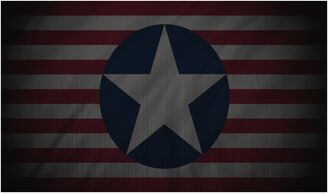
The rise of totalitarian ultranationalist superstates in the Western Hemisphere paralyzes Europe (pictured: Flag of “North America”, c. 2025).
The unrest in D.C. and Maryland reverberates throughout the AS, sending the unrecognized American country into a political crisis of its own. North America offers to recognize the independence of the A.S., should it agree to join North America's 'Federation of Union State Republics,'. The U.S. and NATO respond with outrage, and amid the international diplomatic melee Maryland's Baltimore–Washington metropolitan area declares support of the United Nations and the United States, despite being claimed as the new capitol of the A.S. and the United States (similar to Berlin during the division of West and East Germany during the Cold War), and under the iron-fist autocratic rule of Kerry and New York City. Most of the physical opposition is undertaken by the Independence Front and armed backers of Constitutionalism, particularly the Michigan Militia Corps., Missouri Militia,Citizen Militia, the Idaho Light-Foot Militia, III% Movement, Oath-Keepers and the Patriot and Christian Patriot movements. Although, when it became evident that the U.S. was siding with the UN and NATO peacekeeping on US soil, a large number of the Oath Keepers and Patriots would side with Kerry, the Atlantic State and Co-Sector against the US Loyalists, resulting in massive infighting and a "civil war within a civil war", leading to practically-indiscernible fault lines of loyalty and faction at times as the region descended into chaos. The North American-backed AZBR-Autodefensas in New Mexico and Texas Militia led by Gov.-Gen. George W. Bush would frequently engage in border skirmishes and play both sides of the state government and military in New Mexico, while the Pennsylvanian Military Reserve and the New York Light Foots also experienced periodic internal conflict and defections. Despite California's status as a U.S. state was at this point contested - at best - and the close proximity of the new rogue state, these events proved that the true threat lay within the U.S. very borders. And the evidence was beginning to point to the other American state that recently attained a tenuous independence recognition itself.
After the attack on Jeju Island, the growing threat from a rogue nuclear-armed Russia or Azerbaijan-Bukhara prompts a coalition in Westminster led by the Scottish delegation, with support from Ireland, to press Britain to relocate 30% of its Air Force, granting Scotland over 290 aircraft (85 planes and 131 helicopters) total. Scotland also gets a third of the UK’s Tanks (134), Armored Fighting Vehicles (1,962), SPG’s (29), Towed Artillery (45), Rocket Projectors (13), as well as 24 surface vessels including a Queen Elizabeth-class supercarrier (with another 6 advanced corvettes under-construction), north to British bases in Scotland at Military Bases Lossiemouth, Faslane and Clyde and the entirety of the British reserve forces are brought online, bringing the total number of active military forces in the United Kingdom to 240,050 soldiers – including Scottish forces based overseas in Canada who express solidarity in the mutual defense of Scotland from Russia, China, Azerbaijan-Bukhara or pan-Latin ultra-nationalists – and of that a total of 27,680 soldiers pledge allegiance to Scotland and Great Britain (along with a willing-and-able fit manpower of nearly a million), marking a revival in English Ultranationalism a decade after the Brexit referendum to leave the EU shook the foundations of the UK. The presence of a militarily-stable Scotland in possession of such a formidable military force – including the Scottish-run Vanguard-class submarines part of the Trident nuclear programme – elicits fear and paranoia amongst many elite circles in Westminster and the Greater London area at the thought of Scotland attempting to assert their independence from Britain by force – which at this point they were very-well able to do so.
Caribbean Crisis[]
Saber-rattling in the Caribbean between Texas and Communist Cuba prompts a naval standoff between North America and the unrecognized Republic of Texas in the Gulf of Mexico, in which North America and Texas become directly involved against the United States, the latter of which asserts neither has a claim to the region. The U.S. - already stretched thin across the Eastern Seaboard and into the Middle East and Eastern Europe - is able to muster only scattered air strikes on the Island of Cozumel off the coast of Mexico, where Texan forces were establishing artillery and rocketry, likely in an attempt to utilize a nuclear weapon. The Caribbean Campaign involving the Attack on Cozumel and the Battle of Isla de la Juventud, soon sees the Caribbean countries taken advantage of in their state of shock, by imperialist forces in Brasilia, and their secret allies in Baltimore, Los Angeles and New York City. After this information comes to light through the special prosecutors' Kerry-Clinton investigation, ties are severed between the United States and North America, as tensions escalate to the point of ignition along the Californian-U.S. Border.
Circa 2024-2025[]
In an attempt to allay fears among the rebellious Scottish public that London no longer represents the best interests of Britain, Downing St. cooperates with various elements of Belfast and the military/industrial foundation of contractor corporations that reside in Glasgow, to grant the North greater autonomy from the United Kingdom, the initiative spearheaded by a notable friend and close ally of the Brazilian President, King of Spain and India's Narendra Modi, Gibraltar native and former-Mayor of Leeds, Lord Pharaoh himself – who had recently come to lead the House of Lords.
In response, the British mainland begins to see political turmoil. Scotland, the second-largest country in the United Kingdom after England, sees Russian and Wagner PMC terrorist attacks and bombings, which begin steering the region into a frozen proxy conflict with U.K. forces. This also causes a strain in relations with Ireland and Britain, the latter currently dominated by the conflict between Scotland and England – a country three times its size and dominated itself by English ultra-nationalists supported by Red Hand Commando sympathizers. Not but a few weeks later a militarized front of paramilitary organizations consisting of a newly-reorganized and sophisticated Ulster Defense Association allied with various other English and English-backed Ulster ethno-nationalists and ultranationalists begins terrorist actions against Scottish Britain similar to that of their Muslim and Jewish counterparts in the Middle-East.
The formerly-United Kingdom had effectively become the new Yugoslavia.
October 7, Unknown Year[]
Certain elements within the Department of Defense, lying just outside of the jurisdiction of the Joint Chiefs of Staff through cleverly navigated loopholes, go public with the DOD's answer to the North American infiltration of the U.S. Government via President Kerry, and Moscow through Vice President Trump: the Omega Revolution, and their paramilitary arm – Revolutionary Coalition Network – “RECON”. Initially an international intelligence, paramilitary and espionage organization founded in October of 1774, RECON stumbled upon a secret interlocking deep-state of invisible borders – existing between ultra-wealthy from the financial, military, and political sectors – that essentially implicated the three nations of the triangular power structure of the Cold War era (China, the USSR, and America) in an undeniable scandal in which all 3 participated in financial lobbying between these power brokers across the world (primarily in the West) played against each other by the NSA and Russian Government. During the opening months of 1975, RECON narrowly saved the United States from being destroyed by Soviet nukes (thanks to the assistance of the British government). Between 1963 and 1975, RECON was a disavowed unit of the Pentagon after unearthing this conspiracy. However, after saving the US from extinction a dozen years after their disavowal, the Pentagon decided it was only proper to reestablish RECON a military and managerial heavyweight in the sector, with special powers that could challenge the Intelligence Community and/or the Joint Chiefs of Staff should they accumulate too many that made it impossible for the Legislative branch and Supreme Court to adequately challenge them. The Pentagon and Congress are contacted by UN Human Rights and Operations Officers and a Europol team regarding their eyewitness accounts of a conspiracy being carried out – in conjunction with West Germany and the Imperial Family – under NATO nations and the United States under Presidents Kerry and Trump, as well as the Joint-Chiefs (the latter of which was beginning to resemble a Junta), and that the upper echelons of the organization had been infiltrated by Interpol (which in turn had been infiltrated by the Russians and Koreans via Interpol and finance respectively since the 1960’s) in an attempt by the Imperialists to break the EU and hijack NATO’s disillusionment with Atlantic–U.S. President Kerry and utilize the Alliance against the UN.
On October 11 the RECON Ambassador to the Capitol proposes that the US Government investigate NATO and the first ‘Nations of America’ summit, postulating that the NSA and – to a lesser-extent, the IC had infiltrated the bloc and were backed by Russia, pro-DPRK militants within the Communist Party and the Nationalist Party of Allied America against the UN. The proposition goes through Parliament but is vetoed by the President. This sparks a petition in the US to petition the UN to intervene in the "North American–U.S. Conflict," before NATO intervenes, which begins to split the armed forces down the middle, leading to many defecting to such paramilitary organizations like the NYPD, and DHS – both directly controlled by the NSA. This, however, aids RECON in their efforts to push out the current Trump-loyal Joint-Chiefs, and eventually they succeed.
Realizing that they will have to work with the UN, RECON leads a diplomatic mission to the UN General Assembly concerning the complaints of UN officers in question to the Pentagon. Throughout the next several years, the UN Secretariat begins a counter-movement to the Chinese-led initiative to ‘ostensibly dominate’ smaller sovereign nations. This eventually leads to a crisis which results in the United States seat on the Council being contested, after the replacement of Russia with Japan and the Pentagon, Congress, and a record-number of the American Populace protest President Kerry and Vice President Clinton, the latter of which becomes the power behind the throne in the wake of the aging Kerry’s ailing physical stamina.
Coincidentally – or not – the Atlantic American State Union of Maryland, New Jersey and Long Island is formally recognized as independent; Secretary-General Hillary Clinton the official Head of State of the A.S., with New York City becoming its Capital. Many people initially suspect the Independence Front to be behind this, but when Hillary Clinton declares herself ‘Vice President of the Atlantic State', the I.F. immediately realizes that their movement had been hijacked by the metropolitan elite and that Hillary Clinton, Donald and Ivanka Trump – along with many others – were working together in the interests of pro-Kerry Texan oil barons and globalists to balkanize the United States and give the country its own version of 1989.
The IF contacts RECON, and the game begins.

Amid the unpopular Biden-Harris administration and the controversial and largely-unrecognized Presidency of John Kerry, the fault-lines generated by the 2016 election of Donald Trump his 6 January 2021 incitement to insurrection, Democratic primary voters' disillusionment with Joe Biden, 2020 Democratic runner-up then-Sec. Buttigieg's enduring cult of personality and even Donald Trump's Clinton-Pence-enabled scorched earth campaign after their narrowly losing of the GOP nomination to Sens. Ted Cruz and Randall Paul would endure for decades after the fateful election.
"Several Years Later"[]
November – A decade after the Brexit referendum, English men and women fed up with corruption in London attempt to “continue the Revolution” that began at the end of 2015 with Brexit, but the English government and military dismisses the protests as a Brussels-backed coup attempt. Campaigning for the autonomy of London, the protesters – approximately a million – are met with tear gas, violence and, eventually, militarized responses. Britain descends into a Crisis not seen by Europe since the Russian invasion of Crimea nearly a decade earlier. The British Crisis reverberates throughout Europe, with the West piling the blame onto Moscow, whom they accuse to be the puppet-masters of the incumbent London government. For two months, pro-Britain and Brussels-backed resistance fighters are pounded by the English military in the East of England and the Southwest, ultimately outmatched and outgunned. Unfortunately, the anti-Britain English government consolidates power, the resistance is crushed, and England undergoes a transformation for the worse into a modern-day East Germany, only much larger, much more powerful, and much more militant.
January 2025 – Serbian armor and tanks supporting the ethno-nationalist Wagner Group are spotted by satellite in Vukovar-Syrmia, Osijek-Baranja, Brod-Posavina, Bjelovar-Bilogora and Sisak Moslavina counties, surrounding Zagreb, northern Macedonia, northern Montenegro and the far western Bulgarian provinces, the easternmost Slovak regions of Preڑov and Koڑice and throughout the Subcarpathian region by Russian and Livonian forces, fighting alongside the Серые Bолки, (Seryye Volki) and involving extensive militant violence against Romanian, Croat and Ukrainian diaspora. U.S. Intelligence and scout units active in Serbia and the surrounding Balkans confirm that the Серые Bолки and the Serbs had been utilizing Russian and U.S.-manufactured weapons and equipment, and air drops are confirmed from the former which are revealed to be stoking unrest and instability in Slovakia, Ukraine, Hungary and the Romanian-Hungarian border regions of Transylvania, attempting to incite Hungary into conflict with Romania. Later intel uncovers efforts by Livonia, Serb and pan-Turkish ultranationalists to recruit Serbs and Romanian-Hungarians to their cause, and scapegoat Romania against Hungary, to test the strength and power of the Latin and European people. This is revealed by RECON to be a reaction, mostly on the part of antigovernment Ukrainian and Serb nationalists, and backlash in response to the Ukrainian and Serbian governments' incompetence and the EU's and NATO's neutrality with regard to Russian aggression against the Western Balkans and Ukraine in the Sea of Azov - in which Ukraine and the U.S. were rebuked by Germany, the EU and NATO. RECON points out that this was the fault of the U.S. for inflaming tensions between Eurasia and the West, and further goes into the root causes of the Ukrainian Civil War – that the EU went about ousting Yanukovych in the incorrect way, which in turn caused the current polarization between NATO and Russia, threatening humanity with a Third Global Confrontation.
February 2025 – After the London government takes questionable violent acts (via a military response from England) against Scottish militia participating in the neutralization of a terrorist threat on the Scots-English Border, alternative media organizations, activist organizations, and people's alliances unite to mold a new generation. Alongside mainstream media programming and newspapers, the truthpapers are established, backed by the BBC and Democracy Now, pointing out flaws in the established system of selected individuals for the jobs of Prime Ministers of the UK and Israel and the Presidents of Russia and the United States. The major point was; if one were to look past the divide-and-conquer wedge issues one would see that all political, military, and foreign policy goals were all virtually the same regardless of political affiliation. The bandwagon expands from nearly 500,000 supporters in February to over 17 million people across 21 countries by the subsequent year. It is following this that Social Democratic Leader Norbert Walter-Borjans claims upset victories against front-runner Jِrg Meuthen of the far-right Alternative for Germany in both the 2021 and 2025 German federal elections, along with subsequent exchanges of power in other nations throughout the following months and years; the most ardently anti-NATO and anti-EU being the Le Pens and the Russian-backed English “Centurions” led by the rising influence of Leeds frontrunner Christian E. Pharaoh's separatist views gaining popularity in the House of Lords, which continue to more and more support English independence from Great Britain.
Eventually, Pharaoh’s policies change from ‘independence from the British’ to ‘English supremacy’ over Europe – an agenda opposed by well over a third of the population of English “Free Britons” – who declare their allegiance to Britain and a United Kingdom under the rightful ruler and rightful powers and nation of the British people. RECON finds incontrovertible evidence the rising influence of American, Middle-Eastern and Azeri–Russian oligarchs are responsible, and notwithstanding English Ultranationalist operatives undercover in said governments across the Euro (Chris Pharaoh was a personal aide to President Xi during the South China Sea crisis and long-time friend of Bill Clinton and George W. Bush).
March – The London government begins to take extensively questionable, overreaching and unconstitutional methods that include spying on and politically targeting the Independence Front. This only increased the rate at which the “IF” was gaining new supporters threefold, all according to RECON'S master plan. The injustice unfolding in Europe contributes to this accelerated pro-British disillusionment with the new Centurion-run London government. Britain continues their sanctions war against the Russians, completely neglecting to acknowledge the rise of militants in England and Korea to the south and the east respectively, in the Balkans and across the Atlantic.
Naturally, the U.S. leads the charge that England has betrayed NATO.
April – About a week after Holyrood declared that they would continue and expand sanctions against Russia, Azerbaijan-Bukhara and China as well as Korea as per U.S. and Israeli intelligence, a new alliance is formed after the Bosnian-backed JaF Insurgency in Tajikistan and Nazbol paramilitary and militants throughout South America results in further destabilization of, and the Tajik, Afghan and Arab states are enabled to intervene in, the erstwhile countries and regions. A summit is held in Beijing, attended by Russia and spearheaded by Azerbaijan-Bukhara, to establish a Latin American-Asian military alliance with the Russia-Serbia-Livonia Axis of Resistance. High-ranking officials from Westminster secretly attend the first of these summits which consisted of Syria and in various parts of Indochina – all effectually Eurasian Union State satellites; forming an Axis of Resistance with the countries of the Union State, Azerbaijan, Kazakhstan, Kyrgyzstan, Tajikistan, Chile, Hungary, Uruguay, Paraguay, Cuba, Guatemala, El Salvador, Nicaragua, Venezuela, Myanmar and Serbia - the latter four effectively Russian, Chinese and Saudi puppet states as well. Although Korea was only an observer and did not have the official veto power within the Axis that China, Azerbaijan-Bukhara and the Union State did – they were easily the third-strongest militarily and most of the other COSECTOR members relied heavily on Russia, and thus the Koreans and Chinese, for military assistance – the Livonian-Russian Union State, China, Azerbaijan-Bukhara, Serbia, Korea, the 8 countries in Asia and the 5 additional Latin American countries increasingly referred to as the ‘Axis’.
As Kerry’s influence is more and more isolated, Kerry utilizes his power before his inevitable resignation or removal to officially cement the independence of the Atlantic State in law, which causes a break between two semi-autonomous regions – Upstate New York and the Lower East Side-Long Island Commonwealth, with the rest of Manhattan rapidly splitting between Western and Eastern Manhattan, the latter siding with the NSA-led autonomous Long Islanders and Ivanka Loyalist-Trump Tower Midtown East government-in-exile, and the former with the United Nations spearheaded by the CIA, Europe and United Kingdom. Tensions further escalate when, nearly two years later, West Manhattan and the UN refuse to recognize East Manhattan, New Jersey, Delaware and Maryland as part of the “Atlantic State” and Florida as claimed by North America, and a reapplication process is begun out of sheer defiance of Kerry to reintegrate them back into the United States of America. Kerry’s authoritarianism, however, further emboldens the Long Islanders and the Atlantic State.

Following the assassination of President Ted Cruz and the crisis that would ensue, Sens. Paul and Romney would have their inauguration delayed by the authoritarian "caretaker administration" of former-Secs. Kerry and Clinton.
After this, tensions reach such a point between the pro-UN U.S. Intelligence Community and the pro-NY Department of Homeland Security and NSA, that a large crackdown begins on members of the U.S.IC that harbored views or sympathies with the DHS, NSA and NYPD – leading to dozens of Agents within the CIA, FBI and Pentagon being apprehended or fired. Secretary Gen. Kerry publicly defends the DHS and NYPD, echoing his 2020 primary opponent – NYC Mayor Bloomberg – in calling them his ‘own army’ – which, in total, was among the top ten largest armies on Earth – and that Atlantic America; despite its small geographical size in comparison to neighboring New England, Pennsylvania, Virginia and the Imperial State; should “not be underestimated”. The Department of Homeland Security declares allegiance to the A.S. and North America while scolding the UN, and with nearly 100,000 paramilitary officers (excluding several hundred FEMA officers) and personnel backing the 50,000-strong NYPD – as well as U.S. Marshals, U.S. Coast Guard, and tens of thousands working for private military contractors – the Atlantic Army began to seem a reality.
With New York City fractured between roughly three factions - the pro-A.S. Long Island, Kerry’s Atlantic State, and the UN demilitarized zone (including the UN-controlled Financial District in Lower Manhattan) - Kerry, the Trumps and UN had been successfully positioned, and through them, entire political entities, to the advantage of Wall Street Bankers and the apparatus through which they functioned: the military-industrial complex. The loyalty of the Department of Homeland Security to A.S. President Kerry (and, unknowingly, North America and the authoritarian Co-Sector) unnerved and unsettled the U.S. Armed Forces. In particular the Marines and the Navy, who looked more and more toward unrecognized U.S. President Buttigieg and the Democratic Congress (encumbered by the political instability unfolding in D.C. along the international American fault lines in an increasingly-unrecognizable map of the former-U.S. State of Maryland by the Kerry regime's delusions of grandeur) for guidance.
Summer 2025[]
After being selected for a governing coalition following sequential victories in 2019, snubbing the fourth-placing Union of ex-Chancellor Angela Merkel, the Green-SPD coalition falls short of an outright majority - 38.9% - drawing the AfD and Union into an alliance against their common centre-left foe. From April until mid-July the growing establishment and right-wing backlash to the growing popularity of the populist left and social democrats results in an unlikely alliance of convenience. With sweeping support and influence within the European establishment, Merkel acolyte and incumbent EU Commission President Ursula von der Leyen drafts a merger of the EPP, ECR,RE and ID to form the Populist Centre (PC) headquartered in Westphalia (which would become a hotbed of domestic terrorism in the late 2020's) ahead of the 2024 Parliamentary elections, which becomes the dominating political group in the European Parliament with over 440 seats out of 706 (62.4%), forming the largest ruling majority of any democratic party in a democratic parliament in history, surpassed only by the 1931 UK Conservative Party victory and the 74th U.S. Congress in raw percentage. President Von der Leyen explains the merger was to challenge the rising political influence of Russia and Azerbaijan-Bukhara in EU politics via the rising UUP, which sat at roughly 161 seats, and to more adequately assist the EU in their efforts to pull back the “Scots–Eurasian incursion”, spearheaded by Azerbaijan-Bukhara, into the West. She later acknowledges that her ‘Euro Activism’ was based on the 'Russia Report' accusing the Kremlin of engineering the 2016 British exit from the EU and designed to challenge Britain’s position as the prime contender against France for the role of heavyweight contributor to the bloc amongst the EU members – insisting that the much more economic Germany of the 2020’s was better suited to the role.
August - After struggling for almost a decade to get together an effective organized resistance to the tyrannical administration dominating the Executive Branch of the English Government, elements within MI6, spearheaded by RECON officials, declare a national emergency, affirming Great Britain’s security at risk to foreign interests – namely Azerbaijan-Bukhara and the Union State. The EU-dominated NATO responds aggressively, declaring RECON a “rogue military dictatorship” despite the fact they are only doing their jobs, which is the defense of their countries. RECON comes under fire from elements within the Pentagon loyal to the NATO hegemony as well as personnel within the Congress, Supreme Court, and – of course – Downing Street, which accuse RECON of shilling for Azerbaijan-Bukhara and the Russian Union State.
The situation continues to unravel throughout the rest of the month until it all comes to a head on September 5th, when the first shots of the English Rebellion were fired in Glasgow, Scotland.
War in Britain[]
- See: Gamma Thirteen, English Rebellion, American Civil War II, Argentine–Hungarian Pact of Unity, MI6–Pentagon relations, Confederation, & Independence Front
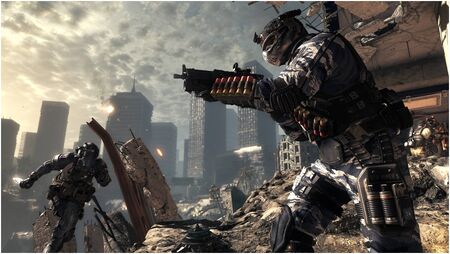
British forces in Glasgow’s city-centre, c. 2025-26
September 2025[]
After a transitional force of NATO peacekeepers begin to police New York City and the Baltimore–Washington metropolitan area in an effort to disrupt an alleged “rogue Pentagon” which they blame for the rise of Kerry as a sort of 'post-Trump inheritor' of his right-wing ultranationalist movement – the Pentagon and Defense Department are essentially labeled terrorist organizations by the Republican-controlled Senate in response to Democrats under the Kerry-Clinton caretaker administration questioning the election of President Paul as more "Russian meddling", and the Department of Defense institutes a lockdown of regions constituting what was known handily by now as the Atlantic State – officially recognized as a rogue-state spearheaded Texan-led insurrectionists and Hillary Rodham Clinton (of which some the the peacekeepers are found to be on the payroll of via Texas Governor-Gen. George W. Bush) whose vice-chairwomanship of NATO by this time had come under scrutiny by European leaders, due to her connections with Vladimir Putin and Donald Trump. The basis for the NATO intervention into the United States comes under the pretense that Washington is working for A.S. special-interests on Wall Street and in North America, as opposed to the Will of the People. The evidence of this is incontrovertible, yet RECON comes into alarming information from GCHQ and MI6 that English nationalists and Russian–Serb forces are seizing upon the NATO-led opportunity to launch plans for a multilateral invasion of the United States and the Balkans, and effectively topple the US and EU governments and their perceived strangle-hold on the Middle-East. Although they are seen as corrupt by most of the world, the majority of the world decries the move by NATO as “an unnecessary use of force” that distracts from the fact that the dynasties in America (the Trumps, Clintons and Bushs), Italy (De Luca Dynasty), the Catalan Deep State, England (Pharaoh and Windsor), China (Fang dynasty), and the House of Saud (Saudi Arabia) were behind the corruption and behind the infiltration of the U.S. and UK governments. Glasgow and the British Crown declare that they will not stand by and allow North America and NATO to hijack the British military just because “a separatist British faction (England) says so,” and thus, ‘Great Britain’ is reformed incorporating the constituent countries of Ulster, Scotland and Wales. England – despite having its independence internationally rejected and unrecognized – refuses to accept constituent status and a COSECTOR-NATO military alliance consisting of English nationalist units, the Korean Navy, Azerbaijan-Bukhara and Union State naval and air forces is erected to support England and combat Scottish influence – the latter of which ascends as the solitary UN-backed bulwark against a full-scale invasion of the United States of America, increasingly seen by NATO as critical to unseating President Kerry and bringing the US back into NATO. However, due to NATO's perceived indifference toward - sometimes outright support of - England and North America, and its contempt of the US and UK, the UK and US respond with closer ties with the EU over the next decade. The closer ties of the EU’s to the UK, and the Alliance's (at this point) reluctant entente with the North Americans, prompts a NATO–UK split. NATO declares that arms dealers exploiting the CIA are the prime culprit of corruption in the US government, that British MI6 were enabling it, and enacts an active campaign against these organizations “indefinitely” (particularly Northrop Grumman; to stave off public condemnation whilst simultaneously coming to the aid of pro-British forces in their row with pro-English/Russian forces in Scotland. Furthermore, England becomes far more aggressive after the Scottish National Party is replaced by the pro-UK Democratic Union of Scotland Party, realizing their propaganda portraying Scotland as ‘extremist’ would no longer work. An attempted intervention by England into Glasgow, Scotland in an effort to repatriate military assets that they claim are English from what they call militants is underway as of November 5th, but civilian casualties and asymmetric warfare waged by English guerrillas and Russian–Eurasian air strikes forces the campaign to a screeching halt three months later. Satisfied that they had demoralized the Scots with indiscriminate bombing of civilians, the COSECTOR-NATO coalition and the English pull back, and begin preparation for terms of surrender.
Winter 2025[]
The Glaswegian Campaign, despite a crushing defeat, inspired confidence in the resistance against the Serbs and Russian–Livonian Union State forces and the people therein that the fact that nearly half of the British Military… 110,000 of the men and women in uniform to be approximate… were siding with the people, and inspired confidence that the war could be won. However, England’s connections through the Ulster Defense Associates and the UVF to Al-Qaeda were uncanny, as it was them the United States government’s CIA and Westminster’s MI6 supposedly organized to fight against the Soviet invasion of Afghanistan in the 1980’s (According to the Alt-Right) and, allegedly, set up to launch the 9/11 Attacks (although it was really the Pentagon and Wall Street). Working in communion with global financial assets, Interpol, the Bank of International Settlements, Turkish SADAT private military contractors and the House of Bourbon, the Pact enlists the assistance of many Al-Qaeda-related organizations which harass Scottish forces throughout the war, and in addition to this, the many Fundamentalist Islamic terrorist organizations convene with foreign, globalist aid to give birth to a new breed of bioterrorism, a government-engineered nanobot-mutagen form of the so-called “zombie fungus”, Ophiocordyceps unilateralis, and Ophiocordyceps sinensis, or the “caterpillar fungus”, both of which they were allegedly working on mutating to conform to a human host since the early 1990s, an alternative media source claims. Thus far they had only gotten the fungus to be able to jump from ants to cattle, deer and elk by 2012, but were making “great gains” in the sector of bioterrorism and biowarfare. Naturally, the governments and the terrorists fought bitterly for control over the species. On the 12th of the month, JaF launched a notable offensive against the Scottish Military in Ulster, when they were successfully repelled by the 14th. They attacked again, with assistance from Union State and volunteer Hungarian military forces.
By August of 2026, the EUSA commanded much of the minority seats, controlling an increase of 49 seats, and the Pharaoh-controlled Interpol and NATO continued to dominate the movement of armed paramilitary forces into Britain. Whilst NATO had virtually no reason to put up a substantial effort to repulse the English incursion, Pharaoh’s England had already scored major victories against British forces, and confidence and English patriotism was at an all-time high. Although by now most of Northern Ireland and the Glasgow metropolitan area had been infiltrated by Union State and North Korean military forces, dissent did arise from within the ranks of the Interpol forces throughout April and May, even well into June and July when the EU had practically imploded due to the renegade nature of these radical Interpol, primarily controlled by Moscow and Minsk.
Serbia is the first nation confirmed to the public to be stoking unrest in the Balkans and Caucasus followed by North Macedonia after EU-made equipment was spotted supporting the Wagner Group Insurgency and CB attacks a year earlier were designed by the Nationalist Action Party instead to incite international uproar against the EU and Croatia. Serbian Army and Russian–Serb pro-Azeri forces supported by Azeri-Bukharan air forces are able to mount a protracted insurgency on the border which later spills over into full-blown ethno-ultranationalist war in Albania, Bosnia-Herzegovina and Croatia, the current VMRO-DPMNE–BDI right-wing ethno-nationalist government in North Macedonia utilizing its Yugo-nostalgic connections, headquartered in Republika Srpska, throughout the Serb diaspora to effectively collapse the region into all-out anarchy in a false-flag operation to justify further empowerment of its grip over Western Balkan society and military. By this time, hundreds of Serbian and Bosnian Serb tanks and infantry fighting vehicles aided by Macedonian and Russian hit-and-run air strikes are pounding southern Croatia into submission as the formerly united state turned against itself, with Albania and Kosovo following soon after.
Jul. 2026 – Pact forces launched a final attempt at an all-out assault on British territory. They are met with firm resistance from Scottish Armed Forces and militia movements for the most part, but a fragment of the invading force make it through into Wales where they attempt to set up a forward operating base in the Cambrian foothills, but are quickly pushed back by armed citizens. Most are killed but some are taken as prisoners or escape. By the end of the month, 33.3% of U.S. troops have been recalled to the homeland, and another 50% are put on-call should an international crisis break out. Coincidentally, shortly thereafter, NATO holds a meeting at headquarters in Brussels on the rapidly unfolding situation. The NATO Secretary-General proposes declaring the English rebellion a “Non-Aligned States Zone” while maintaining that the United Kingdom has not fragmented and that the current conflict be recognized as no more than an attempted military coup. The move is put forth, and the United Kingdom is “reestablished” and the resistance is “abolished”. Meanwhile, the Federal Chinese government, with support from NATO and Taiwan, finally repulses the PLA from Shanghai. The CCP government-in-exile surrenders, and thus, the War in South China dies down to a simmer as the CCP maintain a presence in the Chinese Northeast, just as the English Rebellion nears its conclusion as Westminster assumes a more diplomatic stance with the Pentagon and Holyrood.

The corruption in London inspires the rise to power of Gibraltar-Born Christian, Lord Pharaoh of Leeds, an English Ultranationalist
Throughout the second half of 2026 hostilities begin to falter. With the more aggressive, militaristic stance initially taken by Westminster and the Pact’s interests relaxed, Holyrood opens talks with Westminster about reestablishing a United Kingdom of Great Britain and N. Ireland. Little progress is made – for the Gibraltarian Chris Pharaoh had successfully cemented themselves into the annals of history. Meanwhile, the United States Congress votes to remove Kerry and recognize his four-month regime after 21 January 2026 as a foreign occupation of the U.S. Government by the "unrecognized rogue entity" of Texas and that North America was complicit in the secession of Texas and the New York Conflict as the death toll skyrockets from President Kerry’s air campaign targeting families of suspected terrorists in the Middle-East. The onslaught wrought by President Kerry unites major parts of the Arab World and Muslim nations abroad in their bitter hatred of the United States and the west. Vice President Randall Paul is recognized as the legitimate 48th President, and a law is passed requiring any future interim presidents being of the same political faction as their predecessor.
Cypriot–Turkish War (2024–2026)[]
- See: Ottoman Cyprus, Cypriot intercommunal violence, Cyprus Emergency, Turkish invasion of Cyprus, Cyprus problem and 2024 Dhekelia status referendum
Following increased tension between North Cyprus and the United Nations, Turkish military activity on the island began to skyrocket over the course of the next year, leading to bitter accusations and tensions between the UK forces in the area, and the Turks. Following a sham referendum in Dhekelia to join the Turkish Cypriots in the north, tensions between Turkey, the UN and United Kingdom boil over into skirmishes along the border between UN peacekeepers and Turkish forces. Skirmishes like this abound in conjunction with rocket attacks from the North into the south throughout the war.
Hungarian–Slovak War (2024–2026)[]
- See: Hungarian irredentism, Slovakia, Transylvania, 2014 Crimean status referendum, 2023 Transylvanian status referendum
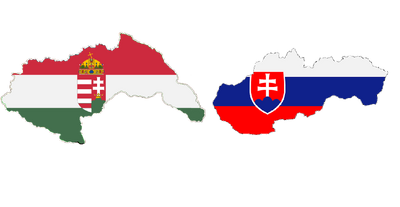
Although Hungary had many unrecognized claims on neighboring territory, it was Slovakia that held out the longest.
In late 2023, Hungary began its crusade to return to its WWII-era borders with a referendum in Romania. The cities of Baia Mare, Satu Mare, Targu Mares, Cluj and Oradea held referendums to secede from Romania, following years of secessionist unrest, which would escalate with the 2022 referenda. Following this were referenda in Novi Sad and Kassa, Slovakia, in early 2023. Slovakia is the first nation to strike back, with attacks on Hungarian military targets in South Slovakia, while Serbia bows its head and Romania collapses into internal conflict. The War in Transylvania (2023–2025) becomes a black hole of arms dealing and terrorism, as Hungary continues to exert its control over the Romanian region.
Due to opening warfare on all fronts, including an air strike in Switzerland in 2026, the Hungarians are unable to fulfill their plan of annexing the entire country of Slovakia. The Slovaks, with assistance from the Czechs, the Poles and the Ukrainians, are able to repulse the Hungarian offensive. Hungarian forces hold out for another 10 months before being pushed back beyond the Hungarian–Slovak border in mid-2026, sustaining moderate losses to the Slovaks' paltry 500 casualties. The loss for Hungary begins a positive feedback loop, with the Hungarians pushed back out of Romania by 2027, Vojvodina shortly after Slovakia, and losing entirely their territory in Carpathian Ukraine by 2028. The Hungarians continue to provide material support to various Russian and Chinese operations throughout the world, but their apex of martial prowess in the mid-2020's is forever swept aside by the Slovak material and moral victory over Hungary.
Croat–Serb War (2022–2027)[]
- See: Bosnian War, Bosnian Serbs, Bosnian Croats, Decolonization of Southeastern Europe, & partition of Bosnia
In the wake of a NATO distracted by Russian and Livonian manoeuvering in the Baltics, Serbia begins targeted attacks and airstrikes on Bosnian Croat forces in Republika Srpska, while building up anti-air and ground forces along its western border with Croatia. Serbia maintains air superiority over much of the Balkans, although Romania's was larger but less militant. The Romanian Air Force is unable to project itself into the Western Balkans, however, and Serbia effectively blocks off any and all assistance to Bosnia from NATO or the EU, the latter of which was in the midst of a crippling war with Russia and China in Central and Eastern Europe. With Romania confined to the Eastern Balkans, the Turks restrained by Russia in Asia Minor, neither able to adequately defend Bosnia, the Serbs begin bombing and shock-and-awe attacks on the rest of Bosnia. A drawn-out low-level insurgency begins across the region, with the heaviest fighting in Republika Srpska, Sarajevo and along the Croatian-Serbian borders and Northeastern Croatia concurrently with the rest of the interconnected conflicts across the world.
Brazilian–Verdean conflicts (2016–2027)[]
- See: Bolivian–Chilean Territorial Crisis, Chilean Crisis, BAP Almirante Grau hijacking, Brazilian–Chilean Invasion of Argentina, Cuban–Verdean Invasion of Central America, Verdean Invasion of Bolivia, & Verdean Invasion of Baja California
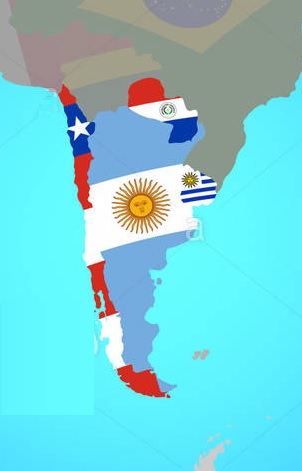
The return to the Southern Cone (and Venezuela) of neoliberal ultra-nationalism for the first time since Pinochet leads to a reorientation of the region away from the West and toward the likes of nazbol North Korea and Russia.
Throughout the late-2010’s and into the 2020’s, Brazil, Chile, Cuba and Venezuela deepen their military cooperation. It is through China that Brazil and Venezuela and rogue-states such as North Korea and Cuba came to be so close by the early 2020’s, just prior to the final escalation in global confrontation. As early as September 2016, then President of Ecuador Rafael Correa warned of a potential ‘Operation Condor 2.0,’ in which out of fear of a resurgent Russia, the U.S. begins funding into power authoritarian regimes that would support them in lieu of Moscow. This enabling of the right-wing is most prominent in Spain - as well as one of the primary three offenders of the previous campaign of state-sponsored terrorism, and the second-most powerful country in the Western Hemisphere: Brazil, Argentina, Chile and Venezuela.
Beginning in 2016, Alberto Curamil, a Mapuche environmental activist, successfully blocked the construction of two hydroelectric power projects. Chilean authorities arrested him in 2018, seemingly putting to bed the goals of Mapuche indigenous peoples for autonomy and freedom from Argentine–Chilean ethno-nationalism, until in 2019. Curamil is given the prestigious Goldman Prize award by an international human rights body, giving right-wing President Sebastian Pinera the first headache of his administration, and jump-starting what would become a near-decade-long conflict for the liberation of the Mapuche and indigenous peoples across the Americas.
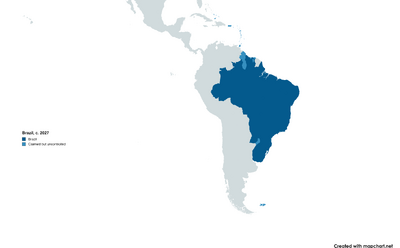
By 2027, Brazil was in a state of war with 14 countries both officially and unofficially - including an official declaration of war on Suriname and Argentina, and unofficial confrontations with the U.S. marines and 8 Caribbean countries culminating in the West Indian Campaign and the Battle of Puerto Rico.
In June 2018, a controversial and outsized response to violence in the poorest region of Chile known as Araucania, came in response to a wave of arson and other attacks against primarily forestry companies by indigenous Mapuche and their allies. “Jungle Command,” the special militarized police unit created by Pinera, drew massive backlash with protests reaching as far away as Santiago, when a protestor on a tractor named Camilo Catrillanca was shot through the head by Commandos near the village of Ercilla in November of that same year. Even despite the growing backlash against the Colombian-trained Jungle Commandos, equipped with bullet-proof jackets, drones and high-tech surveillance and communications systems, Pinera continues to defend his Araucania policy – entrenching the opposition and drawing condemnation of the Chilean government from international bodies such as the United Nations and Amnesty International as well as the international community writ large.
After the failure of the uprising against Venezuelan President Nicolas Maduro and the Communist Party of Cuba in the spring of 2019 and fall of 2021 respectively, interests involving American imperialism for resources among other reasons such as soft warfare against the Venezuelan populace itself results in an inevitable and incredibly bloody Civil War in Venezuela in mid-2022, in which the US military intervention fails catastrophically. The repercussions cripple Colombia, which finds itself not only engaging FARC rebels, but simultaneously fighting off Tupamaro insurgencies on its Eastern border. And Venezuela soon thereafter falls victim to right-wing ultranationalist military occupation by Bolsonaro-loyalist anti-Socialist radical militancy. This causes a ripple effect across Eastern South America, affecting the Guyanese and Ecuadorian economies as well.
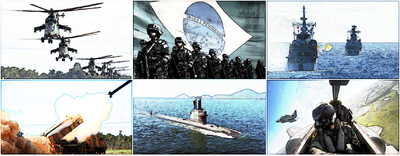
With 2.1 million in total available manpower - the 7th-largest on Earth - Brazil was by far the largest and most powerful military in Latin America.
By this point in time, Argentina - already recoiling from economic and political crises from the 1990's and 2000's - was on the verge of becoming a failed state with the return of the Kirchner Dynasty and their subsequent sell-out to Chile and Cuba regarding the New South American Depression beginning in Colombia and Venezuela.
The economic instability in its Southwestern neighbor results in parallel instability in Brazil. This soon affects the outcome of the 2022 presidential election resulting in the subsequent Liberal-Socialist regime which allows the military to run rampant with their own ultra-nationalist, imperialist ideology - in time fully annexing the countries of Suriname, Guyana, Paraguay and Uraguay - as well as the West Indies, and as far north as the Bahamas, by 2027.
Despite Argentina's overwhelming numerical advantage, the geographically-strategic location and technological supremacy of Chile and Venezuela would prove too much of a threat to overcome, let alone ignore. Brazil initially assumes a non-aligned, neutral stance in South America similar to Switzerland in Europe, but later sees its interests diverge with Chile vis a vis Cuba and China. Chilean and Argentine ultra-nationalists found their views clash with the Brazilian military brass and nationalist establishment, which seized upon the radicalism of the incumbent Brazilian government to achieve their goals of a "Soviet American Union" with the American countries of Argentina and Chile playing the role of Ukraine and Belarus.
But perhaps the most impressive of Chile's weaponry was its unrivaled martial prowess in general. Dressed in dark gray, with the iconic Stahlhelme helmets on their heads, Chile’s soldiers bear more than a passing resemblance to the Wehrmacht of World War 2. The colorful sashes and ceremonial rapiers of their officers seem to have been pulled directly from a history book, with the goose-stepping hammering home the point. However, the Chilean military didn’t just decide to embrace the Nazi aesthetic and lift the Prussian drill and doctrine from a history book. Rather, its distinctly Teutonic style has its roots in the 19th Century.
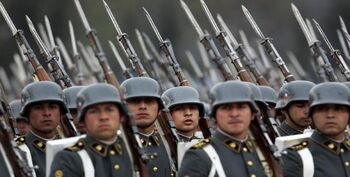
Over 9,500 troops from the country’s army, navy, air force, and carabineros can be seen marching through the streets of Santiago to mark the 208th anniversary of the Dيa de las Glorias del Ejército del Chile (Day of the Glories of the Chilean Army).
In the 1880s, Chile managed to prevail over Bolivia and Peru in the War of The Pacific, a dust-up over mining territory in the Atacama desert. Its military wasn’t in great shape, however, and its leaders wanted to bring in some external help to gain an edge over Chile’s neighbors. Enter the Prussians. Under Otto von Bismarck, the Prussians had managed in 1870 to unify the splintered principalities of northern Germany and win the Franco-Prussian War inside of ten months. Despite its small size, Prussia had a hardcore military culture and could hold its own against far larger European powers. The Chileans shipped a bunch of Prussian officers over to whip its military into shape, and by the time the Prussian Captain Emil Kِrner retired as the Commanding General of the Chilean Armed Forces in 1910, the country’s martial prowess was unmatched in South America.
Within a few years of Brazil's crisis, Argentina's civil unrest, and the collapse of the Guyana and Colombian economies, following - of course - the Venezuelan Civil War, Peru had been largely isolated and cut off from the East of the continent, and Argentina militarily dependent on the Chileans and Chile economically dependent on Argentina - and Russian-ally Cuba playing them both. Resistance movements fomented - and faltered - in Ecuador, Northern Colombia, and even as far north as Panama, Costa Rica and Honduras in 2023, 2024 and 2025 respectively. But the sheer tactical, strategic and technological superiority of the Chilean military - backed by the sheer size of the Cuban forces - was insurmountable, with no Brazil or America to come to the rescue, even all of the rest of the South American countries combined were unable to penetrate through the Andes - the longest and largest mountain range outside of Asia - or make it through almost 20 million kilometers of secured maritime territory extending as far East as Rapa Nui (or roughly 2,000 kilometers from British and French territory) - to strike anywhere vital to the aggressors' infrastructure or prevent Peru from falling into Axis orbit. The best case scenario involving a defeat for Argentina and Chile, sooner rather than later, was for the U.S. to collect itself long enough to deliver a tactical nuclear bombardment - and even then, Chile grew closer to adversaries militarily with each passing day.
All of this would culminate and result in in the 2027 Brazilian–Chilean Invasion of Argentina. The total devastation and destruction of the country and the killing of over 50,000 - mostly civilian - would draw Western condemnation, although most of the UN and the Global South would put the blame at the U.S. for backing a military coup in Brazil and the Western-backed genocide in Gaza for the drift in Western–Brazilian relations beginning in 2024.
Cuban Civil War and insurgency[]
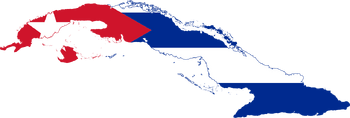
Cuba becomes a foothold in the Western Hemisphere for the Chinese Communist Party and the Kremlin in the 2020's, after long being a Soviet ally during the Cold War.
Following an embargo after the takeover of a pro-American right-wing regime in 1959 and sour relations between the two nations for decades following the 1961 failed invasion of Cuba and 1962 Cuban Missile Crisis, US president Barack Obama loosened business and travel restrictions with Cuba in 2014, also removing it from the list of state sponsors of terrorism. Presidents Trump and Biden would resume and accelerate these restrictions in 2017 and 2021, reversing their predecessor, and accelerating the embargo and trade restrictions on Cuba under the former-Vice President in 2022.
In the wake of renewed US aggression against Cuba, historically pro-US El Verdean country Chile reaffirms bilateral ties with the Communist state and even EU officials criticize the US (before drawing condemnation from their own authority) for their aggressive Cuba policies. These calls for rapprochement are joined by 80 House Democrats who call on the president to "revert to Obama-era Cuba detente", with four of its seven leading proponents representing the Congressional Progressive and Populist Caucuses. After a falling out with the White House and Democrats capitulating to Republicans proceeding initial support from House moderates, progressives spearheaded by Independent Vermont Senator and Budget Committee Chairman Bernie Sanders and New York Rep. Alexandria Ocasio-Cortez blasts the Biden administration's stimulus bill as "[worse] than Trump's" after Senate Democrats rebuke the United States House of Representatives on the $15.00 minimum wage proposed by the Biden-Harris campaign in the 2020 election, and House Democrats led by House Speaker Pelosi capitulate to the Republicans on immigration.
This progressive-Democratic conflict would result in House progressives and Chairman Sanders being isolated in Congress on Cuba. A failed coup and brief insurgency in Cuban-allied Venezuela in 2019 and 2021 would embolden the Cuban dissident movement and Nationalism among the ranks of the Milicias de Tropas Territoriales and even among the military itself - bolstering a manpower over 1.2 million, the 11th-largest standing army on the planet (surpassed only by Brazil, China, India, Russia, Taiwan, Ukraine, Vietnam, North and South Korea and the United States) - the United States passes more sanctions and this time targets other Latin American states maintaining relations with Cuba beyond just Venezuela and Nicaragua, blasting and sanctioning Brazil, Chile, Argentina, Paraguay, Peru and El Salvador. The aforementioned countries, followed by more shortly, break ties with Cuba - following suit of the US in support of Cuban President Miguel Dيaz-Canel against the Castro regime - and in response Cuba begins acquiring soft power throughout Latin America in immediate blowback against the US pressure against the Castro regime. As a result, Castro is overthrown, but maintains support among the active duty - although dwarfed in number by the nationalist pro-Canel MTT. Castro and the ailing Revolutionary Army support left-leaning government in Argentina and the Pinera regime from exile in Nicaragua, although both eventually fall to the Nazbols at home and abroad - with the Korean-backed Cuban insurgents expanding their control over the country and region throughout the 2020's.
2023-2027[]
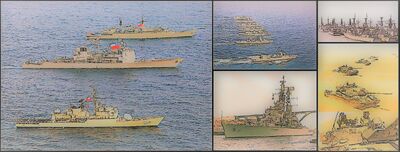
Clockwise from left; Chilean frigates support a former-Ticonderoga-class missile cruiser, Chilean warships in attack formation, Chilean surface vessels, Chilean Leopard II tank collage, former-BAP Almirante Grau (2022-2026)
Immediately following the short and brutal Cuban Civil War was the three-year-long Argentine Crisis, instigated by Crypto-Nazi Chilean ultranationalists backed by the far-right Spanish Vox party that wished to unite all of Spanish-speaking America under the flag of Chile, while also utilizing the at this point year-long Mapuche Uprising as their primary scapegoat for fearmongering. The largely-isolated supporters of Pinochet and Colonia Dignidad had surged to prominence amid the growing backlash against the right-wing government of Sebastian Pinera, as well as the socialists of Michelle Bachelet, who were united in their disdain of the Theocratic movement. Finding its origin amid backing and funding from the Nationalist Bolsheviks of Argentina, Liberal Party of Brazil and the Iron Legionnaires of Rome, and pro-Legionnaire Clergy in Vatican City and throughout Latin America and Europe, the ‘National Peasants and Republicans Party’ (Partido Nacional Campesinos y Republicanos in Spanish, Partido Nacional dos Camponeses e Republicanos in Portuguese – PNCR, or “PiNCeR”) attained a worldwide presence. Although in most developed countries where the Pincer had official recognition as a political party they had a slight if even marginal existence, throughout the Middle-East and Latin America they were highly organized and involved in local and regional politics, with their representatives reaching the national stage in Livonia, Russia, Cuba, Tunisia, Venezuela, Syria, Paraguay, Chile, Peru, El Salvador and every country in Latin America except Costa Rica, Belize, Honduras, Jamaica, Haiti and the Dominican Republic. However, it is only in the El Verdean countries and Venezuela that such a rabid strain of Nazbols would come to absolute power outside of Cuba, North Korea and Catalonia. Even gang-controlled Colombia kept the budding regime in Chile at an arm’s-length.
After Pinera’s resignation and the PNCR surge to power in the winter of 2021, the Chilean military brass were replaced with pro-Pincer loyalists, and a purge was initiated freakishly similar to the Nazis in 1930’s Weimar Germany. Pincer storm troopers patrolled the streets of South and Central American capitals and big cities, bullying, threatening and – eventually – killing its critics or people who thought differently, and its apologists and allies were deeply embedded within the North American government. The Pincer believed El Verde should be preserved for the ‘lineage of [their] fathers,’ which in their terms meant “European El Verde”. This put the US-backed government of Bolivia directly in the crosshairs of the Chilean juggernaut, which happened to coincide just as one of its chief rival Chile's closest allies in Latin America – Peru – lost its recently-retired flagship, the Almirante Grau, to a terrorist hijacking by perpetrators believed to be tied to Argentina and Chile. The missing ‘gun cruiser’ puts the world into a state of terror, knowing that one of the most powerful weapons of war on the planet was potentially in the hands of terrorists. This pandemonium is seized upon by the Argentine PNCR, which throws the country into a state of crisis and sees the return of the Kirchner dynasty less than a year later. The Anti-Fascist resistance fights on for years to come, but the fighters are reinforced month after month, year after year, by Russian, Peruvian and Chilean armor and artillery that cut through the Andes via bottleneck and switchback in hit-and-run attacks impossible to defend against and impossible to retaliate against, the dug-in columns of hostile armor and the sheer firepower awaiting both infantry and air craft attempting to bomb them out greeted with the same result each time – no matter the attack angle, the Andes themselves posing the greatest natural obstacle to the Argentine resistance. After almost two years of fighting against the Argentine government, Brazil and Chile’s armed and paramilitary forces across the Southern Cone, the resistance falters in Argentina, and the country de facto falls under the influence of Russia and its vassals in Chile and Peru. At the same time, Brazilian and Chilean Armed Forces launch full-fledged military attacks in Bolivia, and the Taura and Simon Bolivar air bases in Ecuador. After these attacks, Chile and Brazil directed their Navy at Central America and Baja California with Chilean and former-Peruvian air support, while launching ‘shock-and-awe’ maneuvers against southwestern Bolivia in the other direction. Despite how thinly-dispersed its Armed Forces were at the time, the methodical precision and preparation laid out beforehand by the Pincer was impeccable and uncanny.
From March 2023 to August 2024, the alliance between the Panamanian, Honduran and Colombian states is broken when the latter of the three withdraws after military bases in San Andres and Buenoventura are hit by air strikes, killing 1,000 soldiers atop the thousands of others that had been killed or disappeared by the Pincer reign of terror over El Verde. Until 2022, an ailing Central American resistance to the Russian, Cuban and Venezuelan militants persists on a trickle of U.S. and North American aid, but the millions of displaced adding to the Venezuelan refugee crisis destabilizes virtually every country south of North American Mexico, and leaves Baja California wide open to an attack by Russian, Cuban or Chilean forces. With the newly-dependent autonomies of Guatemala, El Salvador, Honduras, Costa Rica and Panama united under the flag of a Californian–Mexican federal entity; a level of civil unrest and socioeconomic instability unseen since the Central American Crisis of the late 1970’s wrought the region and left it at the mercy of relentless Pincer terrorism and Chilean ultranationalism backed by the rogue state of Texas. As opposed to coming to the aid of their southern neighbors like the binding treaty obligated them to in such a situation, California and Mexico – and thus, North America – declares neutrality alongside Colombia and Texas.
The 2024–2026 War in El Salvador begins when the Salvadoran Army spearheading an independence movement launches attacks in what would begin the Nicaraguan–Salvadoran War and the Battles of Leon and Managua indicative therein. The sporadic skirmishes and attacks by Salvador backed by Chile, Venezuela, Brazil, Livonia and Russia gradually escalate and accelerate throughout the fall of 2024 and spring of 2025, culminating in a full-fledged Invasion of Nicaragua by the Salvadoran Army and Navy backed by Cuba, with the apex of the fighting in Leon and throughout northwest Nicaragua. The fighting results in a unified North American–US condemnation of El Salvador, and the Russian, Chilean, Cuban and Venezuelan government’s support for the attack on Nicaragua, seen as an attack against the entire North American continent. Authorities in Los Angeles and Mexico City had little to complain about regarding the pro-Russian states of Latin America and their expansionism, as the neutralization of Ecuador and Colombia following a protracted war with Peru serves to push the former two countries into North America’s budding orbit outside of the United States’… that is, until, Chinese-backed Pincer Venezuela's imperialist designs extend beyond Colombia and Guyana to set upon the Baja California peninsula. Specifically, one of the most prominent metropolitan centers on the North American continent – Tijuana.
Azerbaijani–Russian aggression[]
- See: Colombian–Venezuelan Territorial Crisis, Argentine Crisis, BAP Almirante Grau hijacking, Argentine–Chilean Invasion of Brazil, Chilean–Cuban Invasion of Central America, Chilean Invasion of Bolivia, & Chilean Invasion of Baja California
Second Winter War (2021–2027)[]
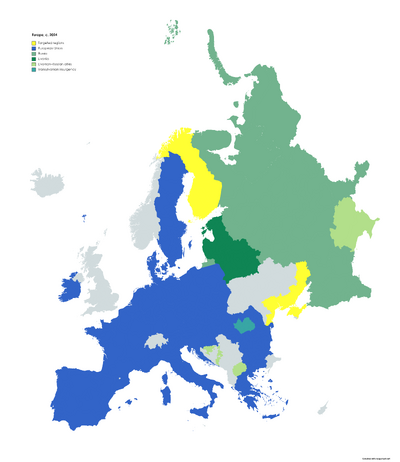
Aside from Crimea and the Donbas; Budzhak and Finland would also fall into Moscow's crosshairs in the next decade (targeted countries and regions in yellow).
From 2014 to 2020, the Eurasian Union actively aided and abetted separatist terror groups in the form of the People's Republic of Budjak, the Donetsk and Lugansk People's Republics in Eastern Ukraine following the February 2014 Russian occupation of Crimea. But it would not stop there. After a staged election in Belarus, the two countries would begin antagonizing military maneuvers against Poland and Lithuania - as well as against Syria and Western Ukraine - in late 2020 and early 2021, by engaging what they called the Regional Group of Forces (RFG), active since at least 2009.
Throughout the latter-half of the 2010's, Russia ratchets up tensions with NATO over sanctions and other actions taken by the bloc against Russia over its militarism in Ukraine, Georgia and elsewhere. Finland, Sweden and Estonia bear the brunt of this, and the wider Baltic-Nordic region as a whole, with pro-Russian Finns maintaining a presence in government at least until 2024. By 2016, the U.S. was pushing hard for increased Nordic Defense cohesion, with the Baltic states integrating their military with those of the Nordics and NBG15 successfully orienting themselves to high veneration as a spearhead formation to a potential future EU-wide army. As tensions between Livonia and Scandinavia reach fever pitch over unresolved 2000's controversies relating to language, national identity - sometimes crossing over into accusations of Neo-Nazism in the Nordic states and neo-Stalinism in Livonia - and kidnapping, and the E.U.-NATO-aligned National Coalition Party on the verge of winning the 2022 Finnish congressional election, Russia had all the boogeymen it needed for its next act.
On 18 December 2021, the Eurasian Union invades the Åland islands from Estonian Livonia - much to the chagrin of the Estonian Separatist Party - after masked militants begin attacks in the largest cities later revealed to be ChVK Wagner. Two weeks later, on New Years' 2022, militants attack Vadsø, and Russia and Livonia respond with an invasion and occupation of Finnmark two days later. The NBG and Polish Army react with mobilization on the northern Finnish–Russian border and Polish–Livonian border, with the U.S. mobilizing in Poland after the involvement of Russian oligarch Yevgeny Prigozhin is revealed in 2023, but largely constrained by its own domestic issues. The Nordic-Polish build-up is cut off from Finland and Estonia by a Russian–Livonian response in kind in Russia's Kaliningrad exclave and the Belarusian Livonia's external and internal borders with Lithuania and Poland. Skirmishes and border clashes abound from 2022 to 2026, but Russia maintains a constant presence in Finnmark and Northern Norway, at one point occupying the islands of Ringvassّya, Kvalّya, Senja and Hinnّya at various points in 2022, 2023 and 2024. In this way, Eurasia is simultaneously able to project its Northern Fleet into the Atlantic year-round, and at the same time keep NATO Europe engaged on multiple fronts simultaneously. Expanding from the frozen conflicts in Georgia, Crimea, the Donbass, Transnistria and Budzhak, to occupying islands in the Baltic and Sub-Arctic regions and arming Romanian, Bulgarian, Hungarian and Yugoslav separatists (a total of four additional fronts).
By April 2025, Eurasia had utterly rolled the Finnish economy, military and society; and in August a Livonian–Russian invasion of Finland finishes them off within a week. Although the Finns would hold out for another 11 months due to a steady supply of air drops and artillery shelling from Poland, Czechia and Slovakia, eventually the Finnish state too would be dismantled with the help of a Livonian invasion from the South. The two countries would then divide Finland between the two, with Livonia annexing the Southern regions and Russia, Lapland. By this point, European NATO and their allies are deeply engaged against pro-Albanian and Macedonian insurgents in the Western Balkans supported by Russia and Livonia, and had already suspected Eurasia of involvement even before devastating attacks on Naval Station Norfolk in mid-November 2026 and officially declared war on Eurasia.
Livonian–Ukrainian War[]

Ukraine first began to suspect, and prepare for, a Livonian threat from the north in early 2025 - with the commencement of the Siege of Lviv.
In April 2025, after the Fall of Finland, calculating that neighboring Ukraine would soon be under attack and thus unable to aid its neighbors, Livonia attacked Lviv, and began paramilitary insurgencies throughout the capital city of Kyiv. Livonia had been developing a Mechanized Autonomous Weapon since Russia's attacks on Finland 4 years ago, and although it was up and ready barring a few aesthetic shortcomings by the time Kaliningrad began to mobilize, the decision was to "hold back" and concentrate the Ukrainian forces in the capital city.
Lviv would fall a week later, and the Livonians directed their armor and artillery across the border aided by Russian air support and shelling from Kaliningrad. With the promise by their dictator of a "return to the years of gold and red", the Livonians not only possessed superior troop numbers, but far superior morale and will, the Ukrainians as a whole weary from fighting the Russians for years on end. The decision to hold back their ace in the hole dooms the Ukrainians, as by the time the Belarusian-spearheaded CSTO invasion was knocking at Kyiv's door, they had deployed approximately three MAWS, with more allegedly from Russia inbound within minutes. Before the Ukrainians can engage the enemy MAWS with their own - even if it could've taken on half of them - the Ukrainian government surrenders, and the Livonians take control of their lone MAW unit.
The massacres and bloodshed rivalled that of the 1939 German–Soviet invasion of Poland, with 500,000 killed or captured... but nearly all the former. Even after the surrender in mid-July, 2026, Russia made sure to punish the Ukrainians for their resolve. Once the Nordic Battlegroup and Poland got wind of this, however, they spearheaded a shock and awe campaign which saw the fastest liberation of an occupation in the history of warfare. The presence of Anti-Russian Baltic insurgents covertly backed by Anti-Globalist Left-wing movements and American militia groups helped turn the tide, from the inception of Nordic and Polish air strikes and hit-and-run attacks in November of 2026 to the precipitation of regular skirmishes on the Polish-Livonian border immediately thereafter, 48 hours later the Livonians and Russians were pushed out of Ukraine, and the foothold they gained allowed them to liberate Finland a week later.
War in Poland[]
Even as early as 2016 and 2020, Livonia accused Poland of interfering in domestic affairs. The election of right-wing nationalist Andrzej Duda in the 2015 and 2020 Polish presidential elections was largely carried by conservative strongholds near the Belarusian minority areas and on the southeastern border with Slovakia, relations nominally stabilized between the two Slavic nations, until the Russian conflict with Finland and subsequent victory of a pro-EU faction in Poland's 2025 contest.
Following the 2021 arrests of several opposition journalists of Polish descent – one of which is denied medicine, tensions between Livonia and Poland soar. The latter condemns the ethno-nationalism of the regime of the former supported by Baltic separatists, and masses troops on the Belarusian–Polish border in April and Livonia is declared the “North Korea of Europe” in May. The very same month Belarusian dictator Lukashenko threatens to begin WW3 over accusations of anti-Polish ethno-nationalism within Belarusian borders.
Things escalated markedly in the 2026–2027 insurgencies in Bia³ystok and Warsaw which is in and of itself an escalation of surveillance and kidnapping of Poles in the Grodno Region of Northwest Belarus and recruiting Belarusian Poles to spy on the incumbent government. The Podlaskie Voivodeship along with other neighboring conservative constituencies in East Poland - roughly 1.2 million - would vote to for autonomy and to join Belarus, with only the former accomplishing this task. Although aside from Greece having the most robust tank, armor and artillery fleet in continental Europe, Poland's own military was primarily concentrated around Warsaw, roughly a fourth of the Polish Army makes it to the Voivodeship's territory, albeit only in time to stop the Belarusian and secessionist onslaught. A frozen war begins to take form akin to that in Ukraine's Donbas, and would last until the collapse of Russia in the 2030's.
Chilean–Venezuelan Attack on Tijuana[]
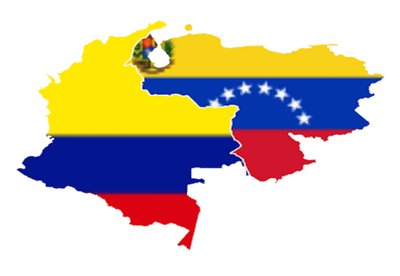
Chile remains largely isolated until 2025, when Argentina and Venezuela join in on Chile's extremist aggression and the three countries collectively - and successfully - impose their will by force upon the Americas.
The international community condemns Chile, Venezuela and Russia and calls on them to withdraw from Bolivia, Colombia, Ecuador, Central America and the Baltic States – particularly Venezuela with its support of El Salvador’s aggression in Nicaragua. Santiago and Buenos Aires respond with, “the needs of El Verde come first,” and declared their governments the rightful protectors of that nation-state, insisting the United States and Europe were attempting to fulfill a “socialist empire agenda,” in the Western Hemisphere and that they needed to be stopped, accelerating their attacks with a sizeable invasion and outright annexation of Ecuador and Peru. Following this Cuba, Chile and Venezuela begin plans for an attack on Baja California.
Using connections to the Venezuelan government and Cuban military elite, Texan paramilitary and Mexican drug cartels, Venezuela, Argentina and Chile seize upon the fragile North American continent to launch attacks in occupied Mexico preceding a massive offensive in Tijuana – putting the country at direct odds with the unrecognized, Californian-led territory – and unites the rival American countries of North America and the U.S. in one crucial commonality: prioritization of the end of Imperialist Venezuela. Chilean allies in Cuba and Venezuela pound Mexico with air strikes, heavy artillery and missiles while the Venezuelan navy and army assist the Cuban air strikes and bombings in Tijuana and Salvadoran terror attacks across the Baja California peninsula. The largest sites of conflict initially began in the first quarter 2025 in Los Cabos, Baja California Sur. A population of over 200,000 was displaced by the fighting between Chilean and Coalition forces, with nearly 70,000 caught in the warzone and 4,000 civilian dead by the end of hostilities.
The Battle of Tijuana and the subsequent and connected Siege of Mexicali lasted from July and August 2025 respectively until April 2027, with a total body count hovering around 20,000 with nearly 400,000 displaced. Although stretched thin, the U.S. military with assistance from North America, Canada, Colombia and NATO are able to repulse the Cuban–Venezuelan offensive on the continent by mid-2027, with the total in the Baja California Campaign at nearly 30,000 dead. And although the Venezuelans and their Cuban allies retreat to lick their wounds, the battle a defeat for them, this perceived slight against the Spanish state and Latin America as a whole by the North and their Allies would merely serve to fuel the burning passion across South America - particularly within Chilean society to reinvigorate the idea of Prussia and a feared Germanic counterbalance - to pose a challenge to the West and the East, with Brazil's quest for superpower status still as of yet incomplete, and seen as weak by the PNCR. As a result, the Pincer would solidify their control of the Venezuelan, Chilean and Peruvian governments, and accelerate still further their paramilitary and asymmetric attacks against Colombia, El Salvador and Ecuador. By the end of the year, El Salvador had been reclaimed by more moderate elements in line with the pro-American governments of Nicaragua and Guatemala and the pro-Venezuelan insurgency was thus pushed back and slowly tamped down throughout 2027 before being fully neutralized in early 2028, a ceasefire and surrender signed in San Salvador on 5 April 2030.
Azerbaijan-Bukhara (2024–2032)[]
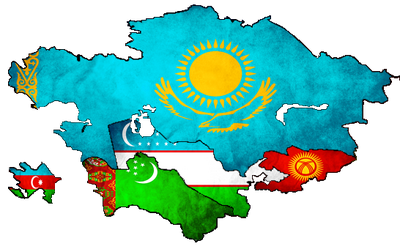
Although rather small individually, the eventual six nations that would come to constitute Azerbaijan-Bukhara, officially the Azeri-Bukharan Union, were collectively powerful and threatening.
As Azerbaijan did very little on its own in Europe, always relying on Kazakhstan, Uzbekistan or Turkmenistan for support, the framework of Azerbaijan-Bukhara holding up as a cohesive polity and military force (particularly with regard to the Azeri-Uzbek and Kazakh-Uzbek political and security relations) with respect to the close cooperation between the trio of countries (Azerbaijan, Kazakhstan and Uzbekistan), this core founded the bedrock of Turkic military operations in Europe, Asia and the Middle-East.
Although the 2027 attacks launched on Germany and other European countries alongside China were what got most of the attention by both contemporary and future scholars, in the years leading up to that Azerbaijan-Bukhara launched land invasions in five countries; Armenia, Afghanistan, Georgia, Iran and Tajikistan. The Kyrgyz and Kazakh militaries launched an invasion at the request of the Taliban to crush the Islamic State in Afghanistan at around the same time the Azeris and Uzbeks were attacking Armenia. A year later, Turcoman forces launched an incursion into eastern Georgia, and then a year after that Azerbaijan-Bukhara supported an ethnic uprising in northwestern Iran. Exhausted after 18 months of fighting against the Azeri uprising, Azerbaijan-Bukhara would formally launch an invasion and occupation of Azerbaijani Iran. The fighting would last another 5 years, until the formal collapse of Azerbaijan-Bukhara back into its individual founding member-states. Nearly 2 million would die as a result of these wars, 90% of the deaths concentrated in northwestern Iran.
The most militarized of Azerbaijan-Bukhara were Azerbaijan and Kazakhstan. With a population of nearly 90 million and a standing manpower of nearly 1 million, Azerbaijan-Bukhara was a powerhouse in the region, although individually most of its member-states were rather small. They were; Uzbekistan at 36 million, then Kazakhstan, with nearly 20 million, Azerbaijan with just over 10 million, Tajikistan at 9.7 million, Kyrgyzstan and Turkmenistan with 7 million each. The core military substructure proved to be that of the Azeri-Kazakh Special Relationship, with the political dimension carried out in Tashkent, Uzbekistan. While military was headquartered in Baku, Azerbaijan, as military and political activity extended back as early as the Ukrainian war in 2023.
The Georgian Civil War between Turcoman-backed Azerbaijani secessionists coincided with the Transnistrian coup in Moldova and the coups in Tajikistan, Kazakhstan and Serbia, in all of which are installed a pro-Chinese regime angled against the West at the behest of Beijing. Just over 48 hours later, the SCO, Organization of Turkic States, and the CIS sign documents in Beijing legally establishing the "Double-Axis" between China and Azerbaijan-Bukhara. Russia is noticeably absent from this, currently at odds with Azerbaijan over its actions in Georgia. With 7 member states and 2 observers in Serbia and Turkey, the Double Axis between the six Turkic states and China was the largest political and military organization in the world, with over 1.5 billion people between them.
Azerbaijani–Iranian Imperialism (2019–2027)[]
- See 2018 Brazilian intervention in Venezuela, Turkish intervention in the Syrian Civil War, 2023 Iranian nuclear bombing of Crimea, 2021 Israel–Palestine crisis, 2024–2026 Israeli civil war, Ukrainian Crisis, Russo–Ukrainian War, Kerch Strait incident, Francesco De Luca, Colombian Civil War, Verdean–Venezuelan Invasion of Colombia, Eurasian Union State, Val Verde Crisis, & Bosniak–Croat Uprising

The Azeri-Bukharan Defense Forces were among the 15 largest in the world with a total standing manpower of approximately 1,000,000 - clockwise from top-left; Azerbaijani S-300 missile launcher, Kazakh armored fighting vehicles, Uzbek HQ-9 missile launchers, Uzbek attack helicopter, Uzbek armored fighting vehicles, Kazakh rocket launchers
Russian and Turkish competing interests throughout the region accelerate in the 2020's, further endangering surrounding, smaller countries in their vicinity. Although increasingly isolated and regional, the surge of inter-ethnic and extremist violence in the former-USSR became a cause for concern among its neighbors and the international community writ-large. Nationalism took hold in Georgia's government due to the ongoing pan-Turkic and Russian separatist insurgencies in Abkhazia, South Ossetia and neighboring Armenia and Azerbaijan respectively, the conflicts there and in Nagorno-Karabakh metastasize and all across the ex-Soviet Republics a wave of pro-Russian and Livonian Nazbols and Ultra-nationalists seize power through any means necessary. As a result of Armenia's economic, security and political dependency on post-Soviet Russia and a crackdown in response to Georgian Nationalism, the two countries are primarily considered to have returned to being "captive nations" by the mid-2020's. China would foment a civil war in Iranian Azerbaijan in the 2020's, leading to the further destabilization and Chinese influence of that region.
Due to strained ties with Russia, Central Asian integration characterized the 2020's. By 2025, Azerbaijan-Bukhara spearheaded by Azerbaijan and Kazakhstan began to exert influence over the Turkic world, with Tajikistan becoming the final country to join in 2026, after a pro-Chinese coup establishes an a puppet regime in the country. Azerbaijan and Central Asia would become integrated politically, ideologically, economically and militarily with the political centre of the Union being located in Tashkent, Uzbekistan. Together, Azerbaijan-Bukhara boasted a truly imposing ground force, with an active duty manpower of 425,000, the 11th-largest in the world, the 9th-largest tank fleet at 3,000, 13th-largest armored vehicle fleet at 70,000, 9th-most Self-Propelled Guns, 10th-most towed artillery, and the 9th most rocket projectors just behind Iran. And the power and size and scope of their military-industrial complex would only grow over the next several years. Growing Azerbaijani influence in the South Caucasus, Pakistan and Afghanistan would complicate relations between Azerbaijan-Bukhara and the EU and Russia, who also competed with one another for influence over said countries.
Iranian and Azeri interests would become increasingly aligned against Armenia and its Western Allies over the next several years, as the two countries expanded relations with Azerbaijan opening up to Iran, and Iran increasingly recognizing autonomy for its Azeri community. Iran would come to collaborate with Azerbaijan's intervention into Lebanon against Armenians and Azerbaijan would in turn support Iran's intervention in Albania marking a significant escalation in Iranian imperialism after its material support for Russia's invasion of Ukraine, Iranian intervention in the Syrian Civil War and cruise missle and drone strikes on Israel in retaliation for [https://en.wikipedia.org/wiki/Israeli_bombing_of_the_Iranian_embassy_in_Damascus Israel's bombing of the Iranian embassy in Damascus on 1 April 2024.
Even before the 2023 uprising, US-Israel relations had been on the downturn since Obama and his ties to Iran, which would continue under his vice president's administration drawing condemnation from the opposition. Israel's far-right government, sworn in on 4 January 2023, would plunge the country into crisis several months later. This would result in a statement from the President of the United States himself rebuking the US-Israeli special relationship, and would be joined a week later by the EU and United Nations in his condemnation of the judicial reform. Soon after, the US and Israel wind up on opposite sides in Lebanon, and tensions are further frayed over Israel's support for Hungary's anti-LGBTQ law and Palestinian-Americans at Israeli border crossings.
Following the Hamas attack on Israel much of the Western governments would rally behind Israel, with Biden's White House ironically being among the loudest pro-Israel voices. Then-opposition leader Donald Trump would call for Netanyahu's resignation while progressives and Arab Americans would criticize Biden's blanc cheque to Israel's accelerating military campaign against Palestinian civilians, as a rare conflagration began to emerge in opposition to the Biden-Netanyahu Axis. Demonstrations would erupt across the world against Biden and Netanyahu, as well as in support of the Palestinian civilians under fire from Israeli retaliatory attacks over the next several months. Norway, Ireland, Spain, Luxembourg, France, the Netherlands, and Slovania had all called on Israel to show restraint, and supported a humanitarian ceasefire to allow aid in to the Palestinians and Gaza. Although a significant amount of the EU, China, Russia and Brazil all outright supported the Palestinians - the United States political establishment, particularly the Democratic and Republican establishments - would crack down on pro-Palestinian voices across the media as Islamophobia surges in the U.S.
Iranian–Israeli War of 2024[]
In 2024, the Iran–Israel proxy conflict escalated to a direct conflict between the two countries. On 1 April, Israel bombed the Iranian consulate in Damascus, killing multiple senior Iranian officials. In response, Iran and its proxies launched strikes inside Israel on 13 April.
After the Iranian Revolution, Iran took a more critical stance on Israel, and a proxy war emerged as Iran supported Lebanese Shia and Palestinian militants during the 1982 Lebanon War. Iran began to gain power and influence with other countries and groups. The conflict escalated with Israeli attempts to stop the Iranian nuclear program and confrontations during the Syrian civil war.
On 7 October 2023, Hamas, a Palestinian militant group partially funded by Iran, launched an attack on Israel resulting in almost 1,200 Israelis killed and the outbreak of the Israel-Hamas war. Israel also skirmished with Iranian proxy Hezbollah in Lebanon. After the attack, Israel began targeting Iranian and proxy troops in Syria more frequently as retaliation. Fears of a regional war grew in the following months.
On 1 April, Israel bombed the Iranian embassy in Damascus, Syria. The attack killed 16 people, including multiple Iranian officers and proxy fighters. Most notably, Mohammad Reza Zahedi, a commander for the Quds Force was killed in the airstrike. Iranian officials in the building were allegedly meeting with Palestinian militant leaders at the time of the attack.
Iran vowed to respond, and Western sources suspected it would attack directly inside Israel. Israel began preparing in the days leading up to the attack, evacuating Israeli embassies and jamming GPS signals in the case of an aerial bombing. France deployed its navy to defend Israel. On 13 April, Iran seized an Israeli-linked ship in the Strait of Hormuz. Later that day, Iran and its proxies attacked Israel with over 200 drones and multiple ballistic missiles. The United States, United Kingdom, and Jordan intercepted over 100 Iranian drones. The drones and missiles eventually hit various cities and military bases across Israel, the West Bank, and Golan Heights. At least 32 civilians were injured in the attack.
In response, the recent condemnation of Israeli conduct in the war in Gaza would evaporate virtually overnight in the United States and United Kingdom, with their political establishment recongregating into a pro-Israel coalition calling for war against Iran. Israel would begin strikes against Iranian, IRGC and Quds Forces bases. The sudden momentum and aggressive offence of the Israeli attacks would reinvigorate Biden and the Democrats' support for Israel and it would remain resolute for decades afterward. Nothing would break the ideological Zionist resolve of Anglo-American liberals from that point on, with Zionism entering a "golden age" in the West almost immediately after the cessation of hostilities, despite their inconclusive nature.
All-in-all roughly 340,000-370,000 would perish in the Iranian–Israeli hostilities, a vast majority of the casualties being Palestinian children, women and men. G7 support for Israel would remain strong and unified in the face of Israel's atrocities in Gaza and the West Bank - with many international bodies, including the UN and the ICC, finding the G7 leadership "complicit" in Israel's genocide in Gaza.
Balkan Offensive[]
On April the 18th, the détente standoff between the NATO-European defense alliance and Axis Forces comes to an end a little over two years later as a Hungarian and Azeri-Bukharan–Chinese force invades the Federation of Bosnia and Herzegovina, Northwestern Romania, Western Ukraine, Kyiv and Cluj in Northwestern Romania from the six oblasts in Eastern Ukraine they occupied at the time, and Chinese–Hungarian air and mechanized units attack Slovakia, Czechia, Poland and NATO air craft attack the Serb-occupied East Bosnia-Herzegovina. This date is marked by many historians as the final major armed campaign of WWIII with the rest following a continuation of this same battle. The presence of over 17 active pro-Russian insurgencies across the continent decidedly evens the playing field - with Bosnia, Croatia, England, Finland, Germany, Italy, Poland, Romania, Norway, Sweden, Slovakia and even France all weary fighting against Russian-backed uprisings in various regions, with Bosnia and Croatia potentially the weakest links of them all. The Bosnian government quickly surrenders, and the Balkan nation is temporarily occupied by Russian-backed Serbian partisans. With the joint-attack by Azerbaijan-Bukhara and China (supported materially by Chile, logistically by other Latin American nations and China) upon EU and NATO forces, followed by an intervention into Mainland Europe and Austria from the opposite direction of Livonia (which attack from the northeast) and an emboldened Chile's PNCR-backed attack on Central America a few days later – the aforementioned regions would not cease hostilities until the end of the War. French and Italian units head them off in southern North Macedonia and the Alps. Bombardment continues throughout the rest of the month and into May. In June; French, North American and Italian forces commit a sizable attack in Bosnia thereafter. With a multilateral and continental counterattack, Azeri–Chinese forces are knocked back riotously by NATO but are reinforced by Korean and Chinese air support.
Due to being associated with the Vatican deep state, Texan involvement in the United States prompts the EU to break off any and all relations with the United States of America, and sanction Dallas. The Italian government and Prime Minister sound the alarm after evidence emerges that the Luca Presidency was connected to Italian organized crime and North American drug cartels. The Italian government and over half of the military declare the Luca brothers "political terrorists," and call upon the Nordic Battlegroup alongside France for protection from the Lucists. The governments of France, Germany, Italy, Portugal, Belgium, Luxembourg, Holland, Ireland, Sweden and Finland sign the 'Europa Articles of Confederation' later that week, which effectively inaugurate the "nation of Europe," as a de-facto nation-state of constituent countries, mainly as a symbolic but prominent rebuke to the Luca Presidency that they no longer considered the legitimate government of Italy, but primarily out of the realization that they could no longer rely solely on NATO and the United States for protection. NATO – at the highest levels of government – launch a last ditch attempt to distract away from their ties to the Kim Dynasty, the Lucas (via Bush, Clinton and Trump), Kerry and Russia, by accusing the French of providing the bulk of the missile systems to the Chinese–Azeri offensive, when in fact it was Seoul. Infuriated, IF-led initiatives result in a “balkanizing” process of the US. The insurgencies in New York, Pennsylvania and Louisiana largely quelled by the voices of calm and reason that emerge as the nominees of the Democratic and Republican parties both in 2027 - Buttigieg and President Paul respectively, which manage to bring all territories aside from Texas back into the fold temporarily - including most of Southern California - much to the chagrin of the Atlantic and Central Americans. But the cohesion of the Union is weakened, 14 fully- or partially-recognized autonomous entities in place of one, with the previous 50 states collapsed down to 39 states (Maryland, New Jersey and Delaware would unite to form the 'Atlantic State,' with Arizona, California, Illinois, Minnesota, Illinois, and Utah attaining full independence while Michigan, Pennsylvania, New York, Long Island and Hawaii attain partially-independent autonomy) and at least 17 of which were home to ongoing active insurgencies and 1 of which (Dixon) was largely considered a rogue territory no longer under the purview of the U.S. federal government. Under his administration, Buttigieg promises to bring an absolute end to the insurgencies in the Midwest and Southwest, and bring the rest of California back into the United States as well as any other impoverished nation that may wish to share the wealth and prosperity afforded to the Union as it was intended. By appealing to progressives as well as libertarians, peaceful interventionism, the Anti-War Left and constitutionalism former-Sec. Buttigieg is able to emerge in the primary as the nominee, and run neck-in-neck with Paul throughout the fall and into the spring of 2028.

Francesco De Luca, President of Italy, (along with his twin-brother Luciano) becomes known as one of the main causes of WWIII.
With angry men and women in uniform marching on D.C. from Arlington VA in support of the U.S., the UN and opposition to Russia's Security Council seat, US support for Israel, the emerging Texan-spearheaded 'Atlantic State'; A.S. and Texan riot control respond in the way they would to an unruly protest demonstration or ‘riot’ – what they do not expect is a full-fledged military assault into the A.S. – the skirmish lasts 15 minutes and ends only as Texan Governor-General Bush threatens to nuke the Capitol building and Eastern Manhattan – specifically, UN headquarters. Beijing and Norfolk also threaten to detonate nuclear weapons over Mexico City out of opposition to North America whom they accuse of being behind the foundation of the "new confederation" of the A.S. and the rise of the Texan rogue state under Bush – and with nearly a fifth of the population of the US at risk, President-elect Buttigieg backs down at the behest of the acting president, but not without voicing his concerns about a development that – coincidentally or otherwise – occurred on the same day that the D.C.-Manhattan Crisis did so, the Chinese–Azeri-Bukharan offensive.
2025 Mexican Civil War[]
In February of 2025, the administration of Manuel Lopez Obrador, an opponent of the North American movement, was overthrown by Mexican far-right nationalists in league with the major drug cartels and China. This new government orchestrated coups in conjunction with a Texas far-right syndicate in control of the state government. When Texas attained independence later that year, coups accelerated across Central America, a junta in El Salvador, an autocrat in Nicaragua. These governments were the core backbone of the North American project, seen as an alternate and rising alternative to the United States for Latin American countries.
Iranian–Azerbaijani Insurgency in Albania and Lebanon[]
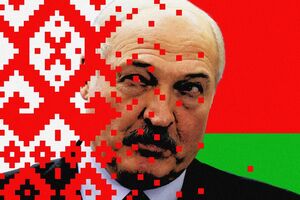
Alexander Lukashenko, President of Livonia, would rule the country from 1994 until 2027 as Europe's "Last Dictator"
Shortly before the April 18th offense, North Korea, Iran, Azerbaijan and Russia order troop presence in Lebanon after falsified reports come out (originating in Israel) of Interpol claiming Albanian, Armenian Lebanese, Lebanese Christians and Hezbollah forces were behind terror attacks in Banja Luka and Mostar (it was actually the Wagner Group, a Pan–Slavic ultranationalist terror group). Concurrently with the Balkan Emergency, Israeli and UN–Turkish-backed forces stand off along demarcated buffer zones in Shuja'iyyat al-Akrad, Madinat al-Baath and Jubata al-Khashab - with skirmishes at first and then erupting into full-blown conflict from early May until mid-July.
The Israeli State collapses into civil war between Israelis assisting Palestine, Israeli Arabs allied with the Arab League, and Israeli State Loyalists shortly after Azerbaijan, Livonia and North Korea orchestrate a a far-right coup that topples the government and Tel Aviv. Cairo and Bethlehem maintain a sanctuary presence in the areas of conflict, assisted via air drops and air strikes by the United States, Arab League and Britain. Saudi Arabia, Egypt and Morocco respond with anti-air and missile strikes against a Russian-backed flotilla in the Mediterranean, which is complemented by a Serb shock-and-awe campaign spearheaded by the 641 supported by Chinese and Turkic air forces and HQ-9 missile strikes. The Russians maintain an expansionist presence of varying degrees in the Levant and Middle-East throughout the war using Turkey as a foil, following the CSTO–Chinese offensive. With Russia, Iran, Azerbaijan-Bukhara and North Korea's attack on Syria and Lebanon, and Serbs dug in like a tick in northeastern Albania, NATO is stretched thin and kept engaged on multiple fronts simultaneously by Neo-Fascist Russia, Azerbaijan-Bukhara and their Chinese allies.

President-elect Buttigieg's connections drawn between Italy's President Luca, Azeri-Bukharan–Chinese insurgents and the Manhattan Crisis the following year are, at first, compared to the Trump-Putin conspiracy.
The Balkan Emergency was formally recognized worldwide by November Third after NATO fell back, delivering parting strikes on IF and Pact forces alike. The dispute is assessed diplomatically between RECON and Brussels at a meeting between the two sides. NATO Supreme Commander Timothy M. Ray accuses IF forces of ‘getting in the way’ and convoluting NATO’s campaign. Eventually ties warm after the IF and NATO (as well as the United States and AS) agrees to set aside differences and focus on their mutual foe: rogue theocratic extremists and the Pact – particularly Russia, its allies in Azerbaijan and China, and El Verde – which the Triple Axis refused to support outright but shared goals of defeating the West. But the event in question that President-elect Buttigieg addresses does not have to do with the Balkan Emergency, it has to do with what else RECON found on their classified mission, which is soon echoed by Luca's announcement of the return of the notoriously-fascist and grotesque Iron Guard. The Argentine-backed Italian ultranationalists now occupying Northern Italy announce an exchange in government structure – into the hands of the Luca Dynasty – and a change of name, the Legion of the Archangel, and – even more terrifying - the establishment of the LA Iron Legion secret police force, which shortly thereafter transforms into an assassin army of covert death squads. The infamy of the unusual morbidity of the originally-Romanian Iron Guard – even for a fascist movement – was well-known throughout World War II. Even the Mussolini faction of Italian Fascists distanced themselves from this “death cult”. Nevertheless, nearly a century later, the repugnant organization had returned, proudly displaying its devoutly murderous ideology which, in conjunction with its radical theocratic Christian martyrdom and its sinister and militaristic application thereof, was compared to a “Taliban on Steroids”.
The legacy of Argentine-backed Francesco and Luciano De Luca and the “Iron Legionnaire State” is one of unparalleled authoritarianism not seen since Putin, in fact – far more so. The Totalitarian suppression of dissent and freedom of speech – not to mention the presence of Iron Legionnaires, coupled with Luca militant expansionism – serves to put the Lucas in the same category as Adolf Hitler by the end of the decade. Although China and Azerbaijan-Bukhara stand by their mutual Pacific compatriot, even Beijing and Baku begin to distance themselves from the increasingly neo-fascist, hyper-nationalist foreign policy and ideology of Chile’s totalitarian and xenophobic president Salazar, whom they even claim several times throughout the next decade that such desires would endanger not only all of Latin America, but all of America and the world as a whole.
Verdean–Venezuelan Invasion of Colombia[]
Tensions between El Verde and virtually all of South America save Venezuela escalate suddenly and rapidly in the early 2020's, with the military and far right praise of the Pinochet dictatorship in Chile, taking place the same year Colombia's ongoing civil war commenced. In 2025, after years of rapproachment between El Verde, India, Russia and China, Chile's president is assassinated and Jose Antonio Kast, alongside the military, seizes absolute power. Soon after, using their entire air force and frigates, El Verde takes out Colombia's docked submarine fleet and attacks Paramaribo to the north. Venezuela declares war on the Guyanas and Colombia, El Verde following suit.
As Chile was effectively a satellite state of Venezuela, their involvement in the tensions could not be fully ruled out. Chile, by 2025, was entirely reliant upon China economically, and Venezuela militarily. All of Venezuela's actions during the war were in lockstep with Verdean, Chinese, and wider Russian interests in the region. Venezuela contributed troops to a number of Verdean ventures throughout the war on the Southern Front, in addition equipment and other logistics support. Venezuelan troops were seen fighting among the Hungarians during their war with Slovakia, and supporting the Chinese in Pakistan and Iran. The pattern fit, as Venezuela aided in attacks on Colombia, Saudi Arabia, India and Central Europe, Venezuela would continue to be a client state of the Russians until at least 2029.
El Verde and Venezuela sweeps across the Llanos, overpowering Colombia with sheer air power and ground force tonnage and the 2nd-largest army on the planet, even ignoring the vast array of support lent to the war effort by Venezuela that El Verde had access to. However, Colombia would bounce back after an intense counteroffensive launched from the North Andes in Eastern Colombia after holding the invaders off for a year and a half. Beginning in 2027, the Colombians would launch offensive after offensive into the Verdeam puppet-state of Amazonian Colombia until the war's end and the surrender of Colombian Amazonia.
Chilean–Venezuelan Occupation of West Bolivia[]
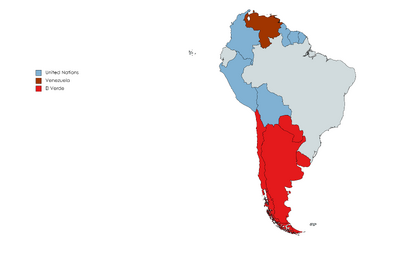
Venezuela and Chile would occupy West Bolivia and parts of West Guyana from 2025 to 2027
Following the two-pronged attacks into Bolivia and Brazil from Venezuela in the North, and Chile to the South, into Western Bolivia the two military powerhouses had La Paz surrounded, with Chilean soldiers becoming a regular sight in West La Paz by late 2025. Peru would switch sides in 2026 following a Chilean invasion, and begin assisting East Bolivia and La Paz in insurgent attacks throughout Northern Chile and Northwestern Brazil. The Amazon would become a prominent battleground in Bolivia and Colombia's fight for freedom. In early 2027 Bolivian forces launch an assault to liberate the rest of La Paz from Chilean occupiers. The Chileans are underprepared, and Brazil - fighting elsewhere in its focus - is unable to assist. Chile is pushed back and the Northern Lowlands leave the Venezuelans greatly exposed to a Bolivian-Peruvian-US military follow-up attack, the geography aiding the Allies in repulsing Chilean and Venezuelan occupiers by late 2027.
Hungarian and Serb Civil Wars[]
The Hungarian Civil War to oust Prime Minister Orban and the insurgency in Republika Srpska to break Dodik's stranglehold on Serbia would begin in 2026 and last through various degrees of tension throughout the war. The West and NATO backed the insurgent Pro-Vucic faction based out of Belgrade in its war in Bosnia-Herzegovina. Likewise, the EU and NATO would back the Anti-Orban movement in Hungary. The Serbs would fold first, backed by a NATO and Greek-spearheaded mission to liberate the country from the Dodik regime. The Orban and Radu insurgency based in Transylvania would last throughout the war.
Conflict Escalates[]
- See: Fall of Norfolk, Eurasia and Latin America Attack the United States, Arab–Russian Siege of Greece & Turkey, Russo–Livonian Invasion of Scandinavia, Romanian Civil War & Central-East African Conflict
- (November 2026)
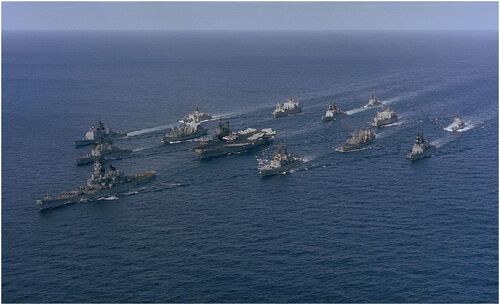
UN warships and aircraft (led by the Russian supercarrier Shtorm) from the Latin American and Eurasian countries of Azerbaijan, Brazil, Chile, Colombia, Kazakhstan, China, Peru, Turkmenistan, Uzbekistan, Iran, Serbia and the Russian Union State en route to attack the United States. (11/14/26)
2026[]
November – The Japanese government declares the Axis of Resistance an illegal organization, and that China's expansionism and allying with Russian and Korean expansion into Europe and Asia respectively was a violation of international law. The Independence Front (citing their policy of non-alignment and prevention of nuclear arms race), along with the states loyal to the “Pact” – abstain, although this does nothing to prevent the continuing Russian–Belarusian imperialism, and thus, the CSTO-spearheaded Axis and their allies. The US embassy is closed in China, further gaping the already massive rift between NATO-aligned and IF-aligned countries. With the suspension of U.S.–Chinese relations, Shanghai quietly gives SCO and ASEAN member-states a silent nod of approval for their support of the Pact (although only Myanmar and Laos would formally join), and soon after retract their statements critical of Chile, Serbia and Russia. As China retreats into isolation, dealing with internal uprising and continuing conflict with the H.K.-Taiwanese Republics, the Pact expands from its founding members to include all of the former-Shanghai Pact nations (except SK), all of Southeast Asia, including New Zealand and all the countries of the MERCOSUR as observers. The MERCOSUR, however, had fallen into a deep state of recession as Brazil, the largest country in the region, erupted in civil war that would last until the 2030's.
With a UN-spearheaded international and intercontinental military alliance of nearly 30 countries, the PLA and CPS had effectively leveled the playing field with no more than a quick 30 minute meeting and no more than a few sentences. Unfortunately for the CPS, this calculated move would turn out to be an unforced error benefiting the neighboring Modi and Kim regimes and their loyal, incredibly extremist, government and sleeper cells.
Russia and Azerbaijan-Bukhara (the latter of whom had acquired nearly a dozen former-US assets from Chile a few months earlier) of the Eurasian Commonwealth were 2 of only 3 naval powers to field Cruisers, while Russia and Azerbaijan-Bukhara had among the largest and most powerful air forces respectively supported by a fleet of over 300 commissioned vessels spearheaded by 2 aircraft carriers and a supercarrier. In addition, Russia and China possessed thousands of ICBM, mounted on a fleet of dozens of submarine warships and hundreds of other warhead-delivery platforms, and untold supplies of other chemical, mechanical and biological weapons.
With the US sanctioned, Africa in turmoil, and NATO forces bogged down in the conflict overseas, when NORAD goes dark barely any military forces active there realize. With the North American continent blind, isolated and wide-open, and 4 of the 10 active US supercarriers (one had gone missing in the Mediterranean a half-hour after the nuking), along with nearly 100 (nearly a third) of the U.S. surface fleet docked at Naval Base Norfolk, and roughly a quarter of America’s Air Power stationed there as well – what happens next would remain burned into the collective unconscious of Western Civilization for centuries...

Geopolitical alignments one year after the Balkan Offensive (18 April 2027).
November 14th – The Nuclear Bombing of Colorado Springs was at first attributed to terrorism, but later found out to be Grey Wolves extremists with assistance from the Belarusian KGB. Over 200,000 people are killed instantaneously and another 100,000 by the Wars’ end, the nation is paralyzed. Before anything can be done to alleviate the absence of NORAD and air reconnaissance, with roughly half of America’s military in North Africa fighting against the Serbs and Syrian Arabs backed by China, Oman and Russia alongside an international effort to curtail the damage of the bombing’s fallout, literally beyond the radar, 5 carriers, the 1,100-foot-long, 100,000-ton "Project 23000 E" "Shtorm" supercarrier from Russia, the Brazilian helicopter carrier NAM Atlântico and a strike group of dozens of other Eurasian and Latin American warships of various class show up along the horizon beyond Naval Station Norfolk, supported by an air fleet of many warplanes belonging to Latin America, Azerbaijan-Bukhara, Iran, China and Russia. All now flew the flag of the United Nations. The sleeping giant is, poetically-speaking, slain in his slumber. The flagship, the dreadnought battleship formerly known as the Peruvian battlecruiser "Almirante Grau," and now known by the Kazakhs as the infamous Темір Қошқар ("Iron Ram"), launches a missile bombardment – with accompanying strikes from the carrier strike group – effectively neutralizing the base’s and docked carriers’ shoreline and air defense systems in one fell swoop. Following this – a joint-squadron assault of Russian, Azerbaijani, Belarusian, Brazilian, Chinese, Kazakh, Kyrgyz, Tajik, Turkmen and Uzbek air forces, fighters, bombers, and attack helicopters bombard, and destroy, the four docked supercarriers, and over the course of a half-hour (even amid a hastily thrown-together counterattack from Norfolk forces stationed there and abroad), with staggeringly-high levels of ballistics support from the surface battalion (nearly 300 ships “spilling” out of the canal, able to be seen from orbit) the entire base is wiped out – along with every man, officer and military asset – down to the last scrap of equipment – erased from existence.
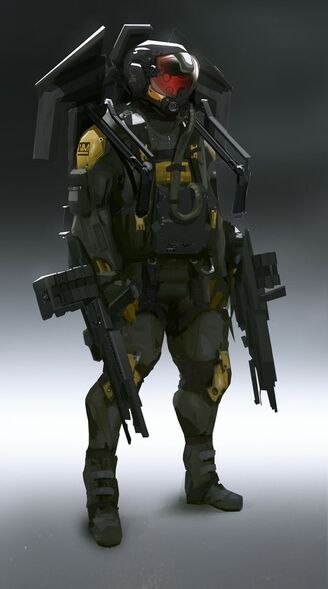
A masked vigilante in a power-suit known only by a nickname prescribed by witnesses simply calling him the “SHIELD” - Sanctioned High-Exertion Lethal Deviant (revealed to be a protégé of the original Mothman vigilante – who was originally believed to be a cryptid) launches a one-man guerrilla war against government officials and police shortly after Kerry takes the White House in the mid 2020’s. (Image: "SHIELD" – believed to be former-military-police officer and private detective Jonathan P. Sharp) He eventually flees the States, after the CIA and Intelligence Community call on RECON to investigate him. They eventually find him and end up in a ‘tug-o-war’ with Kerry for the suit’s technology – realizing that a stateside invasion could be imminent.
Knowing full-well the staggering level of martial power the United States possessed, the entire continent of North America is paralyzed in terror. The Union State and their allies in China, Latin America and Iran had effectively yanked the titan that was once the U.S. military down to their level by its Achilles’ tendon, while simultaneously allowing the Atlantic State the opportunity to assert its sovereignty and control of the region, starting with Naval Base Norfolk. Every strategic move made by the Union State, Brazil, Iran and China had been executed perfectly and without error – and now the U.S. was fighting an almost even battle with Russia alone, and China had officially eclipsed U.S. administrative prowess. To make matters even worse – a naval strike battalion of hundreds of Kim-loyalists composed of the North Korean navy was on its way across the pacific, the Chinese puppet-state of Korea was positioning the 655-vessel-strong fleet it now had power over into a threatening geographically-strategic formation at premeditated locations across the world, and U.S.-backed Korean Republicans were powerless to do anything about it.
Less than 24 hours later, NATO invokes Article 5 of the Collective Defense Treaty and multilaterally declares war on China, Iran, the Union State of Russia and Belarus and the United Nations for attacking NATO, and thus attacking their territorial integrity, as well as the theft of nuclear weapons and other hardware from the US – originally attributed to the nation in question.
"Eleven-Fourteen" or "11/14" is seen as the second-major military defeat of the U.S. in WWIII, much like its counterpart catastrophe, Nine-Eleven "9/11", wherein thousands - both military and otherwise - perish at the hands of hostile actors due to U.S. government ineptitude.
China, Iran, Brazil and Russia emerge as the Germany, Ottoman Turkey, Bulgaria and Austria-Hungary of the ongoing Third Global Confrontation. With NATO on one side and the Eurasian-spearheaded UN on the other, our embattled planet Earth’s various warring nations, territories and governments had solidified into two, roughly three, adversarial factions vying for control of said associated territories.
This was the Apex of World War III.
The Apex of WW3[]
- See: Brazilian–Caribbean Territorial Crisis, NATO Declares War on China, NATO Declares War on Iran, NATO Declares War on Brazil, NATO Declares War on the United Nations, NATO Declares War on Eurasia, Livonia and Russia Declare War on the United States, Iran declares war on the U.S., NATO Invasion of North Bolivia, Chinese–Turkish invasion of Central Asia & Russian Invasion of Ukraine
2027[]
February – Guerrilla and asymmetric warfare being waged by Chilean, Cuban and Venezuelan military forces and insurgents in Bolivia, Uruguay and the Falkland Isles against Islander military and U.S. elements since the culmination of the Second Korean War, and the South America and Balkan Offensive proxy conflicts between the United Nations and North Korea, escalates to a new all-time high when a high-ranking Islander politician and ambassador to the IF is assassinated by pro-Venezuelan and Chilean militia via carefully-placed moles in the Falklandic and Uruguayan governments. The outcry causes the Falklands and United Kingdom to declare a state of emergency, and it isn’t but a few days later that public demonstrations against the executive order spread like wildfire. The Chilean and Venezuelan-backed movement `Grupo de Amigos Personales (GAP) was discovered to be what the antigovernmental demonstrations primarily consisted of after investigations into the nature of the controversy were launched by the CIA, MI6 and RECON. Further investigations revealed obvious war-crimes and human rights violations, all of which were being ignored or covered up, or both, by Cuba, Peru, and other Chilean and Venezuelan allies. Discovering this, the US deployed immediate reaction groups based around RECON and NATO primarily associated with regional disaster relief response and political crises.
The alarm sets in throughout South America, with revelations that Chile, Peru, Cuba and Venezuela had been supporting the movements financially, and cooperating clandestinely under the careful cover of Kremlin and Beijing whitewashing for closer military cooperation, and plans to cripple the South American, and by extension, the US economy and gain a long-sought foothold in the Western hemisphere for their allies in Russia and China. With efforts put forth by the Atlantic and Colombian governments, all of South America rally behind Bolivia and the Falklands in opposition to the GAP strike-teams. Left-wing and syncretic ultra-nationalism sees the opposition to GAP only increase its power and influence in Chile and Venezuela, and by the early months of the very next year, GAP and the Pincer both indirectly and directly controls the Peruvian, Chilean, Cuban, Tunisian and Venezuelan governments. Russian-occupied Hokkaido, and GIS units led by Volkan Jamakovic, assisted heavily in this endeavor. The revelation of this to all of America, including the North Americans, results in widespread condemnation of English Chancellor Pharaoh, China, Chile, Cuba and the Venezuelan far-right government and an intense territorial crisis between Bolivia on the defense, and Chile and Venezuela on the attack, as the latter begins deploying the Venezuelan Army and GAP insurgents respectively across Amazon, quickly establishing military superiority in the region and temporarily halving the country of Bolivia. Their efforts are discovered and cut off by the end of the second day and beginning of the third night of Venezuelan military exercises. The result is full-blown conflict and an intense Bolivian Civil War. Said Verdean-instigated conflict reverberates throughout Latin America for years to come.
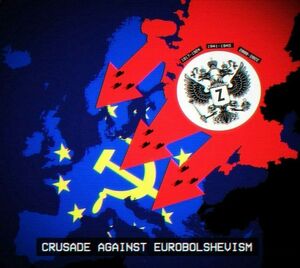
An example of Russian imperialist propaganda c. 2022
With the Russians and Livonians terrorizing Europe, South America in flames, Pakistan and Saudi Arabia on the verge of attacking India and Iran, the worst was yet to come. Proxy wars wrought havoc across Africa and Asia as the Russian and Chinese bears leveraged their satellite states across Europe, Asia, Africa and South America - descending the following continents into protracted and asymmetric yet interconnected conflicts. There were no neat "fronts" as in the other World Wars, rather a collection of concurrent wars across the globe, confined to their various regions, Southeastern and Eastern Europe were under attack by Russia, Azerbaijan-Bukhara, and to a lesser extent, China. Although the Chinese tried to stay out of most of the fighting, limiting their involvement to just outside their sphere of influence, attacking Taiwan, Ryukyu and South Korea. The front lines of the war became the Korean DMZ - against China, the Iranian-Azeri border - against Azerbaijan, and the Kuril Islands - against Russia. But as time would tell, these were mere pawns in the greater strategy.
Chinese–Korean invasion of Kyushu[]
Although by 2026 the North had near-total control over the South; its economy, its military, its infrastructure and labor force, etc. the issue of U.S. and Japanese-backed right-wing Republican insurgents puts the entirety of the territory of the South into a state of emergency. The nuclear bombing had crippled the South's leadership, and the North continued to exert greater and greater control.
In 2027, the Koreans made one of their final major pushes in the war effort. A massing of Korean and Chinese military contractor equipment such as tanks, armored vehicles and an army of over 500,000 active duty, reserve and paramilitary begin pouring into Seoul. As predicted, Korea, backed by China, invades the island in a conflict that results in the deaths of 200,000, which constitutes in the eyes of many a genocide.
A month later, Korean and Chinese forces invade Fukuoka and a Korean–Chinese intervention in the Busan Civil War backed by China week after that precipitates violence on the Korean Peninsula. The massing of Chinese and Korean forces in South Korea is used to strike at U.S. military bases in Japan and Ryukyu, exacerbating tensions with Japan and thus NATO, as well as US-backed rebels in Siberia.
UN War Bots[]
- See: Liberation of the Balearic Isles, India declares war on Pakistan, Cuban–Chilean Invasion of Mexico, Azeri-Bukharan DEMO Strikes on Sicily and Scotland, Chinese–led Invasion of the EU, MAWS & Azeri-Bukharan–Chinese Invasion of Germany
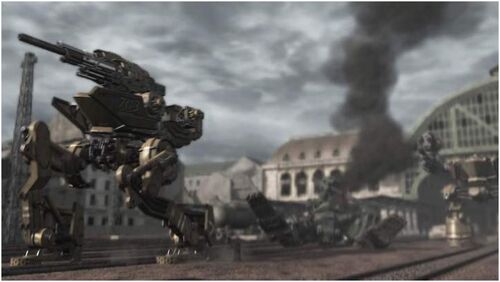
Two Brazilian ‘MAWS’ (Mechanized Autonomous Weapon Systems) defend a heavily-damaged Chinese unit, c. 2027
2027[]
June – The Scottish Prime Minister and the House of Commons call on RECON for an emergency summit between IF and NATO powers in regards to a massive buildup of troops and armor on the border between Scotland and England. NATO declines the invitation, but the IF attends with rigor, still at odds over Pharaoh’s justifiably unfulfilled demand that the US cede Virginia, Georgia and the Carolinas back to the Crown. Just a week ago Queen Elizabeth II had died, and Great Britain, transformed by the British Civil War, Rebel England and Third Global Conflict, splits the Monarchy down the middle between those loyal to England and those supporting a reunification of Britain. The latter are forced into exile, but Scotland and Ireland pledge to defend them from their political opponents.
The highlights at the meeting are Pharaoh’s steady – but gradually declining – cooperation with Turkey and Azerbaijan-Bukhara invading the islands of Cyprus, Crete and Rhodes. Apparently, Pharaoh had cooperated with the Saudi Royal Family, Islamist and JaF assets to sow conflict in the Middle-East and Central Asia to distract from the invasion of the islands, due to the presence of anti-Pharaoh rebels on the island. Through cooperation with RECON, the British government-in-exile begins plans for a coup to overthrow Chancellor Pharaoh and his supporters in London. Meanwhile, RECON-Unit 1-11 and NATO forces arrive in the Dodecanese to beat back Azeri and Russian-backed forces attacking the island. Unit 1-11, with heavy assistance from France, Greece and Italy, defeat the Azeris and free the Greeks, Cypriots and Turks from enemy hands.
August – The EU and U.S. declare military action, steamrolling the Aegean and Western Bosnia and invading Turkish-occupied Syria, Greek Cyprus and Crete, before Azerbaijan's launching of an ICBM barrage at French and Italian bases across the Adriatic and Sicily from forward operating bases off the coast of Syria and North Cyprus, in addition to the detonations of two nuclear warheads in Kashmir and Kaliningrad by China and NATO out of retaliation against a NATO–U.S. invasion of Syria and an unsuccessful Arab-led Invasion of Turkey. Nearly a million are killed almost instantaneously. NATO and IF are on-site within the hour, with Canada, France, Italy, Germany, Poland and Spain committing a majority of their amenable military forces supported by the 67 NATO-Allied UN (as well as the other 20 Nations openly opposing COSECTOR) into UNTAES and UNMIK zones in Serbia, where a Hungarian–Serbian Joint-Force led by Transylvanian Dictator Dragomir Radu is waging guerrilla warfare. Hungarian partisans, supported by Serbia and Szekely ultranationalist paramilitary and armed battalions and armies led by Radu and the Russians, attempts to establish a foothold, but Coalition forces are able to beat back the invaders by September.
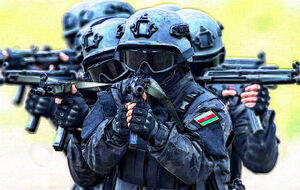
Azerbaijani 641st – Dəniz Xüsusi Əməliyyatlar Briqadası "Naval Special Operations Brigade" – working in conjunction with the Leishen-雷神突击队 and the "Blade Commandos"-利刃突击队 were crucial to the CSTO Summer 2027 offensive in the Mediterranean, Balkans and Central Europe
Late August – Chinese–Turkic infiltrators seize upon the finance-weary Balkans to bolster and erect an effective bulwark powerful enough to threaten most of Eastern Europe. An international summit convenes between the EU, Scotland, NATO and beleaguered Ukrainian opposition in Bratislava, Slovakia, at the behest of the Slovak President in Grassalkovich Palace - the last stronghold of Czechs, and Slovaks of the Slovak Republic of Central Europe - Slovenskل Stredoeurَpska Republika (SSR). It is when the leaders of NATO are convened that a bombing eliminates most of NATO’s command structure… immediately followed by an occupation and invasion of Slovakia and the Czech Republic by Azerbaijani Ground Forces. The invasion of Europe by a united Turkic force and the Chinese-Serb offensive earlier that month provides a distraction, putting the entire region into shock.
Azerbaijan-Bukhara, North Korea and Serbia's carrier task force enter and occupy the Balkans, utilizing 2 million soldiers, 8,000 AFV, 5,000 tanks, 500 MLRs, and 600 SPGs, as well as half of their air force – roughly 5,000 craft to push the Allies back. The Serbs and Turks, led by Radu, Beijing and infamous Livonian Secret Police Chief Nikita Kravychko, shut down the Romanian communes by pouring over a third of their entire military strength into the regions, quickly locking down the city and setting up a forward operating base to allow their air craft to join in on the bombardment and invasion of the communes. Before anything can be done, the Azeris quickly shut down Austria, sending half of the invasion force north, and the other half south – back into the Turk-occupied Austrian South. Their MLRs and SPG – as well as all air powers – remain in Austria, but are suspiciously ordered northeast shortly thereafter. With over a third of their missile strength aimed for mainland Europe, the Azeri–Chinese force drives home their implied message with one final saber-swing. The top-secret U.S. orbital strike (Directed Energy Munitions Orbiter – “DEMO”) program (stationed in orbit over Western Europe to safeguard the United States’ NATO allies from potential Eurasian attack in the 21st Century) went offline in early August and by August 11th it was made abundantly clear that this was a Chinese-caused problem. Controlled by Azerbaijan-Bukhara in 2027 and, later, - via Chinese infiltrators - Beijing and Belgrade by this time – the Serbian government faced a sizable NATO-spearheaded invasion from European forces roughly a week later and used the weapon at the request of Serbia on the resistance in Zilina and Brno, destroyed and rendered vast areas of the region uninhabitable, killing an estimate 286,664, a still-devastatingly-high body-count that could have been as high as 1,000,000 had RECON not done their part to get as many civilians and resistance fighters to safety.
Unfortunately, their actions prove for naught. A few minutes later, before the weapon can be shot down, Mirziyoyev orders a DEMO strike on Rhodes, Cyprus and the Northern Isles out of retaliation for the EU's threats. The islands are destroyed, and rendered uninhabitable – 651,023 people are killed instantaneously. Greece immediately after invades Serbia and North Macedonia from Albania and Bulgaria leading to the Siege of Novi Sad that lasts through varying, tapering degrees of escalation throughout WWIII, and the destruction wrought by this time provides enough of a distraction to allow Ok Saroy Palace, which had been (unknowingly) cooperating with the Kremlin, Azeri XKX, Ak Orda Palace and Zhongnanhai since the end of the Cold War to pioneer the penultimate orbital WMD, to unleash a monster upon their enemies the likes of which nobody to ever walk the Earth has ever before witnessed.
September 2027 – Hidden amid the thousands of satellites and pieces of debris orbiting Earth, a weapon system far beyond the level of technological advancement of any combination of dominant economies or militaries the forces of Earth could ever hope to bolster sat just beyond the prying eyes of the Human Race. Brazil, the Arab League, Azerbaijan-Bukhara, Iran and China gain official jurisdiction over the UN Security Council's secret joint-army of MAWS – Mechanized Autonomous Weapon Systems – pledging to use them against their enemies. Whereas about half of NATO’s forces were tied down in the Middle-East, Europe was left without much defense at home, and most European nations had virtually no standing military left, economically dependent on the United States after the Cold War. In major European capitals and cities – Berlin, Hamburg, Munich, Cologne, Bonn, Geneva, Oslo, Istanbul, Strasbourg, Manchester, Yorkshire and Zagreb – as well as Mexico City, Panama City, Toronto, Montreal, Ottawa and Washington, D.C. on the American continent (although all inbound for the U.S. and Canada are shot down by US ICBM barrages) 21 MAW units deploy from orbit all across the planet into standby mode, 16 of them particularly large and bearing the flags and insignia of the United Nations, from the People's Republic of China, Islamic Republic of Iran and Imperial Republic of Brazil supported by an additional 11 smaller MAWS from Iraq, Saudi Arabia, North Korea, Pakistan, Hungary and the former-Soviet Republics of Azerbaijan, Kazakhstan and Uzbekistan (all under the control of Azerbaijan's XKX). Upon activation, just 1 MAW is able to lay waste to an entire city district. The death toll tops 600,000 within just 48 hours of global MAW activation. It isn’t a moment later; however, that RECON and NATO are assembled for an emergency summit at the Pentagon in Washington, D.C. It is here that it is discovered that not only do Iran, Brazil and China possess an estimate 16-strong MAW force (backed by 13 smaller MAWS) – but as do the French, British, US, Japan, and South Korea (Scandinavia, the Netherlands and Belgium also possess smaller, cheaper MAWS), with a combined force of 32 – the U.S., France and Japan possessing a combined 16 of the units prepped and ready to go as was the Koreans' (whose had been kept secret since the early 1970’s) Archer One. With units inbound for Europe, and some deployed into America, the Joint-Chiefs assess that although the two sides’ MAW forces are evenly matched, they denote that unlike the NATO and IF MAWS which involve some form of human interaction into the Autonomous equation, the hulking UN, Chinese and Soviet MAWS are 100% literal, AI-powered killing machines.
U.S. media coverage[]
Beginning with the initial 9 September 2027 MAW deployment into Western and Northern Europe until the cessation of hostilities in Europe in early 2029, the major U.S. news networks of Fox News, MSNBC and CNN covered the violence ceaselessly, in stark contrast to the decades-long US-led drone warfare in Pakistan, Afghanistan, Albania, Bosnia-Herzegovina, Croatia, Iraq, Libya, Livonia, Moldova, Romania, Serbia, Somalia, Syria and Yemen between 2001 and 2026, which were poorly covered by American media, particularly regarding Iraq. The international community highly criticized the U.S. for this behavior, leading to historians in the late-22nd century to contest the official narrative of a "turncoat Union State leading an Anti-UN resistance movement," emphasizing the collapse of the U.S. and China as a "delayed reaction" to systemic corruption, decades of unilateral aggression and the largely-neutral role played by the U.S. and British Commonwealth implicating the UN as a whole as the instigator of WWIII.
Azeri-Bukharan–Chinese Invasion of Germany[]
- See: Russian–Eurasian occupation of the Western Balkans and Visegrad 3, Liberation of Romania and Moldova, Turkish–Egyptian War, Russian-English Siege of Glasgow, & British–English relations (September – December 2027)
2027[]
September – The MAW force in America destroy the enemy Chinese force while suffering no casualties. The situation in Europe is not so tame. Two UN MAW battalions are formed into around 5 teams, including two-MAW teams of Brazilian–Chinese MAWS (10) and 2 Iraqi MAWs each to hit the forces in Italy, Switzerland, Scotland, Germany and Eastern Europe respectively. There were one Hungarian, one Pakistani, two Arab and one North Korean. Three out of four teams of Azerbaijani-Korean, Azerbaijani-Kazakh, Kazakh-Uzbek, Arab-Uzbek and Hungarian-Pakistani forces were to hit Altbayern, Franconia and Swabia in Bavaria, while the rest rendezvoused with China to attack East Germany. An eighth, composed of American and French forces, numbering at about an even number to that of the Chinese-Turkic MAW battalions, meets the enemy MAWS just as they reach Berlin. In a conflict that results in the deaths of another 54,000 people, it is a Pyrrhic victory for the Allied MAWS. By the end of the month all of the MAW forces have been pushed into Germany – the nexus of the Pact occupation of Europe. In response, the English hit UN and Co-Sector ground forces in the region.
October – RECON Units deploy into Switzerland, Croatia, Hamburg and Berlin in search of rogue Livonian Prime Minister Nikita Kravychko, and the leader of the Grey Wolves ultranationalists directing the attack from the ground – Lt. Colonel Jamakoviو – and his right-hand, Dragomir Radu, who are believed to be in one of the three countries. Although they are not, NATO Command sees them as potentially linked to the rogue Kerry regime. NATO officially responds to RECON presence in Germany and Austria by deploying their deadliest Special Forces – the Danish Hunter Corps. In addition, the Norwegian MJK deploy alongside the Danes in a joint-military-operation to hunt down and take out RECON. Colombia also deploys MAWs – with some tasked specifically with the neutralization of the RECON soldiers. The Colombians also propagate the misinformation of RECON being an Israeli sleeper-cell throughout Europe – at the wishes of NATO Secretary-General Bush – and RECON soon finds themselves hunted throughout the continent by both of the warring factions, as forces from Serbia, Scandinavia, Turkey and Poland converge on and relentlessly pursue the international task force. Fortunately, the RECONS manage to evade their predators and successfully track down and capture Jamakoviو (although Radu escapes back into Hungary). The Scandinavians, realizing the RECONS’ true objective, come to the conclusion that the Colombians were attempting to protect Jamakoviو, and that Colombia's ambitions involved allowing England and its allies in Asia and America to conquer and weaken Europe enough for the three countries to come in and assume supremacy of the continent. Unfortunately, this information endangers the Scandinavian soldiers, and they are assassinated and eliminated in various mysterious ways throughout the rest of 2027.
The Allies liberate the rest of Croatia from the Serbs and Padania, which separates from the Occupied Government to form its own independent nation once more. Montenegro also establishes territorial independence after the Padanian attack on Bosnia and Slovenia, but the latter soon falls under a puppet regime controlled by North Italy while pro-Korea Israel expanded into Syria, and the rest of Bosnia and Serb nationalist forces is essentially annexed by the Russian-backed Macedonian–Serb Front (Македонско-српски фронт, or МСФ) (although a fierce Bosniak–Croat–Serb Resistance movement supported by Poland, Italy, and the rest of NATO, establishes a permanent foothold throughout the Balkans). By the end of the major hostilities in Europe – specifically Berlin – the Allies had suffered 1,567 casualties to MAWS, while China, Azerbaijan-Bukhara, Russia and Co. had suffered 2,693 (1600 in Berlin, 306 in Innsbruck, 722 in Croatia), with the remaining 2 MAWS pushed back into Bavaria and Vojvodina. Frustratingly, the two MAW forces remained almost evenly matched, with the tactically-superior AI MAWS only 1 behind the Allied MAWS.
Azerbaijani–Chinese invasion of Austria[]
After being pushed out of Bavaria by the State and armed insurgents, two Azerbaijani and two Chinese MAWs find their way into Tyrol in Western Austria. There, they begin terrorizing farmers and residents. On high alert, the military intercepts the war machines just as they reach Innsbruck. Nevertheless, over 515 are killed before the Air Force and Army can fully intercept the machines. Two more are spotted making their way east a few hours later. With enough air superiority, the Austrian Air Force is able to destroy the Turkic and Chinese MAWS before they could reach any more towns.
B-13 vector crisis[]
- See: Vector War, Eugenics, Vector fungus, Bioterrorism, Vector Outbreak of Europe & the Americas (November 2026 – June 2027/2028)
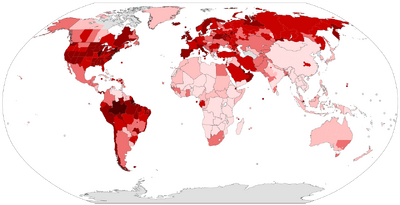
Despite the terror and barbarity of the Vector outbreaks, they were largely contained within designated zones, due mostly in thanks to the preparation afforded to the world during the 2020–2024 coronavirus pandemic (pictured: COVID-19 map, c. June 2020).
Although only a fraction the virulence of the early-2020's SARS-CoV-19, the weaponizing of the infamous O. unilateralis (often incorrectly referred to as "Cordyceps" or "Zombie fungus" due to its association with a popular video-game series dramatizing a zombie apocalypse caused by the disease) was a guaranteed 100% mortality-rate (with rumors circulating as early as November 2027, when the first recorded attack occurred in Ostrava and other cities in Eastern Europe, that someone survived coming into contact with the disease). Following the globally-televised and ceaselessly-covered 11-7-27 attacks in the Czech Republic, Slovakia and Ukraine - and thereafter outbreaks and regional epidemics surging in the Spring and Fall of 2028 and 2029 respectively - the initial hostilities borne following the previous virus crisis would largely begin to wane as the nightmare reality of an impending bio-terrorism crisis began to grip the world in its clutches.
2028[]
January – The Black Thirteen, an anti-neural agent created from the mutation of the O. unilateralis by nanotechnology, is discovered to be the weapon of choice utilized by the bioterrorists. Seeing how they attack European states in late 2027 at first, it is suspected they work for the United States by NATO and the Pact…that is until they attack the Western United States. It is confirmed they are neither Islamic terrorists nor are they Ultranationalist extremists from any one country. What elicits further confusion is the advanced power armor and weaponry they utilize. The prime suspicion for the funding and support of the bioterrorists then shifts to international organizations such as NATO. After bioterrorist attacks on Salt Lake City, Vancouver, Seattle, Dallas and Los Angeles, all implications of US or IF involvement in the bioterrorism is swept aside, and nations all across the world begin to set their sights on Interpol and NATO – or, eventually, even a false-flag inside job operation by Middle America against its resident civilian population.
June – For six months Europe struggles against the vector threat. The Pact deploys a reserve force of 3,771 MAWS to combat the rapidly spreading bio-weapons. They succeed in pushing the threat back out of Eastern Europe and into the Southeastern/Balkans region by late June. Earlier in the month, although the American public take up arms against the infected back in February, in the end the entire continent west of the Mississippi River is quarantined, the major points of the Red Line established by US forces in western Chicago and Memphis TN. San Francisco quarantines the city limits and establishes a ‘Fortress Francisco’ policy put forth by the city’s Mayor and the Governor of California both. Officials note that a smaller infestation occurred in Mountain City in Eastern TN, which resulted in the town being quarantined. Although the culprits were not then known, with recent developments it becomes clear that the source of the weapon was borne in Oak Ridge, a few short miles north of Knoxville. By July 2027 over half-a-million people in the United States and Middle America alone have fallen victim to the contagion, with that number approaching approximately 1.8 million worldwide.
Japan vs. Russia[]
- See: Tibetan Uprising & Vector Crisis of East Asia (February – August [2027-2029])
2027-29[]
February – On February 15th the insurgents launch several more attacks in East Asia – Vladivostok, Hong Kong, Ho Chi Minh City, Petropavlovsk, Seoul, Pyongyang, Singapore, Vladivostok, Osaka, Manila, Quezon City, Hat Yai, Nakhon Si Thammarat, Phuket, Kuala Lumpur and Bangkok – in 16 cities in Russia, Vietnam, Thailand, Malaysia, Korea and the Philippines. Twelve hours later over 3,780 sightings have occurred and over 960 confrontations involving the viral vectors have been reported. At least 7,791 deaths occur within nine hours of the attacks, and continue to escalate by an average of 2.4 deaths an hour, with another 0.6 death increase in escalation at a roughly 50% chance of said growth and nearly 0% chance of any visible implosion every ten hours that went by. Chinese authorities manage to attain a pyrrhic victory against the vectors – with approximately 90% of the territory of Jiangsu Province, along with the 11 other surrounding provinces reporting viral presence and Q-Zone status, under hostile occupation – yet manage to evacuate most of the civilian populace, while Singapore manages to drive the infected out of the city-state and quarantine the city limits by the morning of the 21st. Other cities that manage to survive are Vladivostok (which, although a protracted campaign, manage to use the coastline and harbors as an effective brace against the encroaching hordes, allowing them to perform a tactical piston to rebound against the enemy), Ho Chi Minh City (using their home field advantage they eliminate the infected and push them back into China within twelve hours, before they can pose an adequate threat), Seoul (by the 16th), Osaka (manage to quarantine the infection within the south district by the 17th) and Manila (by the 16th). However, Shanghai, Petropavlovsk, Pyongyang and Quezon City are flattened by the infection – the result is the complete infection of the northern Philippines, viral occupation of Far-East Russia, the infection of East China, regions of Southern and Central China, North Korea, and the entirety of the Malay Peninsula by February of next year. The most devastating events of the Vector Crisis occur in East China – Shanghai, during the Bund Nightmare: 586,383 people die within six hours at the hands of the bloodthirsty viral weapons – and the Malay Peninsula, during the “KL (Kuala Lumpur) Purge”, in which 326,225 die by infection and another 55,664 die from firing squads and government police instructed to wipe-out the infected areas of “cryptids” left behind during the evacuation. A combined 968,272 perish in the Vector Crisis of East Asia, with Shanghai and the Malay Peninsula regarded as the preeminent epicenters of the entire Crisis by many historians – with more people dying in the Bund Nightmare and the Kuala Lumpur Purge than in the entirety of the rest of the International Vector Crisis as a whole.
August – During the Vector Crisis of East Asia, Korea and the Regional Forces Group come upon the realization that Japan's, and the rest of the region’s, intense focus on the containment and pacification of the bioterrorist threat lends it the perfect opportunity to trample Japan and occupy the island, to exact revenge upon the Pro-American country that attacked them several years earlier. Russia invades and occupies more of Hokkaido with its full eastern force of a million of soldiers, thousands of aircraft and dozens of naval vessels including fifty battlecruisers and a supercarrier. What Russia forgets is Japan's MAW complement of still-over 9 MAWS (4 RONIN, 5 SHOGUN), which they had been actively upgrading and retrofitting with constantly-updating technology and consistently more advanced weaponry for the past two years, aided by Japan's industry and dormant 4 RONIN fleet in the south of the Korean-occupied Japanese archipelago adding to the Allied forces. Although China still had over 1,000 combat drones it could lend to Russia, they are outmatched both technologically and in raw firepower by Japan, and cannot adequately aid them (Japan also largely dominated by Western political influence at this time). Korea withdraws from the conflict, drawing the ire of the Russians. The invasion is repulsed, miraculously, as Japan throws all 719,000 of its military personnel from the navy, ground forces and air forces against Russia's far more numerous – including South Korea's 3 “advanced walkers” – MAWS in ferocious resistance. Over 4 million Russians and nearly 40 million Japanese soldiers and paramilitary are killed in the fight against one another and Korea and RFG based there, including three quarters of their own MAW force, while the Japanese and Republican Koreans lose only a single MAW, even with the fabled “Gun Grizzley (Пистолет Гризли)” Command Walker (of which Russia claimed to have an entire army, yet only had two with one a secret), the Russian military fails where the SHOGUN fighters and their RONIN counterparts – the latter revered as the pinnacle of the manned Command Walkers to fight in the Third World War – succeed in repelling Russia's Chinese-backed second major offensive in the region in mere months.
China's Taiwan invasion is repulsed almost instantly by the heavy number of infected there, and shortly after the East repel the COSECTOR on August 20th anti-Communist Tibetan separatist movements begin to surge across the continent. With the Liberation Army already in a weathered state from their battering by the infected and Japan, they make the last mistake they should’ve made – poorly executed intelligence and a heated ‘shoot first ask questions later’ attitude. Delivering the exact same response they have given to every attempted uprising, what they do not expect is a tactical, guerrilla-style counterattack with carefully and patiently-executed strategic response by the Tibetan Insurrectionists. Several cells placed within the PLA and Communist Party and backed by Japan execute bombings against government structures in Shanghai, Beijing, and Tianjin – as well as PLA strongholds in Chengdu, Luoyang and Xuchang. This creates a domino effect resulting in the immediate elimination of most of the Communist Party and PLA command structure, throwing the Chinese armed forces into disarray and giving the Tibetan opposition the tactical superiority for the duration of the confrontation. Sympathetic Anticommunist movements gain footholds in each of the seven military regions, as well as the North and East of India, arising from opposition to the pro-Korean and Indian Communist Party from within the PLA as well as the Indian Armed Forces. Throughout the rest of the year, into the next, and the beginning of the year after that, the Communists slowly lose their grip on Beijing and China as a whole. Shortly thereafter India, Japan, Taiwan and Free China launch an all-out assault on Beijing, capturing it and politically liberating China from Korea no more than 48 hours later. China effectively surrenders, with the Supreme Leader declaring war on India, although a series of quasi-terrorist militant guerilla movements would continue to wage asymmetric warfare for decades after the ostensible collapse of the Kim regime.
2028-2029– Despite Tibet’s ostensible political victory, the Communists – led by the imperialist and hypernationalist New People's Liberation Army (NPLA) – via Russian support hold out for several more years within the walls of the Forbidden City as the de facto headquarters of a Chinese-led Security Council dominion. Field Marshal Xi attempts open totalitarian rule over the United Nations – the Security Council that includes Britain, France, India and the United States of America – and by extension, ruling the known world. By 2027 the IF led by Tibet is able to mount a successful assault on the Palace of Heavenly Purity and capture Marshal Fang, destroying a hidden second Gun Dragon in the process, thus ending the incessant hostilities fomenting within Beijing over the last year. Shortly after this, Tibet's allies in India are aided by France, Japan, the Americans, Arab League and United Kingdom in an Invasion of Himachal Pradesh. Before Allied forces can make it to Lahore and Faisalabad, the Pakistani nuclear bombardment cripples India via Kashmir - but takes the near-1,000,000-strong invasion force with it.
NATO–UN Invasion of Israel[]
- See: Tel Aviv Campaign, Manhattan Campaign, UN–Turkish Invasion of Haifa & Israel–UN relations
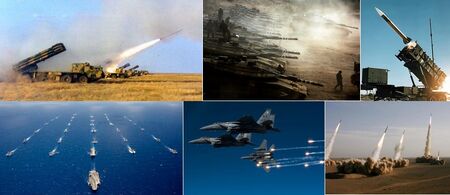
Israeli ground and missile defenses mobilize against the Turkish-led intervention into Haifa and Northwestern Israel by air and by sea.
2026/27-2027/28[]
NATO Invasion of Israel[]
It wasn’t long after the fall of Red China that the nations of Eastern Asia were able to mount a united offensive against the B13. By September 6th the East Asian Outbreak was slowed and pacified, with a few stragglers here and there in remote regions. Europe, although still struggling against the shadows of North America and England, was able to keep the infestation contained in the West Balkans of Southeastern Europe, and after the fall of the extremist governments in Saudi Arabia and Lebanon (on opposing sides of the ongoing War); Israel, Jordan, Iraq and Iran are able to mount a successful offensive against the infection in the Palestinian and Anbar regions of the Middle-East. A rampant vector crisis in Riyadh had spread to outlying regions by this time, however, and Saudi military elements were forced to focus attention inward.
Meanwhile, the mainland United States was still struggling against the rampant hordes. While Memphis, Chicago and San Francisco held steadfast, the US had not experienced a moment’s reprieve long enough to formulate a unified offense strategy. The NATO Secretary-General, George W. Bush, is discovered to be working secretly with English Chancellor Pharaoh who had effectively taken control of Europe. Now, the final show down was imminent, as Belgian and NATO forces prepare to intervene militarily in Israel – and choke what they claim to be the last lifeline being fed into the economically-implosive regime in England.
Or so they would have us believe.
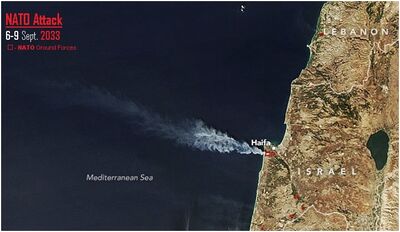
During the infestation and before an effective quarantine procedure could take place, the rogue Netanyahu government in Jerusalem is forced to vacate, and it is during this time that a Centrist-Muslim coalition government is erected and democracy and equality is reclaimed between Israeli Jews and Israeli Arabs for the first time in nearly a century. Despite this, NATO – primarily backed by Belgium and the Spanish-led MLF-II (Multinational Land Force-II), and Nordic EU battle-groups, and spearheaded by the Norwegian "FSK" - Forsvarets Spesialkommando - and Danish "Hunter Corps" – launches an attempted occupation of Haifa, intent on claiming Israel regardless of who or what was in power, with Turkey temporarily aligning themselves with their more recent foes against a far older one.
Although the West would initially be steadfast and united in response to the 2023 Hamas attacks on Israel - which would leave more than 1,400 dead Israelis - the Israeli response in October would draw condemnation from EU and Norwegian officials. France, Spain, Portugal, Ireland, Belgium, Luxembourg, Norway, Denmark and Turkey would begin plans for regime change in Israel when Netanyahu's "Unity" Government begins stoking sectarian tension within and between Israelis, further exposing the Israeli State to increasing instability and thus, the wider region. With Norway, Belgium, Turkey and Spain spearheading a lot of the condemnation of Israel's actions at home and in Gaza, a "Coalition of Necessity" would begin to form in late-2027 with Turkish-EU aid flotillas becoming a regularity by 2028. Several months later, the Turks, Norway and EU in conjunction with a 113-country Arab-ASEAN-Commonwealth coalition would launch an armed intervention into Israel.
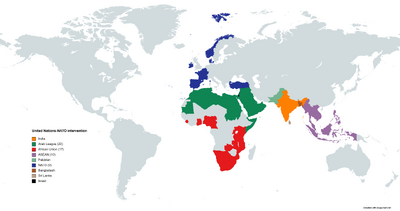
By the end of 2027, UN and Turkish forces would launch an intervention into Israel
In an unexpected reentry into WW3, U.S. MAW forces – spearheaded by RECON – come to the defense of Israel against the Belgian–Danish 113-nation UN invasion force. The Russians also commit a sizeable assist, and the NATO intervention is repulsed. In the process, however, Russian forces destroy several U.S. naval assets, including a submarine – while pro-Russian Israelis seize and occupy a U.S. Ford-class supercarrier. Backed by Russia, and reinvigorated with the possession of such a powerful military asset, the Russian-controlled Israeli military pledges to assist Russia and England in a revenge attack upon Europe and the United States of America, while the moderate Israeli government, forced into exile in Tel Aviv, pledges and reaffirms its commitment to the United States, and a Civil War between the pro-Russian and pro-American factions within Israel erupts across southern and western Israel.
Arab–Israeli invasion of Turkey[]
Following the 2027 attacks on Turkey and subsequent Turkish invasions of Syria and Lebanon, the Arab League with its massive land force and navy begins planning for a full-scale invasion of Turkey. After a meeting of monarchs and heads of state from Egypt, the UAE, Algeria, Morocco, Iraq, Jordan, Syria, Bahrain, Qatar, Oman, Libya, Bahrain and Israel, a coalition of Arab and Israeli armies is formed and soon after launch attacks on Adana and Antalya in Southwestern Turkey. The Arab–Israeli naval force quickly overpowers the navy of Turkey, although a concurrent Arab–Israeli invasion of Cyprus inflames tension with the European Union and Greece as well, which send aid and reinforcements to the Turks. In a conflict that would last roughly a month, the Arabs and Israelis raze the southern coastline of Turkey and the island of Cyprus, in a confrontation that claims the lives of over 70,000. Roughly 40,000 Arabs and 7,000 Israelis would also perish.
NATO forces would lose over 50,000 as soldiers from Spain, France, Belgium, the Netherlands, Luxembourg, Norway, Denmark, Poland, Romania and Croatia convened toward the cities under attack from the Arabs and Israelis. Even after the invaders pulled back and ceased their operations, soldiers from over half a dozen countries would continue fighting in Southern Turkey for several months after the fact. A frozen conflict zone began to emerge along Turkey's southwestern coastline and on the island of Cyprus. The new Arab and Israeli governments that would take over from their preceding theocratic regimes would enact a strict sanctioning and censorship of the rogue Arab forces that would continue to launch attacks in the two cities, heavily entrenched with support from China in the surrounding hinterlands. After several decades, the paramilitary forces officially surrender, although sporadic attacks would continue from the remaining few hundred fighters for another few decades later.
English Invasion of New York City[]
Beginning in mid-September, bombings in Queens, Newark and the Brooklyn neighborhoods of Sunset Park and 8th Avenue by the independent Jihadists in control of the supercarrier preamble a subsequent invasion by England of the Eastern Seaboard of Manhattan, New York. Isolated skirmishes unfold in Jersey City and parts of Newark and its outskirts in late September, November, and throughout the Summer of the following year, respectively. The first tally on the mission parameters is the occupation and lockdown of the financial district, particularly Wall St. The invasion is precipitated by precision missile strikes against the MMB, Empire State Building (to disrupt nationwide broadcasting), 432 Park Ave. (used as partial residence for U.S. infantrymen), 70 Pine St., the Woolworth Building, the Tishman-Speyer Building, Metropolitan Museum of Art, Grand Central, NYC Transit, One Liberty Plaza, Ft. Hamilton, NYPD, and the Statue of Liberty over the course of roughly 15 minutes (NYPD, Ft. Hamilton, the Statue of Liberty, 432 Park Ave., MMB and the Empire State Building are all destroyed simultaneously). In addition to these preliminary strikes, residential buildings suspect of housing Middle American and US infantry in preparation for the invasion of the United States and England respectively – 1717 Broadway, Liberty Tower, Barclay Tower, Biltmore Tower, CitySpire Center, The Corinthian, The Eldorado, The Epic, Madison Green, Metropolitan Tower, Battery Park’s Millennium Point and Millennium Tower – are destroyed. Although the 200,000-strong mobilization was – tactfully – spread out primarily in as many low-lying residential structures as possible, the leveling of New York’s residential skyscrapers still took out a rather large chunk of the total invasion force; 57,000 soldiers and over 100,000 civilians are killed.
Manhattan Campaign[]
(October 2028–July 2029) – English forces manage to maintain a foothold in the Upper East Side throughout the entirety of the campaign. Within a month, however, U.S. forces had managed to secure the United Nations building and surrounding neighborhoods of English forces. The very next month, U.S. and RECON forces launch a joint operation to reclaim the supercarrier from the English and jihadists. They do so successfully, immediately turning the vessel on the other twenty-odd vessels in New Jersey waters, pounding them throughout January and February. By March English ground forces are surrounded, but manage to hold out for another three months before surrendering (although the Verdean-controlled dreadnought battlecruiser returns briefly in April to attempt a rescue).
Throughout the rest of June, English deserters and guerrillas commit blitzkrieg-style attacks on U.S. forces patrolling the New Jersey–New York border and throughout Jersey City. By early July the skirmishers have been pushed out of Jersey City and into Newark and surrounding neighborhoods, and within a week the remaining 100-odd belligerents have all either been captured or killed.
Balkan–UN Siege of San Francisco[]
- See: Siege of San Francisco, Battle of Chicago, Vector Pacification of Mainland US, Russian–Korean Invasion of Anchorage & Battle of San Francisco (May – July 2028)
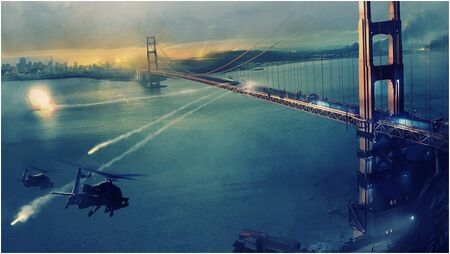
Jordanian attack helicopters exchange missiles with RECON Unit 1-11 on the Golden Gate Bridge, c. 2028
May – Throughout May Japanese Shogun-Two MAW formations, led by one of the only three LONGBOW fighters in existence, lend crushing assistance to the ailing American resistance against the vector hordes. In response to the alarming developments in Manhattan, the second-largest MAW squadron on Earth is sent to Western America to take some of the pressure off of them by giving them an outstanding head start through “laser-carpet-bombings”, weapons systems the Koreans designed specifically to target and destroy nanotechnology (i.e., hapless victims of the Black Thirteen nano-virus), with one bombing run resulting in the destruction of thousands to tens of thousands of infected in one fell swoop. This gives the resistance enough of a window to conduct National Guard and United Militia clean-up exercises orchestrated to deliver the maximum effective response to the question of how to get rid of the infestation as quickly and wholly as possible. In the same month, a military coup led by General Valyn Zharkov seizes control of Moscow and executes Russian President Medvedev. The government under Zharkov is much more overtly ultranationalist and fascistic than Medvedev’s Russia. A Second Russian Civil War ensues until the early 2030's between forces loyal to Zharkov and those loyal to Medvedev and the late Vladimir Putin.
June – With the bombing runs concluded by May 21st, the devectification of the western mainland begins immediately afterwards. The ANG and North America divide the Western US up into 3 zones denoted by their proximity to whichever of the three central nuclei of the Antivector Resistance Movement (ARM) they happened to be – Chicago, Memphis or San Francisco. Although they had a lot of area to cover, this was their sole challenge in mopping up what little 1% of the initial vectors remained behind after the devastating anticryptid bombing measures undertaken by the Shogun-Twos, and the sole reason it takes ARM from May 22nd up until June 29th to reduce the vector threat level from yellow to green. The main reason ARM has to cease prioritizing of the antivector countermeasures is the Chinese–Balkan invasion of San Francisco on June 30th.
July – On the morning of June 30th NORAD orders a no-fly zone over California after alerting residents to the presence of an over 4,100-vessel UN fleet, spearheaded by nearly the entire 1,743-vessel-strong North Korean-spearheaded combined Korean–Southeast Asian Fleet and Air Force, supported by the entire Unified Korean Air Force and an Arab–Indian Air Force sitting just beyond eyeshot of the American West Coast. A citywide evacuation of San Francisco is underway by 7 AM, with RECON diplomatic assets inserted beforehand to coordinate and supervise – but it is too little too late. Oakland and Berkeley are quickly overrun, particularly due to their weakened state in the wake of the Outbreak. Fisherman’s Wharf is the first area of the city to fall under UN bombardment. It isn’t until roughly an hour later, after the destruction of the westernmost suburban region of the City, the US forces discover this is a diversion. About 47 minutes into the attack Serbian CAJ, Bosnian Serb SJP, Indian MARCOS, Pakistani SSG, North Korean KPASOF, Chinese Snow Leopard Commandos and Turkmen Edermen deploy under the UN flag into and occupy Point Vista. With nearly 30,000 soldiers deployed from nearly 100 countries across three continents, UNMINA would surpass all but UNIMIL in Israel in its size and geographical scope to become the second-largest United Nations mission in the history of the organization. The invading forces were divided into five groups, the Arab–Indian-led African and South Asian countries, the Brazilian-spearheaded Latin Americans, the Indonesian–Thai spearheaded ASEAN, North Korea and China. Also assisting was a sixth group composed of pro-Russian Serbs from the Serb Republic of Bosnia and Herzegovina and Serbia that operated against the United States for reasons that diverged from the UN intervention to return California to U.S. jurisdiction. Their involvement, however, would solidify the U.S. government's opposition to this intervention.

Second only to the UN Mission in the Levant, nearly 30,000 soldiers from 100 nations would descend upon San Francisco in mid-2028
With all of the available US military assets focused on western SF, Balkan Units and Commando forces quickly shut down any possible land-based assistance to US infantry via occupation of Point Vista and the Golden Gate Bridge. AA emplacements are quickly erected in Western SF and the Marina District, sealing out any available air-based reinforcements with Multiple-Launch Propulsion Systems, Artillery and advanced laser-based AA systems. The CAJ occupation of mainland San Francisco proceeds with perennial bombing runs up and down Market Street, and an infantry-based shut down of Union Square, the Tenderloin District, Haight-Ashbury, The Castro and Financial Districts in that order. When US forces dugout on Lower Market, Upper Mission and parts of the Financial District prove to be a greater resistance force than the SAT anticipate, artillery batteries erected on Alcatraz, in Oakland and Berkeley preeminent to the main assault ruthlessly bombard the aforementioned municipal regions. It is at around this point in time that NATO and RECON – in response to the pinned-down US forces in mainland San Francisco – deploy behind enemy lines in Point Vista to retake the North Korean–Turkic shutdown of the Golden Gate and neutralize hostile artillery. This endeavor, due to its extremely covert nature, catches the enemy by surprise and is a sweeping success for IF forces. Throughout the rest of the night, until the sun rises on the new day – July 1st – US forces remain on the defense. Due to the intense fighting in West Africa and the Middle-East, IF and NATO forces are hard-pressed to strategically allocate armed forces as tenderly and carefully as possible, and by 7 AM on July 1st, although US forces have suffered immense casualties, armored and airborne reinforcements arrive to deliver a crippling blow to Chilean ground and naval assets. RECON assists in the evacuation and defense of Homeless Youths shelters from Serb–Korean belligerents and RECON air support assists in the process. District-by-district, RECON, NATO and IF forces shut out the Korean and Turkic forces. The supreme commander of the rogue Italians present during the Siege of San Francisco, Luciano De Luca, the twin brother of Francesco De Luca – and his right-hand man, the Hungarian-Romanian General Dragomir Radu, make an attempt to escape from the war-zone, but Luca is eventually tracked down and taken in for interrogation by RECON-Unit 1-11. The Siege lasts for another two weeks but is reduced mainly to a war of attrition. During the interrogation of Luciano De Luca, Unit 111 discovers that the attack on California was just a small part of a much larger plan involving all of the Pact and Interpol and even the enigmatic ‘Shadow Hub’, the terrorist organization responsible for these ‘Shadow Police’ bioterrorist attacks. The first step of the master plan to bring the mighty United States to its knees was a covert Russian-Korean invasion of Alaska with help from Interpol and this mysterious ‘Shadow’ organization.
July 1st – RECON meets with NATO forces in Anchorage an hour after discovering this revelation from De Luca. Sure enough, Russian-speaking men in uniform are spotted on the town’s outskirts. Covert and stealth operations are launched against these Axis ‘observation cells.’ The anti-insurgency operations are a massive success for RECON and NATO forces. After the debriefing at the RECON base a few miles outside of town, NATO and the civilian staff at the base is discovered to have been infiltrated by pro-Interpol Russia and NSA moles. A bitter struggle erupts, after Russian and Peacekeeper forces reveal themselves within the very interior of the RECON HQ, to secure the base. It is here that the most devastating confrontation between RECON and viral hostiles unfolds. Eventually, the only solution becomes evident – evacuate and nuke the site from orbit. Capturing a smuggled Russian nuclear warhead, RECON and NATO forces evacuate – but not before losing 3 quarters of their initial forces. The base is destroyed, along with the zombic threat. As they are arriving back in the mainland United States, RECON receives word from Shield Team that the bioterrorists have arrived in Chicago with power armor reminiscent of the IF-based "Menace” armor systems, only much more advanced. With their own men in the center of the battle zone, RECON changes course and they then head for Chicago.
Apocalypse Cancelled[]
- See: The Vector Crisis, Eugenics, Bioterrorism, Vector Pacification of Mainland US, Operation STARMAN & Vector Pacification (July 2027)
Outbreak and pandemic bio-terrorism[]
What would become known as the Vector War, also referred to just as frequently as the Vector Crisis or Vector Outbreak, would last for two-and-a-half years – from November 2027 until July 2030 – and would be the most terrifying part of the Third Global Confrontation for many. In July of 2027 it is discovered, through RECON moles in the CIA and Intelligence State, of information they had been hiding from RECON, the US, and humanity as a whole. An organization known only as the Shadow Hub, a secret society behind the CIA Shadow Committee and Britain’s GCHQ and SIS, as well as the power behind the Saudi Throne, Wall Street and the Bilderberg elites – operating from secret underground bases all across the planet – were the people the mysterious bioterrorist ‘Shadow Police’ represented. Not Islamic extremists or Communists this time around, but something even more difficult to extinguish than an ideal, but a mindless, violent force against all nations on Earth. The Shadow Hub represented the first ‘Anti-Nation’, and was a far greater threat than any one nation, any one terrorist organization, or any army with numbers of untold and unknown millions throughout Earth, and state of the art technology and bio-weapons. Obtaining a monopoly on the G13 and B13 weapons, they did not need MAWS, they did not need nukes, they didn’t even need to stake territory – all they needed was to destroy it. And that was their single-minded single greatest and most sought-after objective – to destroy all nations.
Unfortunately for them, their plan at destabilizing the world indirectly by loosing a potentially apocalypse-scale biological weapon in key cities of the world’s most powerful region had been slowed about 10 months later, and by the time nearly 2 years had elapsed the Outbreak had been contained to small and concise quarantine zones in the aforementioned cities. The Shadow Hub had been thwarted… and angered. Could they be thwarted again? Their program of long-term Eugenics had not yet been thwarted, but it was under attack with their exposure by Omega Response. The Omegas believed in being the last line of defense against a Scorched Earth policy, which the Shadows represented as the penultimate manifestation thereof.
Although nobody would believe them, certain elements within RECON claimed evidence had been found that implicated the SH in a vast thought-control conspiracy dating as far back as the Dark Ages, possibly even to the time of Roman domination of Europe and Asia and the Egyptian Pharaohs – of course back then they would have gone by a different name, but still been complicit in their agenda to enslave humanity. Fewer still thought evidence pointed to the SH making contact with another dimension through secret science programs – namely a dual program in Oak Ridge, TN and Flatwoods, WV. It was believed to be called Operation STARMAN. Only Unit 1-11 would come into contact with this revelation directly. Although the details are classified, it is believed to be connected to some of the more terrifying cryptid sightings, such as the Mothman, Flatwoods Monster, the Native-American mythical beast known as the Wendigo and the infamous and terrifying Jersey Devil - all connected to experiments into the human and animal psyche and its relationship to spacetime itself.
The Outbreak and indicative Apocalypse had been thwarted – but it had done its damage. Nearly 2,000,000 (584,317 in North America and the U.S., and 210,111 in Eastern Europe), were robbed of their humanity, and their life, by the time it was said and done – with roughly 50% of the casualties in the cities of Kuala Lumpur and surrounding areas, and the Chinese city of Shanghai alone.
The Shadow War[]
- See: Shadow Government, Battle of Chicago, Super-Fungus, Nanobot Virus, Fall of Kiev & Shadow Heavy (October 2027 – July 2028)
October 2028/29[]
In October of 2028, shortly before the contagion became a major issue, it became common knowledge that the forces seemingly seen as separate regional entities formed for different purposes were in fact part of a stealth expansion by forces responsible for the rise of Hitler and the Nazis, that shared their views of European – and eventually global – domination. These entities in question are none other than the EU, NATO, Interpol and Bank for International Settlements. Through the latter, which had passed into Nazi hands during WWII (along with Interpol), they controlled the World Bank, World Trade Organization, and International Monetary Fund. Connecting these entities together into a singular machine for world domination and perpetuating centrist totalitarianism and populism across the world were the power elite – the Kings and Queens of Europe, the Saudi Royals, the CEOS and Chairmen of multi-national mega-corporations, former and currently-serving politicians and heads of state, including North Korean official Yun Ho-jin and Chancellor Pharaoh – who had initiated a permanent convention in a secluded underground base in the Appalachian foothills as opposed to the annually-rotating meetings between various cities. This time they had enlisted the presence of the Interpol and NATO heads, as well as the presence of Pharaoh and the Transylvanian Supreme Commander, Dragomir Radu himself.
November - January[]
Throughout the duration of this active ‘Shadow Hub’ (unofficial name; "Shadow Heavy"), the terrorist activities of the Shadow Police became more frequent and more direct. The first direct attack occurs on November 20th, in Bethlehem. Using high-impact EMP’s, advanced laser-guided artillery and directed-energy weaponry (and of course their state-of-the-art power armor), the insurgents shut down Israeli and IF fortifications in the city almost instantaneously. The defenders have to resort to guerrilla tactics and makeshift ‘blitzkriegs’ to push back the vastly-outnumbered yet ordinance-heavy belligerents. The second occurs 3 days later, in London. The Shadow insurgency bombs British and SAS airbases and fortresses utilizing low-altitude high-impact surface-to-air ballistic missiles (HSBMs) deployed from hidden facilities beneath the city. Big Ben is also destroyed by an HSBM and Buckingham Palace is partially damaged. The attack takes the Royal Armed Forces by sweeping surprise and – although vastly superior in numbers – proceed to fight an uphill battle against the insurgency. In addition to being blindsided, the insurgents also plant moles within the British command substructure and the active armed forces, further complicating their resistance efforts. While the entirety of the British loyalists throw their weight and brace back against the invaders in a last stand at Downing St, the Russians see this as a perfect opportunity to take down the Island of Great Britain once and for all – and they would have, had it not been for an identical insurgency launched against Moscow mere hours later. Throughout the rest of the month and into January, the British and Russia brace against the ostensibly interminable attacks and tricks utilized by the insurgents, including a seemingly endless supply of drone weapons and advanced technology, until finally the illusive belligerents fall back and leave the respective victim cities in ruins, vulnerable to one another and ripe for renewed warfare and bloodshed, on January the 17th.
February - April[]
The next, perhaps most devastating, attack occurred on February 11th, 2029. Utilizing HSBMs loaded with raw nanobots jury-rigged by the insurgents from the original B13, only without the fungus medium used to transform its victims into walking weapons, simultaneous attacks are launched in Paris, Barcelona, Geneva, Madrid, St. Petersburg FL, Russian St. Petersburg, Bangor, Phoenix, Houston, El Paso, Little Rock and Memphis. Instead of creating vectors (or "zombics", like its fungal medium would’ve done) it merely destroyed the nervous and immune systems, replacing them with volatile chemicals created from the rapidly-replicating nanobots that transformed the hosts into ticking and walking time-bombs. They would explode and the chemical would cause a chain-reaction rippling domino-effect. So if 10 people died, 100 people died, and then, if it wasn’t contained quickly enough, as many as 10,000 could die. Civilian and military alike were targets, and within 24 hours of the attack, all 12 cities had been shut down and occupied by the insurgents. In an unlikely twist of fate, however, Russian–led forces deploy with a fresh batch of MAWS and wreak havoc upon the assailants, with assistance from NATO. They hold out longer than expected, with the stragglers not being pushed from the last city (St. Petersburg in Russia) until April 16th.
May - June[]
Unfortunately, the presence of Russian and NATO MAWS in Florida only encourages Pact forces to begin planning a joint-invasion and occupation of the United States, which leads to the Manhattan Attacks in June and the Siege of San Francisco later that month. When officials in Moscow refuse to withdraw the killer robots, and NATO officials in Brussels likewise refuse to do the same, the United States, United Kingdom, Japan and the entire Independence bloc recall the entirety of their armed forces and put them on high-alert with possible orders to nuke Moscow off the map or, even worse, launch their own MAW force into the aforementioned regions. It isn’t soon after that the opposing forces leave the United States. Although this immediate crisis is ostensibly averted, more issues arise later on.
July – The Third Global Conflict begins to get really nasty after Pact forces begin to become desperate. The terrorist attack in Moscow sparks a chain reaction after the destruction is contained. Shortly thereafter, the insurgents launch their biggest assaults yet. Moscow and Chicago – utilizing over 100,000 Shadow Police apiece – are shut-down by the insurgents in under 2 hours. Amid the chaos, Ukrainian Vyshchyy Artemenko is overthrown and executed in the streets. Meanwhile, the Battle of Chicago marks one of the most intense battles the American home land will ever see.
Battle of Chicago[]
When RECON arrives the insurgents had already shut down half of the city and US military were fighting a losing battle. Leading up to the battle, throughout the day – July 1st – the US military began arriving in the neighborhoods between O’Hare and Bucktown, and then from there to The Loop, and from there again all the way down to Chinatown. What NORAD had been warning Chicago local law enforcement, counterterrorism and military forces against was a possible amphibious assault from Lake Michigan, consisting of consecutive strikes on The Loop, Prairie District and Chinatown, as well as a possible attack in Douglas, Streeterville, the Gold Coast, Bucktown and Lincoln Park. What intelligence authorities did not know (or purposely withheld) was that SH forces had hijacked a plane inbound for O’Hare International Airport and the staff therein were completely unaware.
The plane lands successfully and by this time the 62 insurgents had forcibly purged the crew and passengers from Flight 187, and another 56 had done the same on Flight 292. The two planes landed successfully at O’Hare terminals, and within minutes the concourses had been bombed and the airport shut down. The US rapid-reaction team of approximately 210 soldiers on sight in O’Hare responded immediately, fully engaged in a firefight to liberate the airfield less than 10 minutes later. A third bomb is located and successfully diffused, a warhead with the capacity to take out the entire northwestern portion of the city. About 5 minutes after O’Hare is secured, laser-guided bombardments precipitate upon Lincoln Park, The Loop, West Loop, Gold Coast, Streeterville, New Eastside, and every neighborhood along the Lakeside between China Town and Hyde Park faces an invasion of between 1,500 and 9,800 troops depending on area size. With over 110,700 soldiers, the 36,296-strong (36,330 before the O’Hare Attacks) US defenses do not look to be facing very favorable circumstances by the beginning of the next hour. The heaviest concentration of fighting occurs in West Loop, Loop, and Lincoln Park. A heavy fortification of 750 US Marines in Printer’s Row establishes a bulwark against a force of about 1,000 Shadow troops, locking down all entries into the district with over 100 tanks and armored vehicles. This is disproportionate to the total number of about 600 armored vehicles present during the battle – leaving only about 482 to be distributed amongst the Loop, West Loop, Lincoln Park and Gold Coast, with possibly some extras for single-use in Streeterville, New Eastside, South Loop and the Prairie District if they’re lucky. The subsequent turn of events prove they are not.
By about 6:30 PM, the Marines had successfully locked down West Loop, United Center Park, Noble Square, East Village and Wicker Park. However, virtually the entire city center – The Loop, Streeterville, New Eastside and Lincoln Park (as well as questionable reconnaissance activities by insurgents in Bucktown) – remained embroiled in ostensibly ceaseless fighting. Although by between 7:15 and 8:00 the U.S. forces had whittled away the invasion force by about 15,000 soldiers, they had on the downside lost around 6,000 themselves, with the death toll rising. By 7:30 the defenders had erected a bulwark in the southeastern end of The Loop, aided by the victors from Printer’s Row and survivors from the Prairie-South Loop region. Around 5,500 Marines stamp out a forward-assault base with most of the heavy weaponry and armor positioned in a strategic line running the entirety of Wells St. and flanking off about 550 ft. down Lake St. to the north and Van Buren to the south. The rest of Lake St. consisted of spare munitions, equipment and a makeshift armory, allowing the Marines to quickly brake ranks, grab a refill, and return to Wells in the event of an attack (asymmetric skirmishes were occurring roughly every 15-20 minutes at this point, mostly unmanned recon drones but occasionally a strike team of insurgents would launch an attack). Wabash Ave., at least three-quarters of the way down, was part of a makeshift command post, with the central headquarters set up at the John C. Kluczynski Federal Building on S. Dearborn St. occupying 26 of the 42 floors. The remainders of Wabash and Van Buren, and several abandoned buildings and complexes located therein and around the State St. area were converted into a makeshift hospital for wounded soldiers and refugees. At around 10:15 the SH launch a full-on assault, with artillery and a grenadier battalion of 1,000 positioned on the CTA rail taking the brunt of the blow. The front changes multiple times throughout the hour, with Allied forces at one point being pushed all the way into the park, but eventually the defenders manage to push the enemy out to Wacker, and after another hour of intense fighting – RECON arrives. With RECON assistance, the Allies manage to push insurgent forces across the bridge to Canal St. It is at this point the SH launch their final, most desperate and most dangerous biological warfare attack yet…
At 11:38 AM, Chicago falls victim to 18 consecutive B13 attacks in the 18 formerly-most populous districts. By this point the entire city had been evacuated, by 9:48 to be exact. The damage is done, however, the attacks proving brutally effective against US forces. They don’t stand a chance as their forces are dissolved from the inside-out by the virus. Now facing a two-pronged assault, Shadow Police on one side and zombic vector hordes on the other, the US forces realize they are going to lose. RECON gets as many out of the city as possible and prepares a contingency plan – hijack the Middle American nukes hidden beneath Chicago, activate them, target the city, and get the hell out. UNIT-7 does just this, penetrating into the underground facility, and evacuating via airlift.
The Battle of Chicago ends with the entire city and the infestation therein, being wiped out.
Orbital Superiority[]
- See: US “Independence” N.E.O.N. (Near-Earth-Orbiter Network) Platform, First Infantry Combat in Space, First Vehicular Combat in Space, & Raid on the US Independence (April – May 2029)
March – English Ultranationalists, fighting a protracted campaign again vying for control over Yorkshire in England since the beginning of hostilities over 5 years ago, launch their greatest incursion into the West Yorkshire Urban Area yet. Utilizing hundreds of tanks, thousands of Armor units, hundreds of aircraft, hundreds of artillery and rocket systems, and over 500,000 soldiers from England, the English Military launched a several-pronged attack into the area mainly focused in Leeds. Following a series of UDA suicide-bombings killing over 100,000 – English forces are met with equal resistance from NATO forces – 70% of which are composed of British, Ontarian, Quebecer, U.S. and Middle American Warfighters. Although the attack begins with a flourish – the English Defense is called back to London just mere days from completely taking the city of Leeds, in preparation for a new campaign and strategy – raising fear and suspicion in Edinburgh and Washington that the English and their Pact allies may be preparing for something even more devastating. NATO convenes in Holland for planning and counterterrorism operations against the UDA, possibly involving an invasion of London.
April – When English forces realized they may in fact lose the Manhattan Campaign, and were being pushed back, an effort to appropriate Special Weapons Assets from the United States and into Russian hands was put in motion. The US Independence Near-Earth-Orbiter Network, or NEON Platform, began construction in the early 2010’s beyond the eyes of the public, and was initially a preliminary emergency defense system designed to counter the possibility of Russian expansion beyond Ukraine (following Russia’s annexation of Crimea) and was still currently under construction but was ready-and-able to be used against targets. In late April, NATO collaborated with Russian forces to conduct a raid operation on the orbital facility. When a similar weapon – known as the DEMO – was used against a NATO military base in Scotland (effectively rendering the Northern Islands uninhabitable and resulting in the deaths of hundreds of thousands) on May 19th, 2029 – the Russian–English Joint-Special Operations Division (JSOD) began a campaign as early as 48 hours later to add the larger and stronger NEON to accompany the DEMO in the emerging COSECTOR Space Warfare Branch. RECON assembles their own space operation, the second in the history of warfare (after the NATO–Japanese operation to occupy the Independence), and deploys to the station in a captured Soyuz.
May 22nd – RECON UNIT-7 deployed onto Independence on May 22nd at 2:25 AM and was met with immediate resistance. The station was occupied by 27 Special Forces operatives – 19 Russians and 8 Englishmen – but managed to pull through and make it to the firing control center before the weapon was able to successfully fire on New York City and Long Island – its next target. Had UNIT-7 failed to prevent the Independence from firing – it would have leveled New York City and erased Long Island from the face of the Earth. This would have killed nearly 10 million people and plunged the world economy – and the world as it stood – into irreparable chaos, leaving a power vacuum previously held by North America and Europe, allowing Russia and England to seize absolute power. After Unit-7 succeeds, the orbital platform is deactivated, putting a wrench in their strategy. The Russia-Livonia and North American-led NATO forces, although having different methods and slightly different goals, had one thing in common: they wanted the Independence Front and the United States of America destroyed.
Brazilian–UN Invasion of the United States[]
- See: Brazilian–UN Invasion of Eastern US, Assault on Boston, Dutch–Norwegian occupation of Boston, Brazilian–UN occupation of Florida, Siege of Ft. Lauderdale, Occupation of Miami, & Brazilian–UN occupation of New England (June – December 2029)
Iraqi–Moroccan invasion of Spain[]
August – On July 30th the Arab League and straggling Union State forces utilize the full extent of their machine armies under cover of heavy Russian air and auxiliary support to launch an invasion of Central Europe and an occupation of Croatia, the Balkans and parts of North Africa respectively. The English are pushed back by NATO forces by mid-May - with France seizing on the infighting to join in on the battering, and the Balkan occupation is brought to an invasion followed by Poland and the Czech Republic in August and September respectively. In late August, a Hungarian-Russian assault force invades the Czech Republic, Croatia, Austria, the rest of Slovakia and parts of Poland, with the sole objective to work as much destruction and devastation in as little time as possible. With the Pact maintaining a firm stranglehold on Europe via the Balkans, Hungary and England, as well as parts of Northern France and Luxembourg after subsequent Russian-Livonian Invasions and attacks, and the conflict between the EU Benelux Battlegroup and COSECTOR thus reduced down from full-scale war to scattered, erratic skirmishes that consisted of mostly individual, isolated events… yet despite the French Army and Walloon paramilitary successfully holding the English-backed pro-Dutch Flemish insurgents - low-level proxy-conflict would continue between France and the remnants of English-Nordic secessionists, even for centuries after the virtual extinction of the countries of both England and Belgium.
Germany is not so lucky, with pro-Azeri Nordic militant insurgency persisting in the German states of Lower Saxony and North Rhine-Westphalia, with most of the fighting centered on the Siege of Cologne. Hesse is also briefly annexed by the Scandinavians, but is quickly retaken days later because of the small size of the occupation force. Either way, due to the Heer's stretched-thin multiple-front defense, the Secessionists, Dutch and Norwegians are able to mount a protracted offensive. Meanwhile, North Croatia along with Bosnia and Slovenia are able to hold off Serb assets and secessionists in the east, while North Macedonia wrenches free of جرثش control; and Greece and Bulgaria are able to defeat an Azeri-backed Russian attempt to push into their territory.
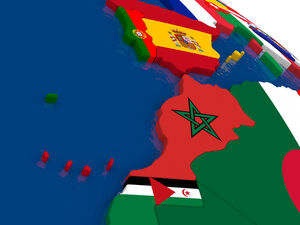
In the late-2020's, a series of escalating tensions eventually results in full-scale war between the Kingdoms of Morocco and Spain
As early as 2023, Spain and Morocco had begun feuding over Ceuta. These tensions escalated later that year, when Spain refuses to recognize Arabic as an official language in the city, and continued to escalate throughout 2024 and 2025. In 2027, riots broke out and fighting between Christians and Muslims. After roughly 90 people die in a riot in 2028, most of them Muslim, Morocco would intervene. Moroccan forces backed by the Iraqi Armed Forces, who had begun massing troops near the border over the course of the previous year, crossed the southern Ceuta-Morocco border to reestablish order. Riot police backed by the Moroccan and Iraqi military would violently suppress the riots, killing over 200 and injuring more than 7,000 others. Spain would itself collapse into disorder and crises during these years, as the government experienced a fierce tug-o-war between partisan factions, unionists and separatist regionalists that would reverberate throughout Spanish society for years. The monarchy is rejected in many corners of Spain, but maintains its rule over other parts of the country. The breakup of Spain is internationally unrecognized, although sporadic skirmishes do unfold between the various unrecognized polities. Later during the conflict, Portugal would become involved on the side of the secessionists, its government overthrown and hijacked by Moroccan imperialists. In total, roughly 10,000 would die on all sides.
However, despite the collapse of the Spanish Monarchy and Moscow, the strong core pillar of EU Resistance to the COSECTOR Assault on Europe emanating from Edinburgh and Stockholm, and the firm containment of the English insurgency on the southern peninsula of Great Britain - the Iberian Peninsula was cracking under the weight of the Neo-Imperialism engulfing the entire western coast of the landmass - Morocco had instigated a coup in Portugal several years ago by backing radical Monarchists in Lisbon which overthrew the government by instigating the military into an armed conflict against itself. And now, pro-Moroccan Portugal had not only annexed the Spanish state of Galicia, but also successfully backed the secession of the autonomous communities of the Basque Countries (including Navarre and a defeated attempt in Southwestern France), La Rioja, Cantabria, Asturias, Catalonia, Valencia and the Balearic Isles - the latter of the three would ironically unite against the Moroccan-backed insurgents to defeat them in the Battle of Aragon in September 2029, and would thereafter aid the newly-formed rump state of Andalusia-Castillo in its victory against Portugal in the Extremadura War of October 2029. In the backdrop of all of these conflicts the Brazilian-Arab MAWs prepared for a military operation the likes of which had never been seen before.

The state of the world in late 2028-early 2029, immediately following the CSO-NATO Invasion of America.
September – Over the span of roughly 46 hours between the end of August and beginning of September, realizing the Livonian and Russian governments were in chaos, RECON deploys Shield and Sword Agents on a plainclothes sting operation to take out the rogue Hungarian Commander that had eluded them so many times before – Dragomir Radu. He is located in Orșova, attempting to escape to Livonia through the Black Sea and Ukraine. Although most of the operation unfolds in the Retezat National Park, the final 13 hours of the operation involve a manhunt, which escalates in the last six hours into a chase and gunbattle at the Iron Gates. Before capturing Radu, the RECONS learned that he intended to kill himself to prevent an interrogation leading to the revelation of his manipulation of NATO and thwarting of his Europe designs. However, right as he is captured, he reveals that his plans have already been set in motion by his cohorts Lord Pharaoh and the late dictator of Russia, as well as Brazilian and Serb military brass and the Trumps – through pro-Pincers within the Hague – to blackmail the EU into a NATO-COSECTOR joint-invasion of the United States of America.
October – Between August and September 2029, NATO and COSECTOR, while still officially enemies, are appealed into a coalition spearheaded by Brazil, by the Communist-friendly North Americans under the prospect of replacing the United Nations with a “Bolshevik World State” that would end World War III and unite the planet and all of its nations under one flag. The North Americans claim, at the behest of Chinese Communist and Imperialist officials (including Fang) that sympathized with the Americas and the Russians, that the United States – the foremost power on the United Nations Security Council, must be coerced to capitulate to the new continental nation of North America. After Japan steps down from a brief tenure on the Council, the United States, France and Britain – as the Security Council Triumvirate – are effectively labeled the ‘singular mutual threat’ to both the East (Russia and Asia) and the West (NATO) and that the two rival civilizations must unite to ‘end the scourge of patriotism’ once and for all. On October 15th, 2029; the rogue Spanish militants fighting for Chile, followed by the entire NATO bloc of the England-led Atlantic Alliance (excluding France, Germany and Italy), Denmark’s Greenland taskforce and spearheaded by the Pharaoh Government (each faction intent on toppling the United States before the other), launch the most devastating attack in military history upon the United States of America. Like rain, the MAWS fell from the sky and attacked locations all along America’s Eastern Seaboard. At 7:43 AM Fort Lauderdale, Florida was attacked by a staggering 22 Egyptian-, Saudi-, Iraqi-, Brazilian-, Chinese-, North Korean- and even EU-aligned MAWS. IF forces deployed in an effort to stymie the assault, but since most of their MAWS had been destroyed during the European Conflict they had to – terrifyingly – resort to old-fashion military tactics to combat the mechanized monsters.
At 4:14 and 7:52 AM on October 16th, 14 Norwegian, Danish, Egyptian, Iraqi, Saudi and Brazilian MAWS deploy into Boston, Massachusetts and Virginia Beach in the Old Dominion supported by an invasion force of over 2 million spearheaded by Brazil, and 1 of the remaining 2 of Brazil's specialized ultra-heavy "Jaguar de Ferro" units accompany them. The French Navy – a powerhouse of a global naval power – almost single-handedly defeats the Brazilian–Arab Fleet whom they outmatch with firepower and technology. The French Air Force also contributes heavily, possessing an air fleet of nearly 1,000 themselves. On the ground, however, with only a few remaining MAWS of their own to lend support to the ground forces, the United States – abandoned by the Pentagon, and unable to call for support from NATO – fights an uphill battle throughout August and into September. RECON does all they can, but eventually the hostiles – backed by MAWS – manage to push the 500,000-strong force beyond the Appalachian Mountains. It is here that the American, French, British and Korean joint-force makes its final stand against the invaders.
With 35 nations (23 defending, and 12 attacking) and over 5 million people from those and other countries directly involved in airborne, naval or person-to-person combat during the Battle of Ft. Lauderdale and the NATO Occupation of Florida (October 2029 to January 2031), the aforementioned sites, operations and theatres of warfare (henceforth known as the North American and Eastern American Theatres of World War III) become the second-largest in the history of warfare, with the Siege of Beijing and the Asian Theatres being the largest (with over 20 million people directly involved), although only a handful of nations are involved.
Endgame[]
- See: Russian–English Attack on France, Polish–Nordic Liberation of Hungary and the V3, Second Battle of Berlin, Eastern US Front, & Dragon’s Mouth Siege (November – December 2029)
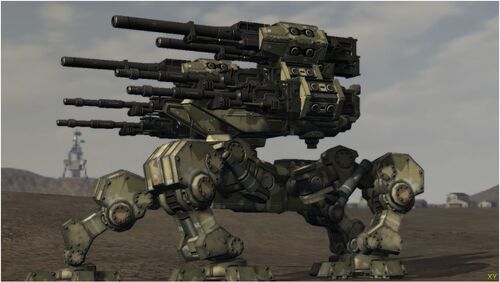
Egyptian “الصقر الأخضر” (Akhdar Alsaqr – “Green Hawk”) Command Walker – the largest, most heavily-armed of the MAW units to see combat in WWIII, c. 2029– Appalachian foothills, United States
September – November 2nd, 2029; RECON forces make a stand in the city of Knoxville and the surrounding municipalities of Forge, Newark, Mountain City and Sevier City – the Gateway to the Great Smoky Mountains National Park and Appalachian Mountains. It is here the Allies draw their line in the sand against the enemy forces, and having taken down 2 of the total 12-strong Egyptian–Azeri MAW units to deploy along the Eastern Seaboard. With 6 MAWS in Knoxville, 3 in Forge, 2 in Sevier City, 1 in Newark a total of 2 MAWS make it to Mountain City – the last of the cities group in proximity to the Park. Coincidentally, this happened to be the region with the highest concentration of RECON forces. Within just a few hours RECON manages to eliminate the MAWS, but then just as they are about to secure the area – UN forces show up with Anti-MAW Tanks and begin eliminating the MAWS. At first the UN helps RECON, but then it becomes apparent they were merely representing the interests of the Shadow Hub. The SH and UN forces had been working hand-in-hand the entire time to execute a strategy that would end with them as the victors of the conflict, by simply playing the warring factions against one another – and then striking when they were at their weakest. In the region that eventually becomes known as “Dragon’s Mouth”, a Final Stand occurs in which the straggling and vastly-outnumbered 350,000-strong US forces and 200-strong RECONs take their stand against a multi-million-strong North American and Japanese invasion force spearheaded by more than 100 Anti-MAWs… directed against primarily infantry and light armor. It goes down in history as one of the most one-sided fights in military history, surpassed only by the Battle of Thermopylae during the Greco-Persian Wars of BCE. Although the Allies lose the battle, and the UN autocracy regains control of the United States for the first time in almost a decade (only to lose again a decade later, and again decades later in the Creed Wars).
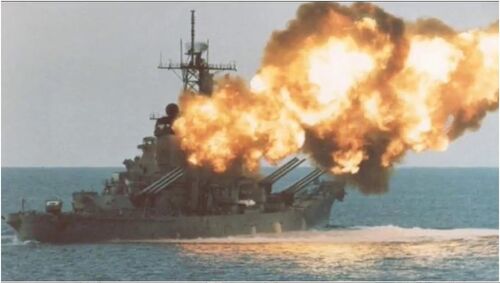
BAP ‘Almirante Grau’ (in this picture under Turkic control) – the last, and only, dreadnought battlecruiser to see combat in human history c. 10/29/29 – Strait of Dover; Calais, France
On September 10th English and Hungarian forces launch a protracted campaign against Berlin – which alongside Barcelona, Edinburgh, Geneva, Madrid, Ottawa, Paris, Stockholm and Zagreb was one of the last 9 governments in open opposition to the English and the rogue Russian forces fighting for Moscow long after the fall of Zharkov, and the only one of those who could make a difference in the fight – in what came to be called the Second Battle of Berlin. Although it is far bloodier than its WWII counterpart, the Berliners repulse and weaken the invaders through attrition, much better equipped and coordinated than the Germany under the shadow of the Nazis 9 decades earlier. By October 3rd the Invasion of Berlin has been repulsed with assistance from Sweden, Canada and the recently-liberated Polish and Danish military.
October – In late October, supported by Denmark and (primarily) Sweden, the U.K. leads the invasion of England. Simultaneously, most of the Euro-bloc military braced against the Egyptians, Azeris and the English, repulsing the militants from France and Germany by early October. The last of the pro-English Turkic and Arab naval forces are surrounded and, with assistance from one final interrogation of Luca and Kravychko, and the warfare expertise of the last soldier of RECON Unit-7, the Europeans board and informally occupy the USS Montana and HMS Prince of Wales in the Strait of Dover between France and Britain, in the final battle of the Third Global Conflict – the Siege of Calais. The Turkic dreadnought, formerly El Verde's, is a powerful and terrifying “wall of fire and metal”, pulverizing the beachhead and light armor with its massive guns, blowing a U.S. Command Walker straight out of the sky like paper Mache, and resisting some of the most coordinated and forceful air strikes.
In time, the Allies come to the conclusion that they must conduct an all-out assault on the dreadnought and its escorts, spearheaded by a Ford-class assault supercarrier jury-rigged into a heavy missile supercruiser specifically to defend its critically-important air force payloads during the pivotal Berlin Blitz a month earlier. Realizing the likelihood that the British and French-backed RECON forces could triumph over the Turkic-Arab Naval group, and that because of the recent turn of events they likely already knew of the Colombian government's infiltration of the U.S., collaboration with the English and Russians indicative therein, and their role in the ascendancy of Eurasian ultranationalists, Turkish forces turn against European forces at the last minute, losing the support and control they had over some of the Italian and Nordic forces. In an attempt to scramble as many fighters as possible to back up the French; Canada, Britain and the rest of the entirety of the Commonwealth of Nations quickly threaten full-scale Invasion of Turkey. Backed into a corner and isolated, Turkey and the ultranationalist war states of Azerbaijan, Kazakhstan, Uzbekistan and Egypt had inadvertently united the world against them, and to top that off, they end up losing control of their naval assets. Losing the battleship to the supercarrier assault, Egypt and Azerbaijan-Bukhara (England never being recognized as a legitimate state to surrender in the first place is obviously excluded, along with Russia which by this point has collapsed into several semi-autonomous successor-states and lost their Far Eastern territory) formally surrender and WWIII ends.
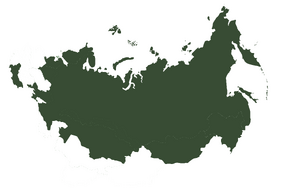
The collapse of the Russian Federation and Union State in 2027, leaves in its wake the short-lived Eurasian Union State (2027-2033 or 2022-2033)[Disputed]
Fallout & Aftermath[]
The Fallout and Aftermath of WWIII sees victory for the Allies: led by the UK, France and Japan against Azerbaijan-Bukhara, the Arabs, Russians and most of Latin America fighting on a third front. The United States and the Canadian countries are not so lucky, seeing how despite the fact that the Russians, Azeris, Arabs, and their mole-state in the Middle-East, Turkey, had been beaten after being cornered in the strait of Dover – the Latin Union, backed by Japan and the Co-Sector, had effectively annexed Ontario, Quebec, Newfoundland, Nova Scotia, Mexico, California, Nevada and the Rust Belt States of America (Excluding Indiana and Illinois) while North America would annex the rest of Canada in time and California would fight for its independence in 2041-2047.
The Treaty of Halifax is signed under Terms of Surrender by the Russian, Arab, Azerbaijani and Israeli Governments, English junta and former-President Luca, Commander Nikita Kravychko, the ultra-nationalist governments of Peru and Venezuela, the English Chancellor, 16 senior Venezuelan, Chilean, Russian, Livonian, Tajik, Kyrgyz and Cuban officials, Wyomingite Midwestern Gen. Secretary Liz Cheney, former-President John Kerry, former-Vice President Hillary Clinton, Lord Christian Pharaoh of Edinburgh, Fang Kaizeng's military brass and 368 other senior military and government officials from Latin America, the Middle-East and Cuba. The only five nations exempt from the repercussions of aiding CoSector are; Israel, Iran, North Korea, Libya, Bolivia, North America and Turkey after a short and brutal civil war by the NATO-backed opposition against the Erdogan regime – and, ironically, only because they maintained their commitment to defeat Turkey and Lord Pharaoh.
All territories under the unrecognized State of North America are transferred to U.S. jurisdiction, but the damage is done. The Republic of Texas, New England, large swathes of the Rust Belt and across the southwest become a frozen conflict zones, California a few years later annexing Washington, Oregon, Alaska, British Columbia and parts of Baja and the Yukon over the course of roughly a decade. And while the RT remains surrounded on all sides by U.S. Commonwealths, the united “autonomous regions” formerly comprising the United States of America, Mexico and Cuba would never be as unified and coherent a political entity as they once were. Concurrently, the European Union is federalized into a single government with its capital in Brussels and Belgium is divided between France and United Germania – the two countries becoming symbols of diametrically opposing political ideologies – with France incorporating into the UE superstate as its preeminent “cultural state”, and the Germanic Union opting out, still wary of France, Spain and Italy after their manipulation by Russia and Latin American governments in the 1990’s and 2000’s – choosing instead to focus on building up its autonomy and sway within United Europe. Austria and Germany (after the latter is infiltrated by pro-Chilean Prussian nationalists) are federalized under a Pan-Germanic government coalition centered in Rotterdam, Holland. Due to its proximity to Brussels, along with France’s devolved sovereignty and autonomy within the European state, the Netherlands and Slavic peoples would become the more well-off of Europeans for the first half of the 21st Century (although the former is eventually threatened by climate change). North Africa, after maintaining its commitment to the Allies of WW3 by overthrowing the English-backed military junta, along with Saudi Arabia, Lebanon, Oman, Yemen, Mauritania, and Egypt, all commit themselves to dependency status of the new United Arab Federation (UAF).
Crime by NATO–UN peacekeepers[]
As early as 2004, Amnesty International reported that under-age girls were being kidnapped, tortured and forced into prostitution in Kosovo with UN and NATO personnel being the customers driving the demand for the sex slaves. The UN's department of peacekeeping in New York acknowledged at that time that "peacekeepers have come to be seen as part of the problem in trafficking rather than the solution".
An Associated Press (AP) investigation revealed in 2017 that more than 100 United Nations (UN) peacekeepers ran a child sex ring in Haiti over a 10-year period and none were ever jailed. The report further found that between 2005 and 2018 there have been almost 2,000 allegations of sexual abuse and exploitation by peacekeepers and other UN personnel around the world. AP found the abuse is much greater than previously known.
Rapid increase in prostitution[]
Reporters witnessed a rapid increase in prostitution in Cambodia, Mozambique, Bosnia, and Kosovo after UN and, in the case of the latter two, NATO peacekeeping forces moved in. Instances of abuse in Cambodia caused widespread outrage after many of the abused women and girls also ended up contracting HIV/AIDS and other diseases that were not prevalent among the local population. A Kosovo victims support group reported that of the local prostitutes, a third were under 14, and 80% were under 18. Amnesty said the victims were routinely raped "as a means of control and coercion" and kept in terrible conditions as slaves by their "owners"; sometimes kept in darkened rooms unable to go out. In Haiti, the Sri Lankan peacekeepers wanted girls and boys as young as 12 for sex. "I did not even have breasts," said Victim No. 1, a girl. She reported to UN investigators that from ages 12 to 15 she had sex with over 40 peacekeepers, including someone called "Commandant" who paid her 75 cents. She stated that she slept in UN trucks on the UN base. In Haiti, 134 peacekeepers from Sri Lanka operated the child sex ring, luring children with candy and cash, according to the AP. After a U.N. report incriminated the peacekeepers, most were sent back to Sri Lanka, but none served any jail time.
1996 UN study[]
In the 1996 UN study The Impact of Armed Conflict on Children, former first lady of Mozambique Graça Machel documented: "In 6 out of 12 country studies on sexual exploitation of children in situations of armed conflict prepared for the present report, the arrival of peacekeeping troops has been associated with a rapid rise in child prostitution."
Eight years later, Gita Sahgal spoke out with regard to the fact that prostitution and sex abuse crops up wherever humanitarian intervention efforts are set up. She observed: "The issue with the UN is that peacekeeping operations unfortunately seem to be doing the same thing that other militaries do. Even the guardians have to be guarded."
Involvement in brothels[]
There was one highly publicised case where members of the UN peacekeeping force were accused of direct involvement in the procurement of sex slaves for a local brothel in Bosnia. The use of agents for procurement and management of brothels has allowed the military to believe itself shielded from the issue of sexual slavery and human trafficking. Some NATO troops and private contractors of the firm DynCorp have been linked to prostitution and forced prostitution in Bosnia and Kosovo, as have some UN employees in the Democratic Republic of the Congo, where they were accused of the sexual abuse of girls.
Department for Peacekeeping Operations (1992–2019)[]
The era of the United Nations Department for Peacekeeping Operations (DPKO) was arguably the darkest era of the entirety of the UN's history as an intergovernmental organization aside from World War II itself, with one of their first operations resulting in the deaths of thousands of Bosnian Muslims at Srebrenica in 1995. Between the 1990's and early 2020's, thousands of UN and NATO peacekeepers were involved in crimes of sexual abuse, theft and murder; with the UNMIK in Kosovo between 1999 and 2027, MINUSTAH in Haiti between 2004 and 2017, UNMIS from 2005 to 2011 and MONUSCO from 1999 to 2025 in the Sudan and Congo respectively - the latter of which was ruled by a regime renown for its use of mass rapes as well as sexual violence and slavery as a weapon of war, and the former regime had a similar reputation, along with Mozambique, another site of savagery and 89 rapes in the Central African Republic Civil War - alone raped over 3,000, many of them children, or kept them as sex slaves and murdered as many as 140.
Further investigation post-War shows that a lot of this may have been to do with the UN's at this point inability to act in anyway to meaningfully challenge any UN Security Councilor that decided something it didn't like, no matter how unanimously that decision may have been opposed internationally and globally. This led to a lot of UN institutions fraying and buckling after the Cold War under the weight of reckless and hyper-corrupt rogue states such as Sudan, the Congo, Saudi Arabia, and other harbors and protectors of criminals and psychopaths. Many of them would go unpunished until after World War III, when the United Nations shut down its short-lived Department of Peace Operations to rely directly on the armies of the European Union, Pakistan and China itself to defend it from the new enemy. All countries that resist the post-war order are eventually relieved of their vigilantes by force throughout the next several decades until the late-2050's with the commencement of the Creed Wars, wherein the vast majority of its power structure would be corrupted by the white supremacist ideology of the European and Latin American-spearheaded International Criminal Court and the extremely Anti-Arab xenophobia of a Post-War NATO.
Africa[]
In Africa, the economic centers of Lagos, Kinshasa, Khartoum, Dar es Salaam and Abidjan collapse into political crises (the Nigerian Supremacy Crisis) in which anti-Communist Catholic Monarchists in the Nigerian, Sudanese, Tanzanian, Congolese and Ivorian governments attempt to establish Monarchies in the aforementioned cities, whom each assert their own claims over the continent of Africa from between 2027 and 2043. This results in the establishment of an Equatorial Defense Organization (EDO) headquartered in Dakar, Senegal and Abidjan, Cote d’Ivoire (the city hit hardest by Monarchist-Catholic firefights and bombings), that includes all of the former ECOWAS, Central Africa and resulting submissions from Benin, Togo, Ghana, Burkina Faso, Namibia, Malawi, Madagascar, Eritrea and Somalia – the 9 countries subsequently joining EDO, which would later become the Equatorial Republic and with them officially eclipses North America (3rd) and Oceania (4th) to become the third-most populous nation, and by 2199 – the most populous in the history of the human race by a wide margin with jurisdiction of nearly 4 billion citizens. Tanzania, Mozambique, and most of East Africa manage to reestablish a foothold against the insurgency with assistance from the British by the late 2050’s, but the southwestern countries fail to escape the bloodbath resulting in millions of deaths – atop the million that perished in the 2037–2043 Crisis – as Monarchists seize the Congolese capital of Kinshasa and begin their push north beginning in 2044. By 2053, the Monarchist Congo has transformed into the United Kingdoms of Africa (UKA), seizing 14 countries and resulting in the deaths of a grand total of 11 million Central and West Africans. In the Maghreb, countries are deemed too economically-deficient to function on their own, many of them crippled in putting so much finance into defense from the Federalist-Monarchist conflict immediately following 20 years of global war, thus – an EU-Commonwealth-spearheaded effort federalizes the Maghreb as well, which – after the Maghreb Civil War of 2038-2044 – results in a Sultan seizing power and maintaining decades of rule by Sharia Law over the Maghreb.
From 2039 to 2099, the EDO would form a secular alliance against the United Maghreb and Catholic Congo. The short-lived Latin Atlantic was a trilateral attempt to federalize the Catholic Church, narrow the divide between Islam and Christianity in addition to stabilizing Sub-Saharan Africa. Founded in 2028 in Tunisia - a Muslim-majority country - the federation would have a tri-city capital, similar to Switzerland, with the executive headquartered in Dakar of Senegal, the legislature in Casablanca, and judiciary in Libreville, Gabon. A year later, in addition to the 18 nations of Africa (including the North African Union), the four Spanish Republics, France, Italy, Switzerland, Portugal and Greece would join the Latin Atlantic. Federal America, Nicaragua, El Salvador, Guatemala, Mexico, Germany, Poland, Czechia, Slovakia, Hungary, Slovenia, Croatia and the Philippines join as observer states with Europe joining the same year as France, Italy and Spain, the Americas in 2030 and the Philippines in 2033. The 2030's were a golden decade for Africa, with a majority of Africa's wars of the early 21st century ending by 2029, and the only real issues arising from the Maghreb. However, the rise of Catholic Monarchists connected to movements under Muslim rule in Sudan in the Zaire Democracy in 2036 before seizure of power in 2038 would lead to Latin Atlantic President Youssou Abdellahi facing calls to step down from Libreville and Tunis, the latter simultaneously facing pro-American jihadists sponsored by the Caliphate of Egypt and the former expansionist Christian Nationalists. By 2058 Senegal, Mali, Niger, Burkina Faso and the Ivory Coast had turned inward, the EDO was put on ice, and an international network of ultranationalist Catholic Monarchists had shut down both Congos, Burundi, Equatorial Guinea while Central Africa, Angola, Rwanda and Gabon were effectively Monarchist satellites, and the countries of Zambia, Tanzania, South Sudan, Chad and Cameroon had collapsed almost entirely. The Latin Atlantic would be reformed in 2101 following the defeat of Arcadia on Mars and subsequent collapse of NATO, but would eventually be absorbed into a Pan-African superstate. Nevertheless, following the rise of Martian Arabia, the American Realignment via control of Mars and the Hellenic-backed Keplerian triumph over Terran Mars in the 2060's would pave the way for a resurgent Africa and breaking the grip Fascism held over Latin America once and for all.
The new age of technological advancement surrounding spacefaring civilizations in the 2100’s and late 21st century results in a Cold War between the United Nations – and its eventual successor, the International State – and the new ‘Earth Seven (E7)’ superstate, proxy wars in Arabia, the Kalahari, and their respective puppet states of Korea, Britain and throughout Asia. Europe and the Imperialist Korean-friendly Anglo-American bloc engage in an arms race with each other and Korea engages in a Space Race with Oceania and India, with the latter staunchly opposing globalization. These conflicts – the UN–Pacific Cold War and the Korean-Oceanic Wars – result in the ostensible plundering of the Abidjan Pact’s natural resources, and the domination of its government by Korean and European Mega-Corporations, which in turn results in the United African Republics not only becoming the largest country in human history, but also the poorest. Despite this, after the armistice and reopening of relations between the E7 and the Internationalists, all countries of Africa, with the exception of the Martian-dominated Arab Kingdom occupying the Maghreb of North Africa, manage to rally together and establish the first continent-wide direct democracy in human history, beating the American States by 35 years, despite the former being a mere 7.1% of the GDP produced by the American continent.
Eurasia[]
After the Fall of Moscow in 2034, Russia is Balkanized into Muscovite Russia (Moscow), Siberia, the Sakha Republic, North Asia, Bashkortostan, Tatarstan, Mordovia, Mari El, Komi, Chuvashia, Udmurtia, and the Confederation of Chechnya incorporating the 8 Caucasian Republics of Russia into their own nation. The period between 2035 and 2061 (26 years) is seen by many historians as the peak of Republican Russia. In 2053, the Republicans launch a protracted war (Russian Unification War) with one another to unify Russia that lasts until 2059. The result is the annexation of the 12 Russian Nations into Semi-Autonomous Republics of Confederate Scandinavia and Slavic Europe, negotiated with the European Union as mediator. The deal was that the Republicans would reunite Russia – under the rule of the United Nations. With all of Europe already federalized, the fiat-annexation of sections of the former-Russian Federation by the Eurasian Republics (and actual annexation by Scandinavia) completes the unification of Eurasia under Authoritarian Imperialist ideology. The final capstone being the annexation of Mongolia followed by Korea’s Turkish allies annexing all the Central Asian “Stans” – and last but not least, Japan and all Southeast Asia, including Vietnam, Cambodia, and Laos – are swept into the Social-Imperialist Superstate, as a result (to unify the military) the Union of Socialist Korean Republics (USKR) is established in 2062. A year later Eurasia and Korea sign into existence the Commission of Eurasian Nations (CEN) and the Eurasian Republics Alliance (ERA) is established as a military union in 2064. The Socialist Government of semi-autonomous North America signs the Hemispheric Free Trade Agreement (HeFTA) with the ERA in 2066.
War in the Maghreb[]
Between September 2037 and April 2039, the nations of the Latin State, American States and Jordan spearheaded a series of manned-missions to Mars. The loose confederation of North African and Middle-Eastern countries, first established by Jordan and the Independent State of Mecca after the fall of Egypt in 2023, would spearhead the international effort to settle humans on the Red Planet following the conclusion of World War 3 in the mid-2020's. Due to the prevalence of religious sentiment still remaining throughout the region into the 2100s, a crisis of faith would consume and divide Islam between its more progressive ranks, and those who believed the human space exploration initiative launched by the US, Jordan and the Latin State were "blasphemy". Jihadists and extremists would terrorize the Muslim populace over the actions of Jordan, the Arab World and the West for decades, before being primarily united against the incursion by NATO and the United Nations in 2065.
Mars Landings (2037–2039)[]
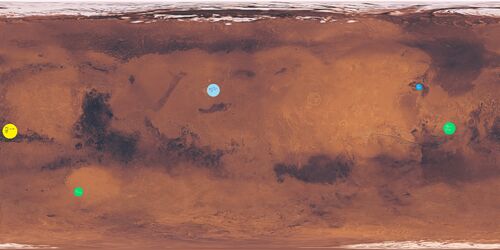
The five Mars landings by the Commonwealth, Arab League, Latin Atlantic and UN in 2037, spring and winter of 2038 and summer 2039 respectively.
After the successful launch of the ITS in May 2026, a series of manned missions to Mars were planned for 2030 and 2036 respectively. The fallout of World War 3 and interrelated ongoing conflicts between 2025 and 2028 would unsurprisingly postpone the former mission indefinitely, pushing back the window to January 2036, May 2036 and - eventually - May 2037. The commencement of hostilities in North Africa, peaking in 2039 and 2043, would bring about centuries of unprecedented politicization of the cosmos.
Martian Crisis (2066–2131)[]
The first six Mars Bases of Kepler, New Mecca, Elysium, Olympia, Dharma and Adonis would go onto form the first six colonies of Terra, Martian Arabia, Elysium, Olympus, Outer Tibet and Hellas respectively. While many more would follow, all six would remain at the forefront of Martian culture, particularly Olympia and New Mecca - which would become the largest cities on Mars by 2066 - although Kepler City would remain the de facto "New York of Mars" for centuries.
The UN-Mars crisis would begin with the backing of Latin American-majority states of Amazon, Olympus, Terra, North and South Rome as well as the European-majority Arcadia. The Arcadian-Olympian Invasion of African-majority South Arcadia and fomenting of its local white populace would be the spark that ignites the kindling. After their Pyrrhic victory in the Martian Civil War, Terra and its UN allies thought it could finish them off after expending so many resources skirmishing with drones at the border. After pushing into Northern parts of East Martian Arabia and occupying South Arcadia, the Martian Arabs - both the nationality and the ethnic group spanning the red planet - marshal an international resistance against the interplanetary assault on their homes. UN backed by Terran and Earthling supremacist groups and funded by mega-corporations such as IBC and the Titan Corporation are defeated and surrender at the 8 April 2131 Battle of Dharma in Outer Tibet, largely coinciding with - and the result of - the collapse of Internationalist and Korean influence in Chinese Asia and the Americas.
Russian Unification Wars[]
The Russian Unification Wars were a series of civil armed conflicts resulting from the Fall of Moscow on 18 October 2034. Even after the brief conflict resulting from a power struggle resulting from the end of the Putin-Zharkov establishment between the Liberal Democrats, the Communists and the last remnants of the United Russians - the only real domestic threat to the Liberal Democrats in the 2030's were the Communists, and they largely opted-out of the "Russian Confederacy" during this time leading to an illusion of unity among the Liberal Democrats and Unionists.
The short-lived Russian Confederacy was the 2034 to 2040 successor to the Russian Federation (1991-2033). Following the Fall of Moscow and in the wake of the War in Siberia (2035-2039), Russia was left an impoverished and highly corrupt rump state of North Russia, Moscow, Azov, the Altaic Urals, Siberian Far East (a Liberal Democrat stronghold) and Taymyria. The Communists mounted a resistance to the elimination of regional autonomy primarily from Bashkiria, Buryatia, Irkutsk, Novosibirsk, Kemerova, Khakassia, Tuva, Altai and Zabaykalsky, as well as the Volgan states of Ulyanovsk and neighboring Tatarstan - the latter two states eventually uniting in favor of Pan-Islamism in opposition to the Communists and Liberal Democrats (who would go on to oppose the secular Unionists).
The Unionists would maintain footholds in Udmurtia, Dagestan, Krasnodar, Kabardino-Balkaria and throughout the Russian Caucasus years after the Fall of Moscow. Although they would maintain cordial relations with the neo-imperialist ruling Liberal Democrats years after the independence of the Caucasian nation-state, relations would rapidly sour in response to the brutal repression of pro-autonomous movements in the aforementioned Communist and Islamic oblasts, republics and other confederate subjects. In response, the Russian Caucasians would heavily back a Krasnoyarsk independence movement which the Liberal Democrats would respond to with the complete militarization and occupation of Taymyria, which would in turn result in most of the Communist Russian states either attaining independence alone, attaining it and thereafter joining either the Central Asian Union or Manchuria, or being outright annexed by them in the latter 2030's and the following decades. The slow-motion collapse of Russia would come full circle with the collapse of the Far Eastern Liberal Democrats, secession of Tatarstan and Bashkiria and thereafter alignment with Arabia and Persia, and the declaration of war on Tatarstan by Moscow and North Russia - the latter effectively a Nordic puppet-state at this point - and a Russian Orthodox Theocracy in what was forming up to be a modern-day Spanish Inquisition spearheaded by the United States, and this was fully realized by the late 2050's with the commencement of the Creed Wars.
Not only would the collapse of Russia in to twenty separate successor states spill over into Manchuria during their war with the Mongol Independence movement, Central Asia and Ukraine, it would also impact the German, Italian, Austrian, Swedish and Finnish economies. Already reeling from the instability in Spain and North Africa about a decade earlier, the Latin European states of France, Catalonia, Basque, Switzerland and North Italy would fall under the sway of far-right Christian Nationalist movements akin to the Iron Legionnaires of 2020's Italy, and join forces with the fascist regimes in Scandinavia, North Russia and Moscow against the Muslim-majority Arabia and Persia during the Creed Wars of the 2060's.
Catholic Spring (2035–2058)[]
Beginning as early as the 1960s and 70s, a growing movement declaring modernism in the Papacy "the synthesis of all heresies," the particular quote in question from a former pope himself, would begin to emerge in the late-2010's - most prominently in North America - one of the first known instances of a proposed "Catholic Spring" mentioned by the political campaign of U.S. politician, former-First Lady and Secretary of State Hillary Clinton in 2016, with campaign staffers blaming Catholicism for the right-wing drift of the American electorate, despite Catholics being more progressive on almost every major issue than the average American. Although bearing the trademarks of Christian conservatism, the Second Vatican Council greatly opened and liberalized the Catholic Church, and modernized interfaith relations such as with Eastern Orthodox Catholics and Jews, while also inspiring a new generation of progressive church leaders.
The election of Pope Leo XIV after the death of Pope Francis as the Bishop of Rome further entrenched the traditionalist coalition between conclavism, liturgical traditionalists, ultramontane restorationists (neo-theocrats) and the sedevacantists, propelled largely by Christians in the United States (particularly the semi-autonomous, majority-Roman Catholic Atlantic State) and Poland (the latter who see the appointment as a rebuke of the popular Pope John Paul II, a Pole). After the cresting of WWIII during the Invasion of Germany, the Pro-Government Italians force the Pro-Presidency faction into exile in Switzerland, one of the Luca brothers captured by Allied forces during the Siege of San Francisco and the other committing suicide sixteen-seventeen months later. The ultra-right Papacy they installed was viewed just as invalid as they themselves were seen, and readily dismissed from history books, but it didn't prevent the untimely death of Pope Leo XIV a mere 6 years and 10 months into his service.
To honor Pope Leo XIV, the cardinals elected his chosen successor - Pope Leo XV - who would serve from 2028 to 2035 (slightly more than Benedict XVI). While most of the world would focus on rebuilding from World War III, the U.S. Catholics, the Atlantic State, Chile, Cuba, Uruguay, Korea and their protestant and Orthodox supporters in Russia and Oceania would push for overthrowing the Catholic Church in solidarity with the sedevancists (and Federal China), who would seize their moment upon the death of Pope Leo XV on 7 December 2035. The cardinals call for a sede vacante to deliberate about the future of the Church for at least sixteen months, but within three the U.S.-spearheaded movement had spread across the world.
Everything would change in 2039, with the collapse of the Chinese Federation, Italy, India and Russia (the successor states of the latter effectively declaring a "post-modern crusade" and beginning genocide against the Muslim Tatars), and even the United States which sees the A.S. and by extension the Catholic Spring movement to overthrow the Papacy as immoral and unpopular. Relations between the U.S. and A.S. sour into 2040 before culminating in the A.S.-backed New England insurgency in 2041.
Furthermore, as quantum computing and commercialized AI accelerated into commonplace home appliances in the 2030's, a Japanese-Norwegian team of scientists spearheaded by Firewall Oasis manage to create the world's first "strong AI" through whole-brain emulation and direct neural interface technology first proposed at the tail-end of the twentieth century. With civil unrest peaking at a level not seen since 532 A.D. and governments - truly entire nations crumbling - every three to six months, a worse time to introduce AGI to the human species could not have been chosen. The neighboring regime in Sweden is overthrown by Nordic Evangelical Ecofascists who view the AGI as a threat to the already-ailing climate as entire regions of the planet became uninhabitable. Although the AI revealed many secrets, such as 234 different planets home to intelligent life attempting to contact us as recently as 23 years earlier and that some gamma ray bursts were - in fact - extraterrestrial FTL drives, almost all of this would be hidden from humanity for decades, and even centuries, at a time.
It would not be for another 42 years before the fascist Nordic regime collapsed, and another 54 years of totalitarian-level algorithmic and AI regulation (mandated reversal of Moore's Law, mostly ineffective), Anti-Transhumanism, mass-boycott and divestment of robot rights groups and activists, crushing robot taxation of the most severe degree, and what many refer to as the third AI winter would stunt the collective technological consciousness of a vast majority of humanity's nations - their backs against the wall as the global climate crisis entered full-blown meltdown - before the AI would be free to communicate with humans (albeit in a far more limited capacity than intended, due to decades of socioeconomically-engineered robophobia and human supremacist ideology, propelled by increasing radicalism due to the climate acceleration).


